https://www.blackgate.com/
Half a Century of Reading Tolkien: Part Five: From the Beginning — The Hobbit by JRR Tolkien
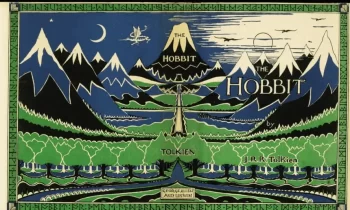 In a hole in the ground there lived a hobbit.
In a hole in the ground there lived a hobbit.
Chapter 1, An Unexpected Party – The Hobbit
Fifty years ago, when I first read this book, I didn’t imagine I’d still be reading it so many years later. Heck, I doubt I could have even imagined being as old as I am now. But I do reread it every few years. When I revisit The Hobbit, my journey is bathed in nostalgia as much as with the simple enjoyment caused by reading a charming book that I happen to know inside out, from the opening line above on through to the very end.
In my initial article on half a century of reading Tolkien back in January, I described my dad trying to get our first color tv in time to watch the Rankin & Bass The Hobbit. Remembering that again last week left me thinking more of my dad, now gone nearly 24 years, than the book. He was ten years younger than I am now when the movie first aired, which makes me feel incredibly old at the moment. For such a conservative man, he was excited to see it — admittedly, in a restrained way. I think we liked it well enough, but leaving out Beorn irked us both. Beyond Tolkien’s books, our fantasy tastes rarely coincided (I’ve got a shelf full of David Eddings books he bought, if anyone’s interested), but with The Hobbit and LOTR, we were in complete agreement.
What’s there to say about The Hobbit here on Black Gate? Nothing, really. I imagine most visitors here have read it, many more than once, and have their own ideas on it. It’s one of the most widely read books in the world. Instead, I’m going to discuss some adaptations of the book. But first, a summary.
 Map of the Lonely Mountain by JRR Tolkien
Map of the Lonely Mountain by JRR Tolkien
Hobbits are Tolkien’s slightly comical take on the staid British country folk. Their homeland is so British in nature, it’s even called the Shire. They prefer comfort and predictability and tend toward stoutness. Bilbo Baggins, the only son of wealthy parents has settled into a very predictable and very comfortable middle-age. When Gandalf, a wizard known fondly for magnificent fireworks and less fondly for occasionally leading young hobbits off on some adventure, appears at his doorstep, Bilbo’s life takes a drastic turn. The wizard has come to bring Bilbo on an adventure. Despite the hobbit’s denial of any interest in such an undertaking, Gandalf leaves a mark on his door so a throng of dwarves can find their way their the next day.
The dwarves, led by Thorin Oakenshield, are survivors of the Lonely Mountain. Once a mighty and wealthy dwarven stronghold, one hundred and seventy one years earlier, it was sacked by the great dragon Smaug and its citizens killed or driven out. Save Thorin and one other, the dwarves are miners and smiths, not fighters. Still, the band is determined to reclaim their mountain and their treasure, despite having neither a plan nor the means to remove the dragon.
Succumbing to a repressed ancestral taste for adventure, Bilbo joins the dwarven company on its quest. Soon, Bilbo finds himself on the wrong side of hungry trolls, angry goblins, and, perhaps worst of all, Gollum.
Deep down here by the dark water lived old Gollum, a small slimy creature. I don’t know where he came from, nor who or what he was. He was Gollum—as dark as darkness, except for two big round pale eyes in his thin face. He had a little boat, and he rowed about quite quietly on the lake; for lake it was, wide and deep and deadly cold. He paddled it with large feet dangling over the side, but never a ripple did he make. Not he. He was looking out of his pale lamp-like eyes for blind fish, which he grabbed with his long fingers as quick as thinking. He liked meat too. Goblin he thought good, when he could get it; but he took care they never found him out. He just throttled them from behind, if they ever came down alone anywhere near the edge of the water, while he was prowling about. They very seldom did, for they had a feeling that something unpleasant was lurking down there, down at the very roots of the mountain. They had come on the lake, when they were tunnelling down long ago, and they found they could go no further; so there their road ended in that direction, and there was no reason to go that way—unless the Great Goblin sent them. Sometimes he took a fancy for fish from the lake, and sometimes neither goblin nor fish came back.
Just prior to his encounter with Gollum, Bilbo finds a plain golden ring, a Ring that will come to prove of vital importance in later years. After discovering it turns its wearer invisible, Bilbo uses it to his advantage to escape from the goblins, and to save the dwarves on several occasions, once from giant spiders and once from elven prison cells. Eventually, he even uses it to allow himself to engage in some dangerous banter with the dragon.
“Well, thief! I smell you and I feel your air. I hear your breath. Come along! Help yourself again, there is plenty and to spare!”
But Bilbo was not quite so unlearned in dragon-lore as all that, and if Smaug hoped to get him to come nearer so easily he was disappointed. “No thank you, O Smaug the Tremendous!” he replied.
“I did not come for presents. I only wished to have a look at you and see if you were truly as great as tales say. I did not believe them.”
“Do you now?” said the dragon somewhat flattered, even though he did not believe a word of it.
“Truly songs and tales fall utterly short of the reality, O Smaug the Chiefest and Greatest of Calamities,” replied Bilbo.
“You have nice manners for a thief and a liar,” said the dragon. “You seem familiar with my name, but I don’t seem to remember smelling you before. Who are you and where do you come from, may I ask?”
“You may indeed! I come from under the hill, and under the hills and over the hills my paths led. And through the air. I am he that walks unseen.”
“So I can well believe,” said Smaug, “but that is hardly your usual name.”
“I am the clue-finder, the web-cutter, the stinging fly. I was chosen for the lucky number.”
“Lovely titles!” sneered the dragon. “But lucky numbers don’t always come off.”
“I am he that buries his friends alive and drowns them and draws them alive again from the water. I came from the end of a bag, but no bag went over me.”
“These don’t sound so creditable,” scoffed Smaug. “I am the friend of bears and the guest of eagles. I am Ringwinner and Luckwearer; and I am Barrel-rider,” went on Bilbo beginning to be pleased with his riddling.
“That’s better!” said Smaug. “But don’t let your imagination run away with you!”
By hands other than their own, the dwarves find themselves rid of the dragon. This leaves them in control of the mountain and the treasure. Part of the treasure, though, is sought, not unreasonably, by the dragon’s slayer, among others. Dwarves, being dwarves — “dwarves are not heroes, but calculating folk with a great idea of the value of money” — have no intention of giving up one farthing of their hoard, and soon the stage is set for a great battle. Bilbo makes it home, but only after having to commit an act of great moral bravery. The hobbit who returns home is not the same as the one who left, which of course, will turn out to be of the greatest importance for Middle-earth in the years to come.
The first and best adaptation I’m familiar with is the audio version performed by Nicol Williamson for Argo Records in 1974. Lasting nearly four hours, it has the room to tell most of the story. I remember my mother bringing it home from the library and realizing how long and complete it was. I listened to all of it on a Saturday and loved every minute of it.
Williamson himself did many of the edits, removing the most of the ‘he saids.’ He used various regional UK accents to differentiate the various characters. Williamson was one of the great stage actors of the last century, possessed of an absolutely magnificent and captivating voice. I haven’t listened to all of Andy Serkis’ unabridged presentation of the book, but as good as what I’ve heard is, Williamson’s is still the winner. Here’s Part Two of Williamson’s version, starting with Bilbo’s encounter with a wonderfully ghastly sounding Gollum.
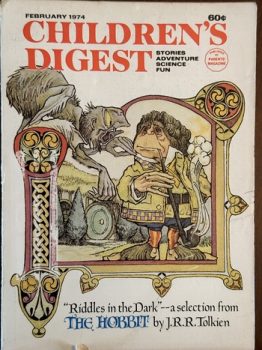 The video clip above of Bilbo and Smaug in the summary is from the second adaptation, the 1977 Rankin and Bass animated The Hobbit. The character designs were by Lester Abrams who had illustrated the Bilbo-Gollum confrontation for Children’s Digest. Arthur Rankin had seent he illustrations and liked them enough to engage Abrams for the movie. The animation was done by the Japanese company Topcraft (which would later go on to do Miyazaki’s first movie, Nausicaä of the Valley of the Wind, and become part of the foundation of Studio Ghibli).
The video clip above of Bilbo and Smaug in the summary is from the second adaptation, the 1977 Rankin and Bass animated The Hobbit. The character designs were by Lester Abrams who had illustrated the Bilbo-Gollum confrontation for Children’s Digest. Arthur Rankin had seent he illustrations and liked them enough to engage Abrams for the movie. The animation was done by the Japanese company Topcraft (which would later go on to do Miyazaki’s first movie, Nausicaä of the Valley of the Wind, and become part of the foundation of Studio Ghibli).
I love the movie, despite its too-rapid pace, the elimination of Beorn, and overall simplification. The painted scenery and backgrounds are wonderful, presenting Middle-earth in warm, muted colors. It looks at once realistic and fantastic. The voice acting, if not of Williamson’s caliber, is first-class, with Orson Bean as Bilbo, John Huston as Gandalf, Hans Conreid as Thorin, and, most wonderfully, Brother Theodore as Gollum.
 Map of Wilderland by JRR Tolkien
Map of Wilderland by JRR Tolkien
It’s far from perfect, but it succeeds better than anything else at conveying a sense of real wonder with each new encounter Bilbo has with the increasingly strange and dangerous denizens of the Wilderlands east of the Shire. Rankin had declared that there would be nothing in the movie that wasn’t in the book, and he proved largely true to his word. It also makes good use of Tolkien’s songs. I admit to not loving Tolkien’s songs and poetry in The Lord of the Rings, but in The Hobbit, he provides some solid children’s poetry and it carries over well in the film. That it remains a children’s film and not some tarted up action movie is its greatest strength. Bilbo is a likeable and brave, and the scary bits are just scary enough for young viewers. At 78 minutes, it’s also the perfect length to get exposed to Middle-earth and JRR Tolkien.
I haven’t much to say about Peter Jackson’s three, interminable, cacophonous movies save “I give up!” I feel like I watched them for penance for any and all sins I’ve ever committed and will yet commit. Martin Freeman is fine enough, if far too thin, as Bilbo, but everything else is awful. Instead of the episodic charm of JRR Tolkien’s actual book, Jackson delivered three movies totaling nearly eight hours of sodden, CGI-infested stuff, packed full of things JRR Tolkien could never have conceived of.
Like with his LOTR trilogy, the films diverge from their sources the further they move along. While the first, An Unexpected Journey (2012), largely follows the form and shape of the book, the second, The Desolation of Smaug (2013), adds an unbelievably poor romantic entanglement and hints of municipal corruption in Lake Town. The dwarves Rube Goldberg plan to encase Smaug in molten gold had me wishing I had more hair to pull out of my head. By the third chapter, The Battle of the Five Armies (2014), all bets are apparently off. Even though I hate Jackson’s desire to turn the the titular battle into a gigantic spectacle, I understand it. The shenanigans of the the Master of Lake Town, however, are awful and nothing anybody who’s at all interested in the fate of Bilbo and the dwarves will be at all interested watching.
Oh, and I haven’t mentioned the terrible-looking and slog that is Gandalf and the White Council’s battle with the Necromancer, aka Sauron. No more than a plot device to extract Gandalf from the story, Jackson turned it into a great, big thing. It was fun to imagine just what happened while reading the book, but on the screen, it’s just one more great big distraction from what should be the only focus — Bilbo and the dwarves. And bird crap-covered Radagast and his bunny-draw sledge is stupid.
The great thing about the Jackson’s movies is that you don’t have to watch them if you want some sort of theatrical presentation of The Hobbit. Just go listen to Williamson (or Serkis, if you prefer) or watch the Rankin and Bass. Both are clearly works of love and respect for JRR Tolkien’s actual book and almost as much fun as reading the book itself.
Next month, I think it’s a time for something special; a visit to the Harvard Lampoon’s tremendously funny and offensive parody (and excellent pastiche) of Lord of the Rings, the Harvard Lampoon’s 1969 Bored of the Rings.
Half a Century of Reading Tolkien: Part One
Half a Century of Reading Tolkien: Part Two – The Fellowship of the Ring by JRR Tolkien
Half a Century of Reading Tolkien: Part Three — The Two Towers by JRR Tolkien
Half a Century of Reading Tolkien: Part Four — The Return of the King by JRR Tolkien
Fletcher Vredenburgh writes a column each first Sunday of the month at Black Gate, mostly about older books he hasn’t read before. He also posts at his own site, Stuff I Like when his muse hits him
You Can’t Handle the Tooth, Part II
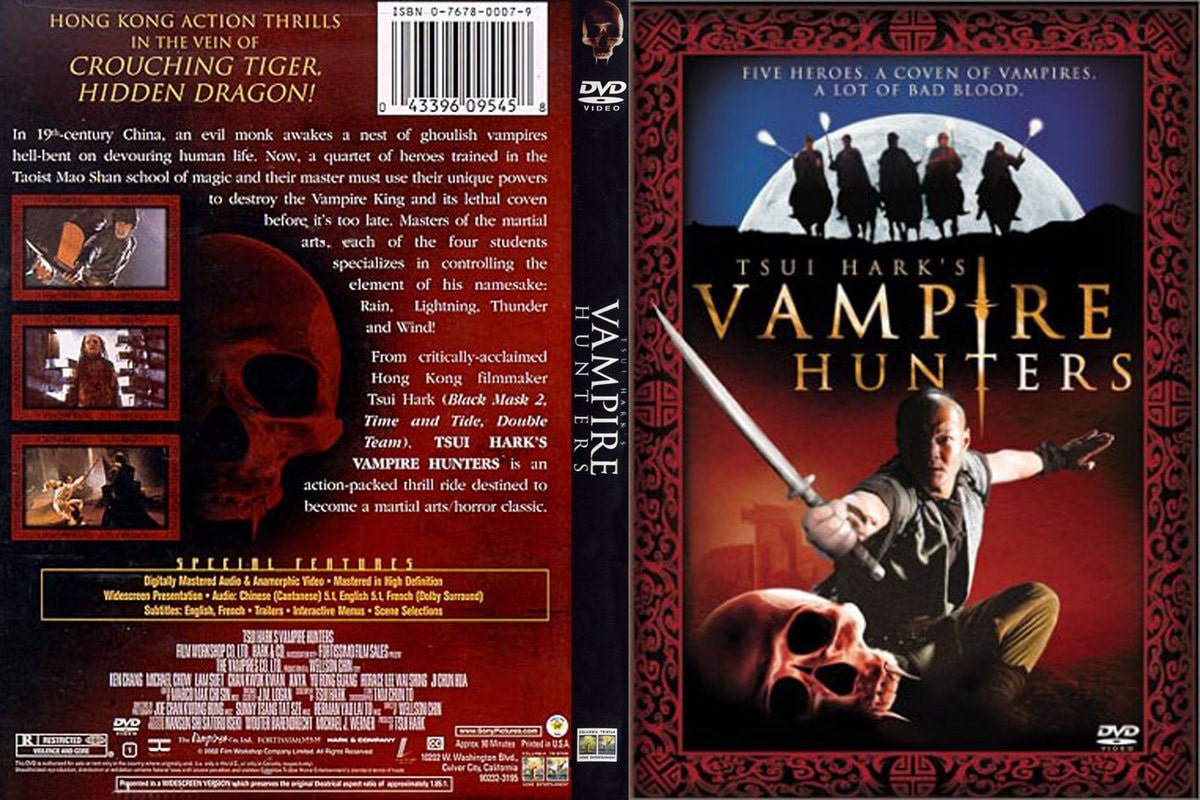 Tsui Hark’s Vampire Hunters (Film Workshop, 2002)
Tsui Hark’s Vampire Hunters (Film Workshop, 2002)
20 vampire films, all first time watches for me.
Come on — sink ’em in.
Tsui Hark’s Vampire Hunters (AKA The Era of Vampires) (2002) – PrimeThe original title is Era of Vampires, but for the North American release we end up with a spectacular bit of bait and switch trickery. Anyone who knows Tsui Hark’s work would be excited, after all, he gave us Zu Warriors from the Magic Mountain and the Once Upon a Time in China series — but we have been fooled. He produced this film, and wrote the story, but the director is Wellson Chin, better known for romantic comedies. For those of you who don’t know what this means, imagine going to see Steven Spielberg’s Jaws: The Legend Returns, and it’s directed by McG.
Anyhoo — the story is a simple one. Four Shaolin monks and their master have trained to locate and defeat vampires, but the first one they find manages to fend off 20 warriors and make the master go missing. The four (Rain, Wind, Lightening and Thunder) have a compass that points to vampire activity, and they track one to a wedding party. They infiltrate the home as party workers and try to find the monster. While all this is going on, there’s a separate band of robbers who want to find some hidden gold in the same domicile, the bride’s husband is killed, and the homeowner is covering any corpse he can find in wax. Naturally, threads and heads butt and much wire-work ensues.
The issue with this one is Chin really isn’t a very good action director. His shots are confusing and too close to the camera, and ultimately unsatisfying. There are some bonkers ideas, and the interaction between the monks is great, but overall it’s a bit weak.
One major highlight is the vampire itself — so nice to have a bloodsucker that can take on a gaggle of warriors instead of being easily staked by a surly teenager.
Check it out if you’re curious.
5/10

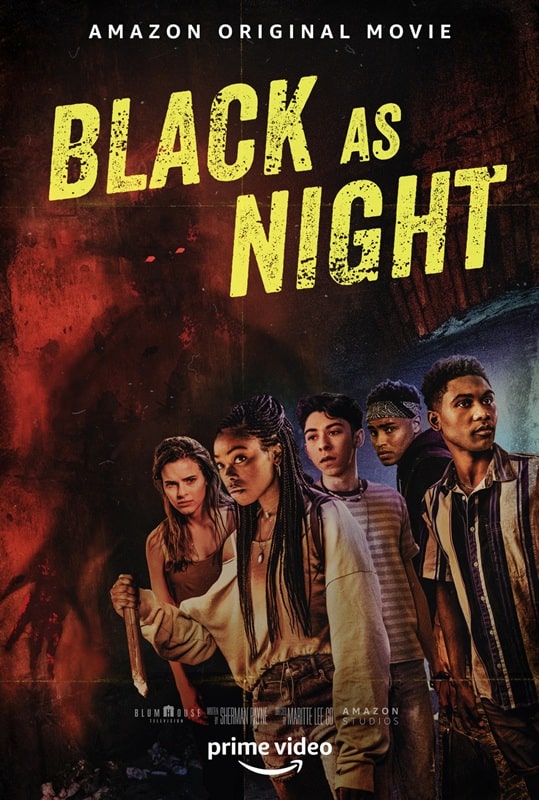
Vampie: The Silliest Vampire Movie Ever Made (Beautiful Rebellion Films,
February 14, 2014) and Black as Night (Amazon Studios, October 1, 2021)
Note, ‘Vampie’ is pronounced ‘Vam Pie’ as in ‘Meat Pie’.
I think we need to discuss the definition of ‘silly.’ When I think silly vampire movie, I think Mel Brooks’ Dracula: Dead and Loving It, or even Polanski’s Fearless Vampire Killers. A better alternative title for this one might have been Vampie: Mildly Amusing in One or Two Scenes. The rest of the time it’s a bit of a slog, hampered by a dodgy script and stilted line delivery. This is a shame, as writer/producer/star Ming Ballard and director Melissa Tracy have a potentially interesting concept, but not the chops (or budget) to make it work.
The story concerns Azure (Ballard), a centuries-old vampire who is allergic to blood. She runs a pastry shop with two friends, Tippy (Eric Strong), and Grace (Maya Merker, the highlight of the film).
Azure has a supernatural recipe item for a magical pie that she eats to stave off her blood hunger. When the pie ingredient is stolen by a rival vampire, she must get it back with the help of a Vatican assassin. That’s the plot in a nutshell.
Along the way, we get prolonged scenes of unfunny dialogue, unfunny flashbacks and a foul-mouthed chihuahua called Van Helsing. There are some moments of drama that are quite effective, but it was ultimately a chore to get through. Oh well.
4/10
Black as Night (2021) – PrimeHigh-schooler Shauna (Asjha Cooper, excellent), informs us via voiceover that what we are about witness is a crazy summer, one in which she got breasts, and killed vampires. This is no throwaway line in either respect. Shauna is 15 and riddled with anxiety, not only due to her own development, but the darkness of her skin (not helped by her brother who calls her Wesley Snipes in a wig), and her crush that she is too shy to talk to.
It’s a good way to start a film as her arc is clearly defined, but the main focus is shared between the vampires who prey on the homeless and addicted, and the after effects of Katrina, which continue to suck the very life out of the residents of this area of New Orleans. Part of the backdrop is The Ombreux, a rundown housing project that is home to junkies and the disenfranchised. This put me in mind of the Cabrini-Green inspired projects of Candyman, another film that explored the plight of black citizens framed with horror themes.
Many topics are explored in Black as Night through dialogue and one impressive speech by David Keith that touch on racism, gentrification, slavery and poverty, and these heavy issues are balanced with a frothy, Buffyesque romp featuring Shauna and her gang (best gay friend Pedro, crush Chris and vamp lit boff Granya). Moments actually put me in mind of Fright Night (inexperienced youths enter a forbidding mansion to kill bloodsuckers) and I enjoyed myself.
It’s not all great though, one villain was woefully underused, the narration started to outstay its welcome, and the actual horror was a bit lackluster, but overall, a solid film from director Maritte Lee Go, and I’m interested to see what she gets up to next.
7/10
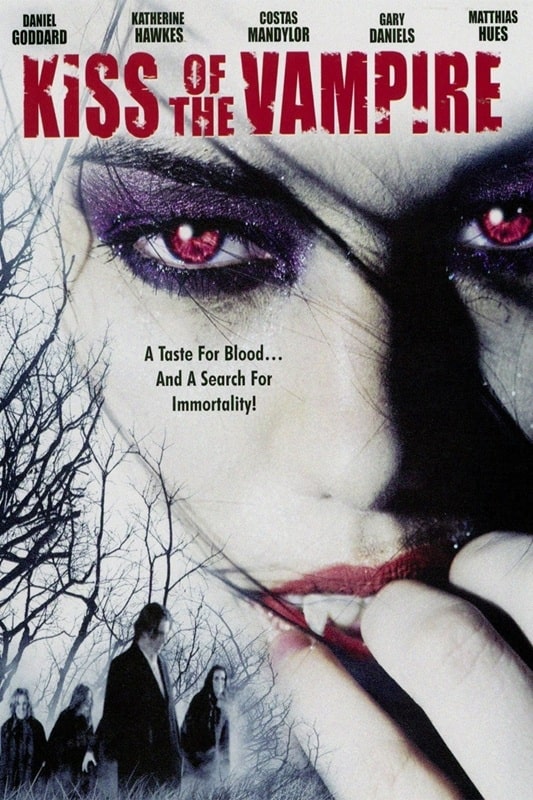

Kiss of the Vampire (Immortally Yours, January 6, 2009) and Renfield (Universal Pictures, April 14, 2023)
Ugh — we reach the halfway point and I want to chew my leg off.
I’ve stated before that I try not to rag too much on bad films, because I know first-hand how hard it is to make one (good or bad), but this one just annoyed the hell out of me. Despite having enough in their budget to lob a couple of thousand at Costas Mandylor (Saw series) and Martin Kove (everything else), the rest of the budget must have gone on craft services, because it definitely didn’t get spent anywhere else.
Especially not on sound. Scenes are barren and poorly miked, and the costumes came straight from Ruby’s Halloween bargain bin. The effects are tragic, the acting lacklustre and the story is nonsensical. I’m sure the actors were told they were making an epic based on Twilight and Underworld, with the Illuminati thrown in, but they ended up in a convoluted mish-mash of ideas, none of them concluded satisfactorily.
Avoid.
Or watch, if you’re full of self-loathing.
2/10
Renfield (2023) – PrimeA lesson to be learned here about getting your hopes up. I was pretty excited to see this one, as I desperately want Universal to have a hit (The Invisible Man is the only one they haven’t screwed up), and I love Nicholas Hoult, Nic Cage and Awkwafina (to a degree).
I knew going in that the tone would be irreverent, but I had no idea how slapstick they were going to go with the horror (an impressive blend of practical and CG), or that Cage was going to portray Dracula as if he was in Carry On Count.
I thought the concept was excellent (if a little flimsy), however I would have really dug a film closer in tone to Ready or Not or Werewolves Within. Everyone just needed to dial the lampooning down two notches. Ah well.
7/10

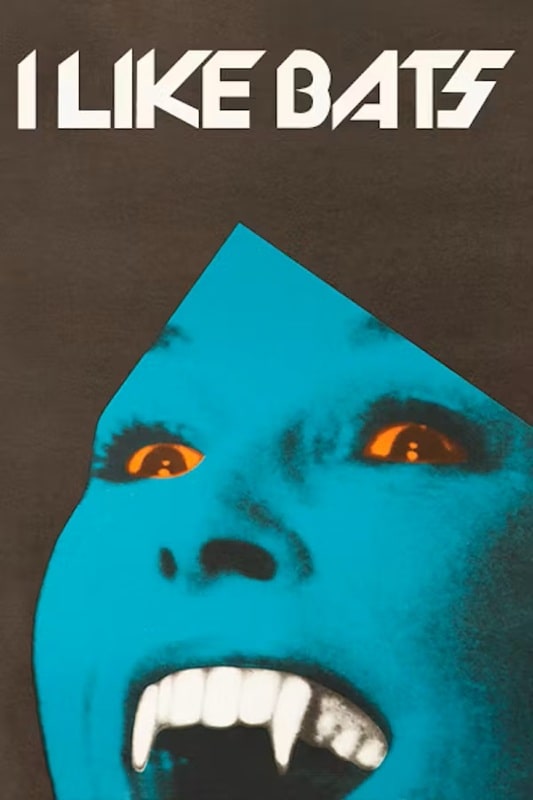
Vampires vs. The Bronx (Netflix, October 2, 2020) and I Like Bats (Zespół Filmowy, 1985)
Zoe Saldana is listed in the opening credits, and is gone after 2 minutes. Hey, it’s a good name to bait investors with, so fair play to them.
Vampires vs. The Bronx brings nothing new to the table, it evokes the kids vs monsters theme of Attack the Block and Lost Boys (even emulating Greg Cannom’s Lost Boys vampire makeup), makes several references to Blade (and copies its gnarly deaths), and is littered with in jokes (the realtor firm is called ‘Murnau’, and their logo is Vlad himself).
It might be derivative, but it also skips along at a fair old pace, helped by a charismatic group of child actors and a tongue-in-cheek script. The vampire front is a realtor company (headed by Shea ‘Skull Island’ Whigham) and the metaphors fly thick and fast as the Bronx rapidly succumbs to the soul-sucking practices of gentrification.
It’s fun, horror-lite, gateway fare for younger viewers who might be vamp-curious, and one of the few Netflix productions that doesn’t rely on green and purple gels. Worth a look if you’ve got a spare 90 mins.
7/10
I Like Bats (Lubię nietoperze) (1985) – PrimeIt’s off to Poland now, for a strange little film that can’t quite settle on a genre or tone. It’s a game of two halves, the first being the infinitely better one, but we’ll get to that.
Katarzyna Walter is Izabela, a vampire whose raison d’être seems to be ridding the world of scumbag men. General creeps, stalkers, would-be rapists, and murderers are first seduced and then sucked dry by Iza, whose overbearing aunt persistently complains about the lack of men in her life.
I enjoyed this half — with Iza in the role of avenging angel. It’s moody, gothic and beautifully shot. It also feels timeless — scenes of the contemporary town could be from decades before the mid-80s, and some clothing and vehicles feel anachronistic, but one character mentions AIDS, and we are jolted back to the correct setting.
The second half of the film is where things go awry. Iza checks herself into a psychiatric hospital in an effort to become human because she has fallen in love with the head doctor. They don’t believe her of course, however, she can’t be hypnotized or x-rayed and is soon biting the workers (her first victim is the lothario gardener who shags all the nurses in the tomato house). Then, all of a sudden, Iza is settled in domestic bliss. And that’s it.
A bit of a curio, recommended for certain types. Not saying who.
5/10
Previous Murky Movie surveys from Neil Baker include:
You Can’t Handle the Tooth, Part I
Tubi Dive
What Possessed You?
Fan of the Cave Bear
There, Wolves
What a Croc
Prehistrionics
Jumping the Shark
Alien Overlords
Biggus Footus
I Like Big Bugs and I Cannot Lie
The Weird, Weird West
Warrior Women Watch-a-thon
Neil Baker’s last article for us was Part I of You Can’t Handle the Tooth. Neil spends his days watching dodgy movies, most of them terrible, in the hope that you might be inspired to watch them too. He is often asked why he doesn’t watch ‘proper’ films, and he honestly doesn’t have a good answer. He is an author, illustrator, teacher, and sculptor of turtle exhibits. (AprilMoonBooks.com).
Tor Double #9: Isaac Asimov’s The Ugly LIttle Boy and Theodore Sturgeon’s The [Widget], the [Wadget], and Boff
 Cover for The Ugly Little Boy by Alan Gutierrez
Cover for The Ugly Little Boy by Alan Gutierrez
Cover for The [Widget], the [Wadget], and Boff by Carol RussoThe ninth Tor Double collects novellas by Isaac Asimov and Theodore Sturgeon, the only entries by either author. The Asimov’s story is The Ugly Little Boy and Sturgeon offers the oddly titled The [Widget], the [Wadget], and Boff. This volume is the first to include two stories that did not win, or even receive a nomination, for any awards. Leigh Brackett’s story in the previous volume wound up winning the 2020 Retro Hugo Award.
Theodore Sturgeon’s The [Widget], the [Wadget], and Boff was originally published in F&SF in November, 1955. The strange title is entirely fitting for the strange story Sturgeon has to tell. Just as two of the words in the title are framed by brackets, the story has a science fictional device framing it, in the form of a report by two aliens visiting Earth. In their report, which partly looks at whether or not “Synapse Beta sub Sixteen” exists in humans (and whether the species can survive without it), but also serves as an indictment of one of aliens by the other, the aliens set words in brackets when there is no exact English equivalent for what they are attempting to say.
The story framed by this conceit could have been published in any of the mainstream magazines. It tells the story of the residents of a boarding house in a small town. Bitty and Sam Bittelman run the house, which has gathered its fair share of misfits. Tony O’Banion is a successful lawyer whose privileged upbringing gets in his way, Mary Haunt is a movie star wannabee who is waiting for her break, Phil Halvorson has undefined issues, but seems to be either gay or asexual in a world which sees both as a perversion, Miss Schmidt is a school librarian who keeps to herself, and Sue Martin is a hostess in a nightclub. Sue’s three-year-old son, Robin, creates a connection between the characters.
Robin is an easy going child, whose happiness with the world around him causes most of the residents of the boarding house to adopt him. When his mother is sleeping during the day, the Bittelman watch over him. If they aren’t available, “Tonio Banion” tries to make time for him, taking him along of visits to a local amusement park where O’Banion provides legal services. Miss Schmidt cares for him at night when Sue Martin is at work.
Although Robin is not a view-point character in the story, Sturgeon does an excellent job of presenting his world view, from his mishearing O’Banion’s name as Tonio to his anthropomorphizing of kitchen appliances, such as Mitster (a mixer) or Washeen (the washing machine). Robin also has two imaginary friends, the titular Boff and Googie.
As the story progresses, Sturgeon’s focus on the residents of the boarding house slowly builds up the complexity of their relationships and personal problems. Many of the characters receive a spotlight, either as Sturgeon explores their activities or inner thoughts or when they have conversations with Bitty or Sam, both of whom have a tendency to ask probing questions of their boarders that make them reconsider their lives and choices. At the same time, Bitty and Sam are never shown as prying or anything less than nurturing.
The result is that even as their boarders begin to come to terms with the realities of their existence, either dreams that cannot be attained or the manner in which they are standing in the way of the own success, the story starts to feel more hopeful. Once their issues are realized, they are more likely to be able to take care of them. Throughout the story, reports from the two aliens who are watching them also continue to play a role, giving the indication that the growth of the individuals is caused, at least in part, by the “Synapse Beta sub Sixteen” the aliens are looking out for.
Boff and Googie are woven throughout the story, and while Robin is always aware of their activities and location, as imaginary friends, they are either dismissed or patronized by the adults in the story. The reader, aware that Boff’s name appears in the stories title, realizes that there is an importance to the characters and the manner in which the nature of Robin’s imaginary friends is revealed is clever and ties in quite well to his way of seeing the world through the eyes of a three year old.
Even if the revelations each of the characters have about themselves in response to the Bettelman’s questions can’t be considered a happy ending, each of the characters appear to be in a healthier place when the story ends, having come to terms with their position in life and finding a way to continue further in a way which will not leave them more damaged than they were at the beginning of the story.
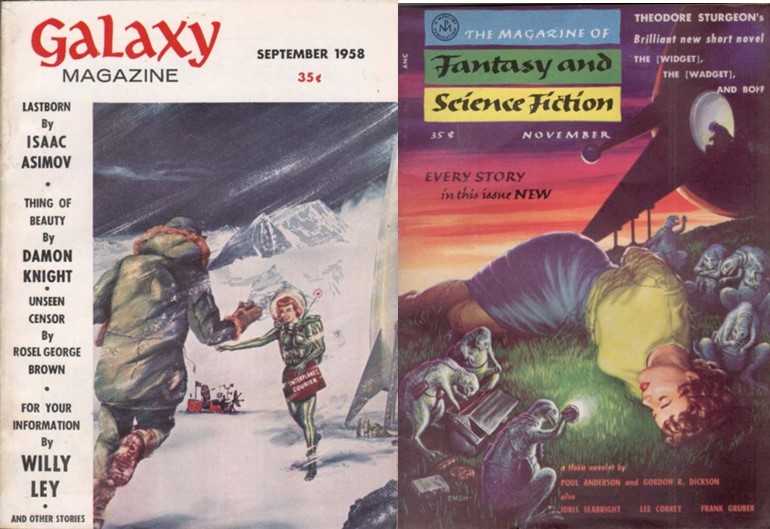 Galaxy Magazine September 1958 cover by Dember
Galaxy Magazine September 1958 cover by DemberThe Magazine of Fantasy and Science Fiction November 1955 cover by Ed Emshwiller
The Ugly Little Boy was originally published as “Lastborn” in Galaxy in September, 1958. It was nominated for the Hugo Award and the Nebula Award, winning the latter. In 1991, Robert Silverberg would publish an expanded, novel length version of the story, retitled Child of Time (although the American version of the novel would retain the title The Ugly Little Boy.
Just as three-year-old Robin is to center of The [Widget], The [Wadget] and the Boff, the titular boy in Asimov’s story is also three years old when his story begins, or at least in the flashback that shows how he got into the situation the story covers.
Edith Ffellowes is a nurse who has been hired by a company called Stasis, Inc. under the assumption that their first experiment, to bring a Homo neanderthalensis to the contemporary period. The CEO of Stasis, Inc., Gerald Hoskins, hires Ffellowes after a cursory interview in which he is mostly concerned over whether she loves all children or just pretty children. It isn’t until she shows up for the attempt to retrieve the child that she begins to understand the actual details of the job for which she has been hired.
Although Ffellowes is taken aback by the boy’s appearance when she shows up, she is a professional and works to take care of him, cleaning him up and attempting to engage with him despite the language barrier. By bringing a three year old rather than an adult, Asimov is able to ignore the cultural issues which would have arrived by bringing in a fully functioning member of Neanderthal society. It also gives him the opportunity to have Ffellowes attempt to educate the boy, who she names Timmie in a failed attempt to stop the press from referring to him as an ape-boy.
The primary purpose of Stasis, Inc’s, experiment was to bring a living creature from the Neanderthal period to the modern time, and they succeeded. The secondary purpose was to learn about Neanderthal culture and physiology. Although the latter was possible from their experiment, a three-year-old will not be able to teach them much, especially one who’s culture is infected by the teachings of a modern woman.
As the story progresses, Ffellowes works to socialize Timmie, including asking Hoskins to allow him to interact with a modern human boy of the same age. Although the initial meeting between Timmie and Hoskins’ own son, Jerry, does not initially go well, eventually the two build up a friendship of sorts, although there is always an undercurrent of tension brought on due to the differences between the boys and Hoskins’ own attitude toward Timmie. Although he generally says the right things to Ffellowes about her charge, he occasionally indicates that he sees Timmie a less than human.
Asimov’s focus with the story is on Ffellowes and the relationship she builds up with Timmie. Even as the world sees him as an ape-boy, she fights for his dignity and to teach him how to be a person. Asimov’s is less interested in the impact their relationship has on Timmie’s way of thinking, taking the point of view that there is no difference between a three year old Neanderthal and a three year old human are essentially the same, except for their physical appearance.
He also doesn’t seem to be overly interested in the ethics of Hoskins’ experiment. Hoskins’ questionable scientific ethics are apparent from the beginning, when he hires Ffellowes with only the briefest of interviews and without providing her with the information that she would need to make an informed decision. Throughout the experiment, he shows little more interest in Timmie than he does in the inorganic material Stasis also brings through, eventually attempting a similar experiment with a fourteenth century Italian, demonstrating that from an ethical point of view the company has learned nothing.
Written in Asimov’s clear style, it is similarly clear why Robert Silverberg expanded the story into a novel 34 years after its initial publication. The story is overly simplistic, offering hints and weighty issues that it could address. Similarly the understanding of Neanderthal culture advanced in the intervening years. Silverberg’s focus was more on the Neanderthal period than the ethical concerns regarding Hoskins and Stasis, Inc.’s methodology.
The cover for The Ugly Little Boy was painted by Alan Gutierrez. The cover for The [Widget], the [Wadget], and Boff was painted by Carol Russo.
 Steven H Silver is a twenty-one-time Hugo Award nominee and was the publisher of the Hugo-nominated fanzine Argentus as well as the editor and publisher of ISFiC Press for eight years. He has also edited books for DAW, NESFA Press, and ZNB. His most recent anthology is Alternate Peace and his novel After Hastings was published in 2020. Steven has chaired the first Midwest Construction, Windycon three times, and the SFWA Nebula Conference numerous times. He was programming chair for Chicon 2000 and Vice Chair of Chicon 7.
Steven H Silver is a twenty-one-time Hugo Award nominee and was the publisher of the Hugo-nominated fanzine Argentus as well as the editor and publisher of ISFiC Press for eight years. He has also edited books for DAW, NESFA Press, and ZNB. His most recent anthology is Alternate Peace and his novel After Hastings was published in 2020. Steven has chaired the first Midwest Construction, Windycon three times, and the SFWA Nebula Conference numerous times. He was programming chair for Chicon 2000 and Vice Chair of Chicon 7.
A Kind Heart and the Right Sort of Hands: Carbonel, the King of the Cats by Barbara Sleigh
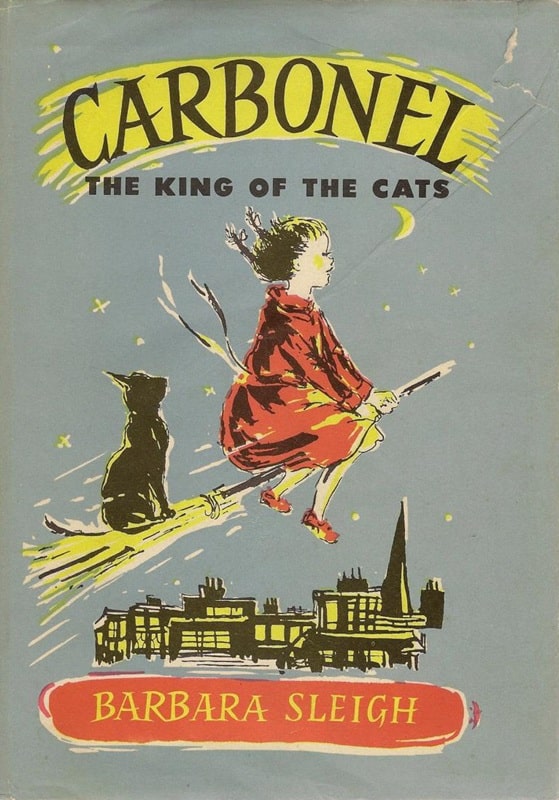 Carbonel the King of the Cats by Barbara Sleigh (Bobbs-Merrill Company, 1957). Illustrated by V.H. Drummond
Carbonel the King of the Cats by Barbara Sleigh (Bobbs-Merrill Company, 1957). Illustrated by V.H. Drummond
Over the past few years, I’ve started tracking down books I read as a child and still remember, to see what I think of them now. Some of them I’ve had to buy; but I live close to a university library, which still has others on its shelves. I just reread Barbara Sleigh’s Carbonel, the King of the Cats (illustrated by V.H. Drummond), originally published 1955, and enjoyed it enough to think it deserves a review.
Sleigh was clearly an aelurophile; this book is dedicated to one cat and to the shades of four others. I’m pleased that its feline hero, Carbonel, is a black cat (as his name suggests!) — a breed that doesn’t get as much love as it deserves. He has very convincing catlike manners, mixing condescension, sarcasm, and occasional affection. At the same time, he fits one of the classic story formulas, being a lost heir of royal birth, with a title that he hopes to reclaim.
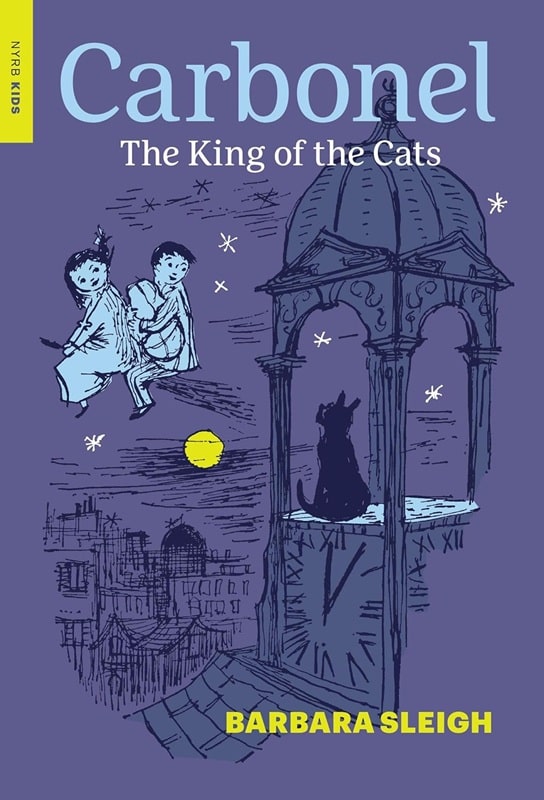 Carbonel the King of the Cats paperback edition (New York Review of Books, August 7, 2018)
Carbonel the King of the Cats paperback edition (New York Review of Books, August 7, 2018)
But the novel’s other hero is human: Rosemary Brown, a girl of ten, the daughter of a widow who supplements her pension by working as a seamstress. (Given the novel’s publication date, Rosemary’s father may well have died in the Second World War.) This is another classic formula, the child growing up under straitened circumstances — one that was still with us in Harry Potter and the Philosopher’s Stone (a much better title than the American Sorcerer’s Stone).
I have to say that Rosemary is more enterprising than Harry: When her vacation from school begins, she comes up with the idea of finding some sort of work to earn money at, in order to help her mother. (Though to be fair, there might have been far fewer obstacles to such a project in 1955 than in 1997.)
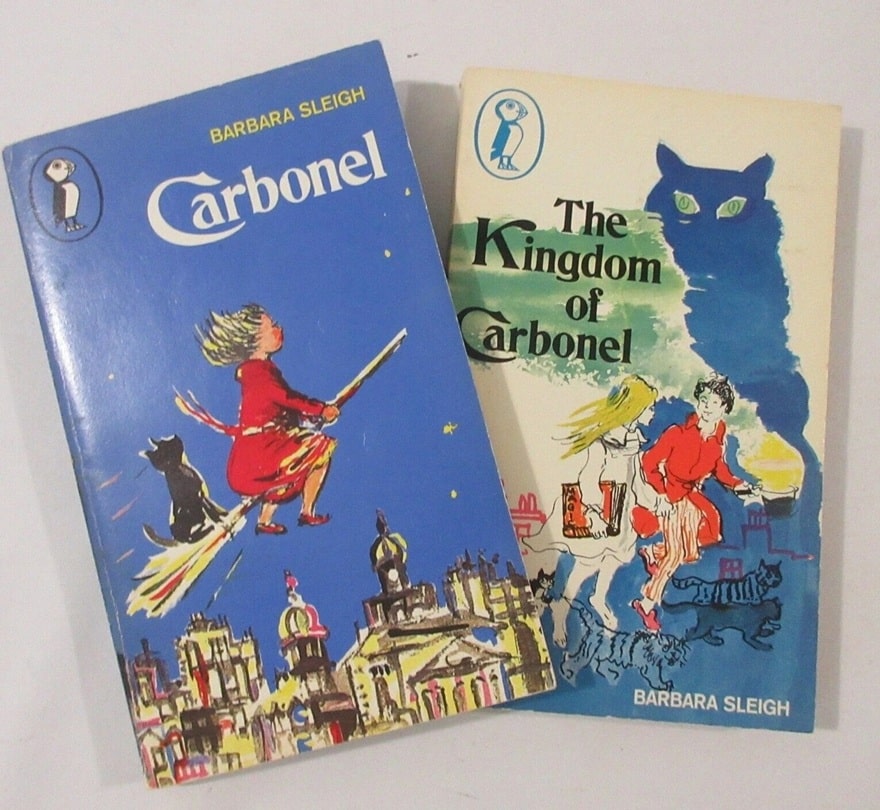 Carbonel and its sequel The Kingdom of Carbonel (Puffin paperback editions, June 1961)
Carbonel and its sequel The Kingdom of Carbonel (Puffin paperback editions, June 1961)
In any case, that’s where the adventure begins: Rosemary decides that she could earn something by cleaning and sets out to buy a broom with the contents of her money box. As it turns out, what she gets is a witch’s broom, and one that’s crudely made, with a bundle of twigs at the sweeping end, and on the verge of falling apart.
But she also gets the witch’s cat, with her last three farthing, and learns that the broom not only flies, but grants her the power to understand what the cat says to her. Unfortunately, it’s not suited for the kind of indoor cleaning Rosemary has in mind: It looks more like a gardener’s broom.
 Illustration by V.H. Drummond
Illustration by V.H. Drummond
But Carbonel, the cat, brings his own complications: He’s still bound by a spell the witch cast on him, and can’t reclaim his heritage and give the feline kingdom a proper ruler until he’s set free. And the conditions for doing so entangle Rosemary and her newly made friend John (the nephew of one of her mother’s customers) in a long series of complications.
I thought they were ingeniously worked out and had just the kind of odd magical prohibitions that are proper to a fairy story; and the resolution of Sleigh’s plot also resolves several other issues that came up earlier, from a small theatrical troupe’s troubles to the career of a retired witch. I really thought this book showed a lot of ingenuity in tying everything together.
 Carbonel the King of Cats
Carbonel the King of Cats
I was also struck by a point I missed when I read this as a child, because of the other things I hadn’t read: In one chapter John figures out something significant and cites a maxim of Sherlock Holmes’s to explain how he did it — one from “A Scandal in Bohemia,” the story that gave us Irene Adler. I don’t know if I would have understood a story about royal love affairs and potential blackmail when I was 10, and perhaps John doesn’t, either. But clearly at least part of the story stayed with him.
Sleigh does a good job both of making the reader sympathize with Rosemary, and through Rosemary’s own sympathy of making the reader sympathize with Carbonel. Both of them were entertaining characters, and they made me feel that my private project is being worthwhile.
William H. Stoddard is a professional copy editor specializing in scholarly and scientific publications. As a secondary career, he has written more than two dozen books for Steve Jackson Games, starting in 2000 with GURPS Steampunk. He lives in Lawrence, Kansas with his wife, their cat (a ginger tabby), and a hundred shelf feet of books, including large amounts of science fiction, fantasy, and graphic novels. His last article for us was a review of Dorsai! by Gordon Dickson.
A Hand-Crafted World: Karel Zeman’s Invention for Destruction
Is there anything more dispiriting than the ceaseless quest for novelty, especially when it seems bound to end in disappointment? It’s something I feel just about every time I turn on the TV. We’ve never had so many viewing choices, but so often everything feels reheated, recycled; we’ve seen it all before. The genuinely different is so rare that when you do see it, you know it — and you never forget it.
Sometime in the 70’s I saw an old black-and-white movie on television; it was called The Fabulous World of Jules Verne and it was the most extraordinary-looking thing I had ever seen. Guess what? I never forgot it.
A few years later I saw a movie on the late-night tube about the world’s greatest liar, Baron Munchausen. This time I couldn’t say that I had never seen anything like it because there was one thing that it reminded me of — The Fabulous World of Jules Verne. It was only years later that I learned that both films were the work of the Czechoslovakian director, Karel Zeman.
Zeman was born in 1910 in Austria-Hungary, and after spending most of his twenties working in advertising in France, in 1936 he returned to his home in what had become Czechoslovakia and began to work his way into the film business. He managed to survive both the Nazi occupation of his country during World War Two and the following grey decades of Czech subserviency to the Soviet Union, making films, both shorts and full-length features, that existed in — that created — a stubbornly non-political realm of beauty and humor and eccentric individuality. He died in 1989, shortly before the collapse of the Eastern European satellite regimes.
A few years ago, Criterion released Jules Verne under its original 1958 title, Invention for Destruction, along with 1962’s The Fabulous Baron Munchausen and another Zeman film, 1955’s Journey to the Beginning of Time, in a beautiful Blu-ray set titled Three Fantastic Journeys by Karel Zeman. It has a place of honor on my shelf, and it deserves one on your shelf, too, for Invention for Destruction alone; I guarantee it really is like nothing you’ve ever seen before.
Exactly what was it that I found so striking, so indelibly memorable about Invention for Destruction? What still makes it a jaw-droppingly unique movie, even after all the cinematic and technological innovations of the past seven decades? What made it the most internationally successful Czech film ever (a propaganda success that blessedly kept the cultural commissars off his back)?
Well, imagine that you’re looking at an old book, let’s say a volume of Jules Verne, lavishly illustrated with quaint nineteenth-century steel engravings. Now imagine that those obsessively, almost insanely detailed black-and-white images of Verne’s incredible creations begin to move, begin to assume a reality that overflows the pages of the book to finally become the entire visible world. That’s Invention for Destruction.
Zeman lays his cards on the table in the first scene of the movie, which begins with a narrator browsing through a volume of Verne, looking at page after page of illustrations, until the last one, an engraving of a steamship at sea, begins to move; while still retaining all of the sharp-edged, fine-lined qualities of the original picture, the waves roll, the sidewheel turns, smoke billows from the smokestack, and the camera cuts to the deck of the ship, where we meet our main character, an assistant to a renowned inventor, and the story is off and running. We have literally fallen into a book.
The achievement is all the more amazing because it was done, not with CGI, but with good, old-fashioned legerdemain, with practical effects and camera tricks that go back to the dawn of cinema.
In speaking of Zeman’s methods, Phil Tippett, who supervised the dinosaur animation for Jurassic Park, said,
He employed a technique where he would set up his shots in multiple planes — say you would have a stop-motion character or a live actor shot against… a flat that had painted on it this architecture, and maybe in front of that there would be cut-outs, kind of like a matte painting.
It sounds simple, but when you consider that the entire world of the film was created this way, that virtually every single shot consisted of these multi-layered set-ups, often combined with forced perspective and in-camera split screens, you begin to realize that such a film must have been fiendishly difficult to plan and shoot.
The ultimate effect is not realistic, but hyperreal (at times even hallucinatory), and the movie is filled with something that even the best CGI is unable to convey — the human wit and charm that only comes from something that visibly maintains its connection with the hands of the craftsman who shaped it.
Director and animator John Stevenson (Kung Fu Panda) summed up the Zeman difference perfectly:
Karel Zeman is one of the great magicians in cinema, right up there with Georges Méliès, with Willis O’Brien, George Pal, Ray Harryhausen, and he really should be considered part of that pantheon of people who put extraordinary images into the public consciousness. But what other people like George Pal, Ray Harryhausen, Willis O’Brien were trying to do — their illusions were designed to be as, if not “realistic”, as believable as possible; they wanted you to believe that somebody was fighting a dinosaur or being carried around by a twenty-five-foot gorilla. Karel Zeman invites and audience to come into a completely hand-made, hand-crafted world, and to accept that nothing they’re going to see looks believable or realistic… he was activating that part of the brain that allows you to make a fort out of the cushions of the settee and believe it’s a fort or get in a cardboard box and believe it’s a spaceship or a pirate ship.
Zeman’s highly stylized mixed-media method, his artful and humorous juggling of live-action, stop-motion, puppets, paper cut-outs and anything else he could think up, worked perfectly for Jules Verne (an author he loved as a child), allowing him to act as a master showman, giving us a buoyant nineteenth-century dream of mechanical progress… but a dream that may easily shade into nightmare if the anticipated progress does not take the course we want it to. (Hence the threat implicit in the double-edged title: an Invention, yes… but for Destruction.)
The movie’s plot is largely taken from Verne’s 1896 novel, Facing the Flag, a book that is often seen as a quasi-prediction of the atomic bomb. The novel blends science and geopolitics in a story in which an inventor creates an explosive that is far more powerful than any ever seen before. (Many of the film’s images are taken directly from the engravings that Léon Benett did for the first edition of the novel.)
Zeman (who co-wrote the script as well as directed) uses Verne’s tale as a Christmas tree on which to hang his delightful and amazing ornaments, and Invention for Destruction is a movie replete with wonders enough to satisfy the appetite of every boy — or girl — who ever loved a ripping yarn. (Zeman once said, “I have only one wish: to delight the eyes and heart of every child.”)
In the world as envisioned by Verne through Zeman, all of earth’s realms have been subdued and transformed by the hand of scientific man: the land is continually crisscrossed by steam locomotives, steam-powered automobiles, and in one indescribably odd scene, by camels on roller skates; the air is crowded with balloons, balloon-cycles, pedal-powered one-man airplanes, and enormous, dreadnought-like airships upheld by dozens of propellers; the sea is swarming with commercial steamships, warships, and submarines large and small – to say nothing of an enormous octopus or two, which, as every lover of Jules Verne movies knows, always spells trouble.
It’s a world with castles perched on rocky promontories from which innocent inventors are kidnaped at midnight at the behest of a monomaniac millionaire and spirited away to an isolated island, where they are forced to work on an enormous cannon which will enable the madman to blackmail the world with explosive shells which could obliterate entire cities.
Image after image is quirkily spectacular or spectacularly quirky. The most amazing sequence is probably the one in which a submarine rams a ship, sending it to the bottom, after which the sunken vessel is looted by divers riding pedal-powered underwater aquabikes… which are equipped with bells, just like any paperboy’s bicycle. The scene ends with an undersea swordfight and though it only lasts six minutes, it’ll take you three times that long to watch it because you’ll be backing it up every thirty seconds, which is true of the film as a whole, at least the first time you watch it.
Paradoxically, for me the movie’s most memorable and resonant image is one of its simplest. As our hero (the inventor’s assistant) and heroine (a young woman from a looted ship who is a prisoner on the island) escape in a balloon, the inventor thwarts his captor’s evil scheme by detonating one of the explosive shells and vaporizing the great gun, the evil millionaire, and the island itself. Zeman sums up the results of the inventor’s brave action in a beautifully eloquent shot: we see a gentleman’s silk top hat, the emblem of bourgeois nineteenth-century elegance, respectability, security, sail silently into the immense sky, becoming smaller and smaller… pause in its ascent… and then fall into the empty sea below.
As much as I trust my ability with words, in this instance I don’t think you should rely on my descriptions of Karel Zeman’s astonishing achievement, because I’m afraid my words aren’t up to the task — I think you should see for yourself:
Well, was I lying?
In this era when CGI has become so sophisticated, so pervasive, and so pro forma that it is increasingly incapable of genuinely surprising or delighting us, where filmmakers can show us literally anything and therefore there is often nothing that they can show us that really excites us, the work of Karel Zeman is a revelation and a tonic. It can awaken that much-maligned but very real thing, a sense of wonder, and it can truly make you feel like a kid again, looking with unclouded eyes at a world in which new marvels are waiting around every corner.
If you watch Invention for Destruction and his other fabulous films, I think you’ll agree that Karel Zeman achieved his ambition and more; his passion was so deep and his vision so inspired and his craft so meticulous that it’s not only the eyes and hearts of children that he succeeded in delighting.
Thomas Parker is a native Southern Californian and a lifelong science fiction, fantasy, and mystery fan. When not corrupting the next generation as a fourth grade teacher, he collects Roger Corman movies, Silver Age comic books, Ace doubles, and despairing looks from his wife. His last article for us was The Old-Fashioned Way: Tove Jansson’s Hobbit Illustrations
Trope Subversion, Level: Master
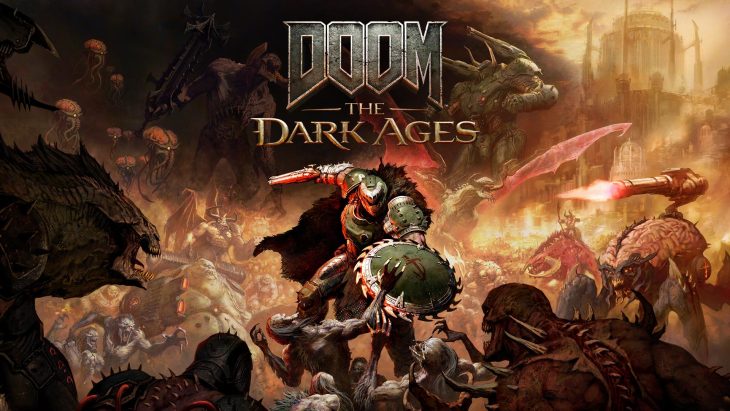
Good afterevenmorn, Readers!
If video games aren’t your thing, you’re not going to like my post today. With the release of Doom: The Dark Ages and let’s plays popping up all over my YouTube feed, I’m going to nerd out today about Doom for a moment. Actually, I’m going to nerd out about one specific cutscene in Doom: The Dark Ages because it flips a common horror trope to highlight the mythology of the main character so perfectly, I’ve been nerding out since I saw the clip during an episode of Jacksepticeye’s let’s play just a little over a week ago. Welcome to my new hyper-fixation.
Before I get into the scene exactly, we’re going to have to dive into the history and lore of Doom.
 Doom, Released 1993
Doom, Released 1993
The first Doom game released in 1993. To be perfectly honest, I had little to no interest in the game in 1993. I was not yet aware of what an incredible medium for story-telling video games can be. Besides, video games were for boys, and weren’t art anyway, so I wasn’t going to engage. Look, 1993 me was a bit of a snob… and very, very wrong. Mostly. Doom was (and remains) a hyper-violent game, which can be a bit much. But there is a story in there, and as the games progressed, the story has become increasingly well-written and executed. What is that story?
Well, an unnamed marine is sent to Mars as punishment for striking his commanding officer when his commanding officer ordered him to fire upon unarmed civilians. I immediately like the guy. On Mars and its moons Deimos and Phobos, the UAC (United Aerospace Corporation) is conducting teleportation experiments and they accidentally open a portal to Hell. Actual Hell. The hot place with all the demons and things.
Well, all those demons and things pour through, and it’s up to this punished marine to obliterate the Hellish host. Which he does, cutting through the demons like a man possessed. That was terrible. I will be here all week.
At the end of the the game, we discover the head of a white bunny on a pike — the unnamed marine’s (whom we’re now calling Doom guy) pet bunny Daisy, setting up an entirely fresh hatred for the armies of Hell (incidentally, I don’t think it’s an accident that John Wick’s puppy is called Daisy. Space Marine John Doe did not go John Wick on the minions of Hell, John Wick went all Doom Guy on the criminal underworld).
 Doom 2, Released 1994
Doom 2, Released 1994
In Doom 2, our hero Doom Guy is called into action again. Earth has been overrun, and he is once again called to take on the armies of Hell in an effort to save humanity. I believe that the two games are set very close together in the timeline. Fueled now by the rage engendered by the loss of his pet bunny (so goofy, and I love it. Also, he supposedly also lost his wife and child, but the big fuss is about the bunny. I’m still figuring that one out) as well as his own innate goodness, Doom Guy once again goes on a rampage. All the same frenetic gameplay and gore.
1996 gave us The Final Doom (it was not, in fact the final one). In this one the UAC, having learnt nothing, I guess, establishes a base on Jupiter’s moon Io. Once again, the UAC manages to open a portal to Hell, and Doom Guy is once again the one who comes to the rescue, tearing through Hell’s minions to save humanity. Poor guy. Bet he has some pretty hefty trauma from it all.
 Doom 64, Released 1997
Doom 64, Released 1997
A year later, and Doom 64 is released on the Nintendo 64. Doom Guy is pulled out of retirement to once again battle Hell. This time, he means for it to be for good (it was not for good). At the end of the game, after defeating the Demon Mother, Doom Guy realizes that the only way he can keep Hell’s forces away is to draw them away. In what can only be described as an incredible act of insanity (you thought I was going to say courage, right? Sometimes the two are indistinguishable), he elects to remain in Hell, fighting demons until he dies (he does not die).
And that’s where he remains. We learn in later games that he is such a savage in Hell, he has become their bogey man. He is their monster under the bed. Say his name in a magma pool three times and he appears behind you and takes your head off.
All is quiet on the Doom front until 2004, in which Doom 3 was released. No one can quite figure out how it fits into the timeline, and while the studio assures us that it is canon, our Doom Guy can’t be the protagonist. He is in Hell for this events of this game. The best fans have come up with is that it’s a different unnamed space marine. The world will never know his name. We salute you, brave sir.
 Doom 2016 – The soft reboot of the original
Doom 2016 – The soft reboot of the original
It’s another eight years before Doom returns to the gaming world. And this is where we start jumping around in the timeline.
In 2016 we get Doom (2016), and a return to the original Doom Guy. In this game, the UAC —Again! Someone take away their funding!— unleashes Hell again when a certain Dr. Pierce attempts to use Hell’s energy in order to solve an energy crisis on Earth. The obvious result is, of course, that Hell once again invades. In this game, Doom Guy has been sealed away in a sarcophagus for centuries, and has acquired a new moniker. Ladles and jelly spoons, introducing the Doom Slayer. He awakens in an overrun facility on Mars, and immediately begins to rip and tear (quite literally) through the demonic ranks.
This is the game where we start to get story cutscenes, and you’re expected to piece together the story from both these scenes and the gameplay. From this game, you get that the Doom Slayer is the avatar of rage. However, he saves that rage for the demons only. Humanity is safe from him.
With the help of the AI Vega, and UAC Scientist Dr. Hayden, who has managed to transfer his consciousness into an android, the Doom Slayer travels between realms, finds the Crucible (the weapon capable of closing the Well facilitating the invasion) and seal the Well. But Dr. Hayden turns on the slayer. After assuring him that the Well has been sealed, Hayden takes the crucible and teleports the Doom Slayer back to Mars in a betrayal that would surprise no one who paid attention during the game.
 Doom Eternal, released 2020
Doom Eternal, released 2020
Four years later, the next instalment in the Doom series is released. Doom: Eternal. Taking place after the events of Doom (2016), Doom: Eternal is where we start to get some depth to our protagonist. We discover that he survived his stay in Hell. Found by humans from the realm of Argent D’nur, he is a traumatized mess of a man. But the Sentinels (the knight-warriors) of Argent D’nur see in him a great deal of potential. He enters their ranks.
The gods of Argent D’nur are the Elemental Wraiths, but there are those who have begun to worship the Maykrs; basically techno-angels. They were allies at one time. We learn in one of the flashbacks that a rogue Maykr known as the Seraphim imbues the Doom Guy with near God-like power. This is how he became the Doom Slayer, instead of just Doom Guy.
In this game, the UAC has been thoroughly corrupted, becoming basically a Hell-worshiping cult. It is also revealed that the leader of the Maykrs has made a pact with Hell. In order to maintain the prosperity of the Maykrs, she has agreed to provide Hell with worlds to invade, in exchange for Argent power, created from the suffering of Human souls. And, well, she’s invaded Earth. Well, the Doom Slayer is having none of that. Time to rip and tear again.
And he does.
This is the important thing. Doom Guy, AKA the Doom Slayer, had thwarted Hell’s invasions thrice before going to live full time in Hell. He survived Hell, he made it out (was a complete wreck, but he made it out), he joined the ranks of warriors who battled Hell (before the Maykr’s betrayal), and then thwarted Hell again centuries later (in Doom (2o16)), and then AGAIN in Doom: Eternal, where he also obliterated the leader of the Maykrs. The man is too angry to die. No Hellion has managed to kill him. All who have faced him have perished.
Hell is terrified of him (and not just Hell).
And boy did the director make that plain in the cutscene of Doom: The Dark Ages that caught my attention and made me nerd out enough that I’m writing about it here… because I had to gush to someone, and you’re that person. Sorry and or you’re welcome.
(Doom: The Dark Ages is a prequel, taking place before the events of Doom (2016). The let’s play I’m following hasn’t concluded yet, so I’m not sure about the story exactly, so I can’t summarize it for you yet.)
The manner in which the cutscene plays makes it abundantly clear that the Doom Slayer is a monster to monsters. His entrance is reminiscent of countless horror movies. He cuts through a heavy locked door. The drop of his weapon, a flail, reminds me of the Witch King of Angmar as he faces Eowyn on the battlefield in Return of the King. The way he drags it on the ground, sparks flying, as he walks slowly towards his target (the demon Prince Ahzrak), is straight out of Silent Hill (Pyramid Head, anyone?). The way he keeps coming — an unstoppable force of nature— is reminiscent of Halloween.
Here, see for yourself:
The dude is a horror villain. Except he’s on our side. It flips the horror trope so beautifully that I was rooted to the spot while watching, and then immediately geeked out. And have been geeking out for about a week.
I cannot express how much I love this inversion. It’s excellent visual storytelling. Beyond everything you learn throughout the games, this one scene shows the player exactly who the Doom Slayer is, and what he is to the demons. He is not trapped in a facility on Mars with the armies of Hell. The armies of Hell are trapped in a facility on Mars with him. And it’s great.
Anyway, thanks for letting me nerd out for a moment. I’ve really made this a long one. You’re a champion if you made it all the way to the end. I don’t really have a question for you this time around. I’m still marveling over that cutscene. So instead, I’ll wish you all a wonderful day and an even better week.
When S.M. Carrière isn’t brutally killing your favorite characters, she spends her time teaching martial arts, live streaming video games, and cuddling her cat. In other words, she spends her time teaching others to kill, streaming her digital kills, and a cuddling furry murderer. Her most recent titles include Daughters of Britain, Skylark and Human. Her serial The New Haven Incident is free and goes up every Friday on her blog.
By Crom: Marvel, Roy Thomas, and The Barbarian Life
So, back in January of 2022, I did a post on Roy Thomas and the Marvel Conan comic he created in the seventies. I never read that comic. But for some reason in 2019, I decided to buy the first of what turned out to be his three memoirs about the series (mostly about the first 115 issues, which constituted his first run with Conan), and also one of the Marvel Omnibuses that had been put out recently. I ended up getting four of the high-quality Omnibuses, which are those 115 issues he covered in his books.
And I just finished, a couple years later, the first 100, which culminated with the death of Belit, from “Queen of the Black Coast.”
I also recently started the Savage Sword of Conan Omnibus, which ran around the same time, and was black and white. It’s a more ‘literary Howard’ comic, and definitely different than the color Conan one (also less popular).
Below is the original post I did. Then, an additional section, having read through the first hundred. I think this comic is definitely a must for Conan fans. I prefer some of these stories to the Tor pastiches. They’re not all good, of course, but I have enjoyed my read through. And I cannot recommend enough, getting Thomas’ three books. Read one comic issue, then the accompanying short chapter from his book. It’s a terrific experience. Read on, MacDuff (a little literary malapropism for you).
One Black Gate series which I have started, but is still for somewhere down the line, is a look at the first dozen-or-so issues of Roy Thomas’ Conan the Barbarian comic. And even before running that series, I intend to write one for the second dozen-ish, so I can tie together the various overlaps. This was prompted by a combination of the over-sized Marvel hardback Omnibuses, and Roy Thomas’ TERRIFIC (now) three-volume memoir about the series, from Pulp Hero Press.
I never read the series, growing up. I bought some of the Dark Horse collections, which I liked. And when Marvel reacquired the rights and put out that first door-stopper compendium, I bought it. And I liked it enough to get the next three. I was buying them in conjunction with Roy Thomas’ Barbarian Life. The first Thomas volume covered the genesis of the comic, and the first fifty-one issues – which happened to be the same ones included in the first Omnibus.
Thomas helmed the series for 115 issues – which is how many are covered by the first four Omnibuses (both series’ talk about other issues as well). So, Thomas’ three books complement the Omnibuses perfectly. I read a story, and then I read Thomas’ insights. Along with the relevant commentary in the Omnibus itself. It’s a real Conan treat!
Thomas would write other color Conans for Marvel, and return to it over the years. And he would also contribute to Dark Horse while they had the rights. But it’s that first run, when he was Stan Lee’s right hand, and he made Conan a best-selling property for Marvel, which fans revere.
At the same time, Thomas was running the black-and-white The Savage Sword of Conan, (originally Savage Tales. That’s another post some day)which was more risque, and told a more in-depth story (LOTS of words). It’s a very different experience than Conan the Barbarian, and Marvel has collected those in Omnibuses as well.
Conan the Barbarian ran for 275 issues, from 1970 to 1993. That’s pretty amazing, as when it debuted, Conan was not the well-known figure he is today.
Here’s an excerpt from the first part of the planned Black Gate series:
An awful lot of people were introduced to Robert E. Howard’s Conan (best known as ‘The Barbarian’) through L. Sprague de Camp’s paperback series first from Lancer, and then, Ace. They featured those fantastic Frank Frazetta covers that are still popular today.
And in the early eighties, Arnold Schwarzenegger starred in two popular Conan movies that set the standard for fantasy movies until Peter Jackson’s amazing Lord of the Rings trilogy. The sword-swinging former governor of California is the image of Conan many people still have today.
In between those two ‘sources,’ came Marvel Comics’ Conan the Barbarian, with Roy Thomas in charge for the first 115 issues of a much longer run.
De Camp is justly criticized for rewriting Howard’s prose: Robert E. Howard did not need to be ‘edited.’
He has taken somewhat less-justified abuse for the Conan pastiches he wrote – by himself, and with Lin Carter, and Byron Nyborg. While they certainly can be criticized, in general; they deserve to be more fairly assessed than they are, I feel. I like most of them.
While Director John Milius did incorporate some elements from Howard’s original stories, Schwarzenegger’s Conan is a far cry from the original creation. Thomas co-wrote a screenplay for the second Conan movie, but Milius didn’t use it. It forms the basis of The Horn of Azoth comic book, from Marvel.
And Roy Thomas and Barry Smith certainly created their own version in the comics. But Thomas liked Howard’s writing and included much of it. Even though it didn’t feature a superhero, Marvel’s comic was one of the most popular of the seventies and eighties, unlikely as that seems. As is the case with de Camp’s paperbacks and Schwarzenegger’s movies, the Conan comic book was how many people discovered the sword-swinging barbarian. And its importance in the history of Conan cannot be minimized.
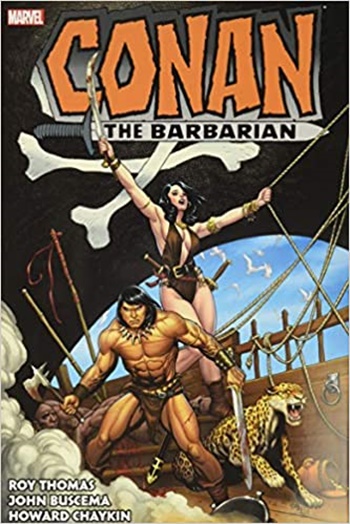 I’ve always got a couple of things in the works for here at Black Gate, but I’d really like to get to this Marvel Conan the Barbarian (CtB) series. Is the comic canonical? – no. But Thomas really draws on the source material. And not just the original Conan stories. I’ve already written a 1,500-word essay on The Grim Grey God, which is one of my favorite REH historicals. And it was adapted for Marvel issue number three. It’s terrific! Thomas (with some effort and wrangling) also got to use some of de Camp’s stories as well.
I’ve always got a couple of things in the works for here at Black Gate, but I’d really like to get to this Marvel Conan the Barbarian (CtB) series. Is the comic canonical? – no. But Thomas really draws on the source material. And not just the original Conan stories. I’ve already written a 1,500-word essay on The Grim Grey God, which is one of my favorite REH historicals. And it was adapted for Marvel issue number three. It’s terrific! Thomas (with some effort and wrangling) also got to use some of de Camp’s stories as well.
I’ve read a LOT of Sherlock Holmes stories which have NOTHING to do with the original character. They’re complete bastardizations of Arthur Conan Doyle’s creations. I’ve had several Holmes stories published, and I try very hard to write the character Doyle created.
Thomas’ Conan is recognizable as Howard’s Conan. No, not exactly the same. But he didn’t just slap the Conan name on a barbarian and draw whatever the heck he wanted to.
BTW – the series will talk about how it was almost Lin Carter’s Throngor, not Conan, that was going to be the hero of the strip. Circumstances barely conspired to result in it being Conan!
Each Omnibus has an introduction from Thomas, talking about the various issues. The comics themselves are in glorious color. I’ve seen some criticism of the quality of the reproduction. I think it’s fine. Easy to read with good lighting (my eyes are getting old – like me). The text is clear. Colors are distinctive. Seeing that splash page, and the color, full-size, is terrific!
There are a bunch of extras at the end of each book, including some artwork, essays by Thomas, and other miscellany. I believe that each volume has been about 800 pages of Conan goodness.
Thomas had written an extensive history of his Conan Marvel experiences for Spanish publication. That work was translated into English, revised, and expanded: and that makes up the three volumes of Barbarian Life. He shares his memories in each volume. Comments on the story, inker, problems, things he liked about them – just great stuff for a fan of the series. A ton of info.
So, the first four, with Thomas’ three-book series, gives you a detailed look at the first 115 issues; with additional topics covered. It’s no surprise Thomas talks a fair amount about his other Conan series, the black-and-white Savage Sword of Conan. And the Omnibuses even include an issue or two.
The Omnibuses are $125 when they come out, but they drop below $100 relatively quickly. They have sold out, though Titan seems to be republishing theri version. I haven’t gotten Volume 5, as it marks the beginning of the post-Thomas Era. Marvel’s King Conan, based on de Camp’s later pastiches, start coming out this summer in Omnibus form.
I really enjoy Thomas’ three books. They are a treat to read. And obviously, being able to read the issue he’s talking about makes it a better experience. I recommend his books, and the accompanying Omnibuses. I have paperbacks of Thomas’ books, for research purposes. But I also have the first two as e-books, and I love the color covers in them. They look great on my Kindle Fire.
Now, if I could get around to writing that series for Black Gate…
UPDATE – MAY 2025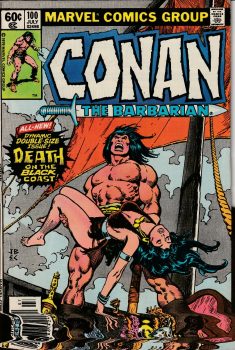 I really enjoyed quite a few of the early issues. #3 was one of my favorite REH historicals, based on “The Grim Grey God. That was immediately followed by the classic “Tower of the Elephant.” #7 was “The God in the Bowl.”
I really enjoyed quite a few of the early issues. #3 was one of my favorite REH historicals, based on “The Grim Grey God. That was immediately followed by the classic “Tower of the Elephant.” #7 was “The God in the Bowl.”
Thomas continued to mix in non-Conan stories, and fragments, by Howard. “Queen of the Black Coast is one of the most popular Conan tales. Thomas built his tenure around this story. Issue #57 was devoted to what resulted in the opening of “Queen,” ending with Conan galloping towards the docks. #48 recounts the first part of Howard’s story, with Conan joining Belit’s crew on the Tigress, and becoming Amra (The lion).
Thomas would get to the second and concluding part, 43 issues later in #100 (in a double-length issue). There were flashbacks, and a few solo adventures, but he had Conan and Belit adventure for about three and-a-half years. Thomas comments that the Miller and Clark timeline (tacitly endorsed by Howard himself) had them roaming for three years.
But there’s plenty of Conan and Belit in this first hundred issues. Belit and Red Sonja (who in Howard’s original stories is nothing like the chainmail bikini clad warrior here) appear in a few issues together. They do not become bffs.
Elric of Melnibone comes by (twice, I think). A John Jakes plot is used, but it’s not one of Brak the Barbarian’s. Thoth Amon emerges as a foe of Conan.
El Borak, Steve Clarney, and Kull, are among those REH characters whose stories are converted to Conan. And many one-off REH stories. Literary estate executor Glenn Lord worked well with Thomas, allowing Marvel to buy the rights to use many REH works (originally Marvel had the character, but not the Conan stories, though that changed).
There’s plenty of original Conan, but it’s cool to see so much Howard – and other writers’, including Norvell Page (separate post coming on that one). I enjoy reading non-Conan stories, such as “Out of the Deep,” rewritten for Conan (that’s a cool Weird Menace story).
I am going to switch over and read some Savage Sword of Conan, having bought the first two Omnibuses. I also skipped over most of the included Annuals, added to the end of each Omnibus. Volume Three had and Annual with the first Conan story, “The Phoenix on the Sword,” which has always been a favorite of mine.
I’ll get back to the final fifteen Thomas stories, which are post-Belit.
But I think that the Conan comic was quite good. If you’re going to check it out, I HIGHLY recommend getting at least Thomas’ first memoir. The books absolutely enhance the experience, issue by issue.
Jeffrey Talanian wrote an essay on Thomas and Conan, which you can read here.
And, this page has ALL of my Robert E. Howard essays here at Black Gate. I’ve written quite a bit.

Bob Byrne’s ‘A (Black) Gat in the Hand’ made its Black Gate debut in 2018 and has returned every summer since.
His ‘The Public Life of Sherlock Holmes’ column ran every Monday morning at Black Gate from March, 2014 through March, 2017. And he irregularly posts on Rex Stout’s gargantuan detective in ‘Nero Wolfe’s Brownstone.’ He is a member of the Praed Street Irregulars, founded www.SolarPons.com (the only website dedicated to the ‘Sherlock Holmes of Praed Street’).
He organized Black Gate’s award-nominated ‘Discovering Robert E. Howard’ series, as well as the award-winning ‘Hither Came Conan’ series. Which is now part of THE Definitive guide to Conan. He also organized 2023’s ‘Talking Tolkien.’
He has contributed stories to The MX Book of New Sherlock Holmes Stories — Parts III, IV, V, VI, XXI, and XXXVII.
He has written introductions for Steeger Books, and appeared in several magazines, including Black Mask, Sherlock Holmes Mystery Magazine, The Strand Magazine, and Sherlock Magazine.
You can definitely ‘experience the Bobness’ at Jason Waltz’s ’24? in 42′ podcast.
Transcendent and Creepy: Rich Horton on The Forever War by Joe Haldeman
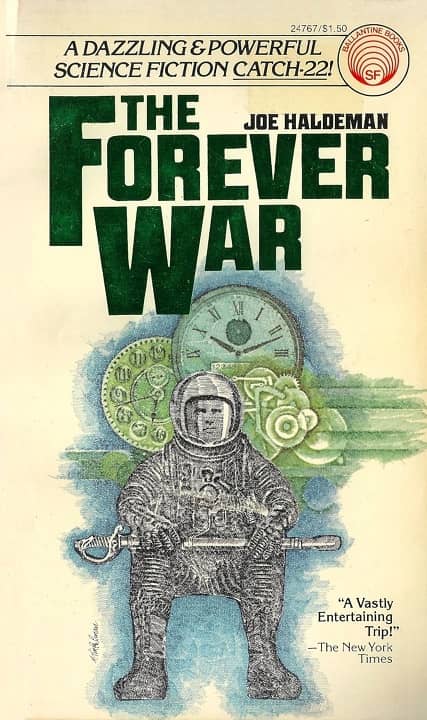
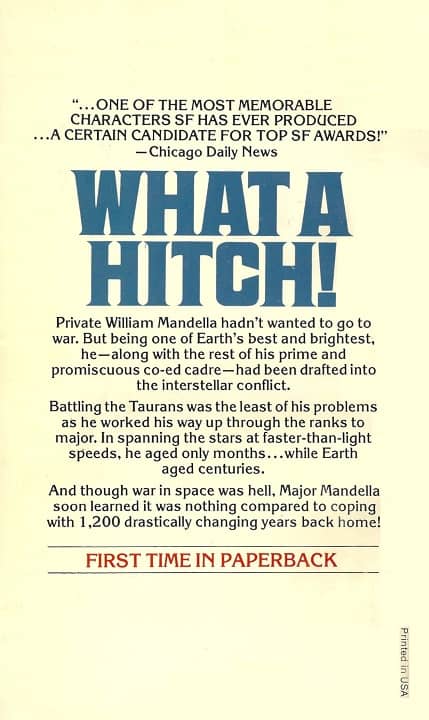
The Forever War (Ballantine Books, 1976). Cover by Murray Tinkelman
Rich Horton continues to review classic science fiction novels at his blog, Strange at Ecbatan. Last month he turned his attention to Joe Haldeman’s The Forever War, on the 50th anniversary of its release.
It’s definitely worth reading — a bitter and cynical look at war, some cool ideas including the effect of time dilation and lots of physics, a somewhat transcendent but pretty creepy conclusion. And, also, some very ’70s things, including pretty questionable — at times downright offensive — “sexual revolution” era sexual politics, and oddly 70s-ish notions of dystopia. My impression… I liked it then and I endorsed its Hugo and Nebula wins.
The Forever War is one of the most honored science fiction novels of all time. First published by St. Martin’s Press in 1975, it swept every major SF Award, including the Hugo, Nebula, and Locus awards. In 1987 it placed 18th on Locus’ list of All-Time Best SF Novels, beating out The Martian Chronicles, Starship Troopers, and Rendezvous with Rama. It’s been in print nearly continuously for the last four and a half decades. Here’s some of the most noteworthy editions.
[Click the images for bigger versions.]
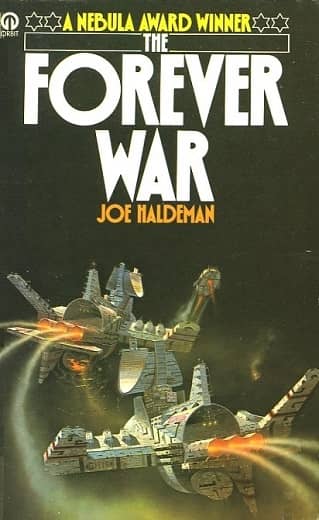

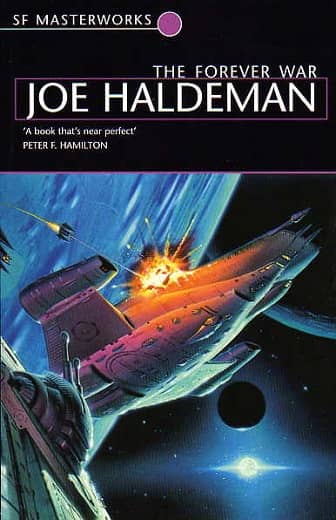
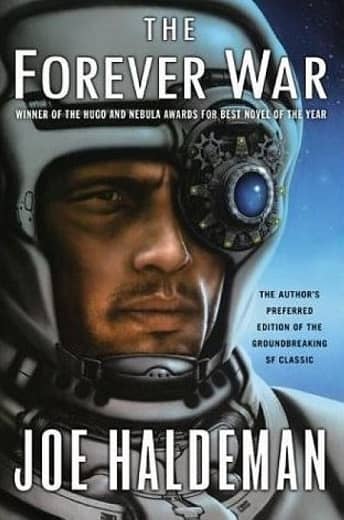
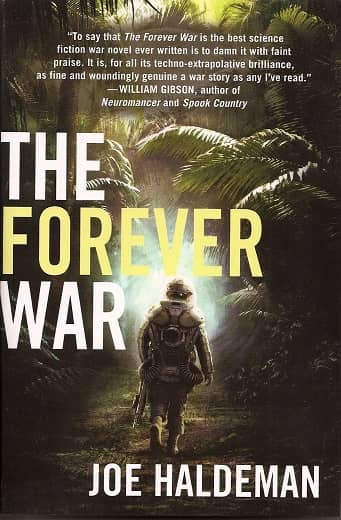
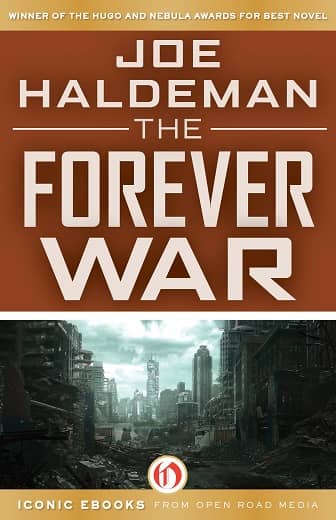
Three decades of The Forever War. First row: Orbit (1976), the first unexpurgated edition (Avon, 1991),
and the Gollancz SF Masterworks edition, with Author Notes (1999). Covers by Patrick Woodroffe,
Dorian Vallejo, and Chris Moore. Second row: Eos (2003), St. Martin’s Griffin (2009), and
Open Road (2014). Covers by Jim Burns, Tomislav Tikulin, and Michel Vrana.
So what’s the book about? Here’s Rich again.
William Mandella is drafted into a war against the aliens, there are several very impressive battle scenes, he falls in love with fellow soldier Marygay Potter, they are separated by time dilation, the war ends when it is realized the whole thing was a mistake due to poor communication, Marygay waits for William by flying back and forth in a spaceship until time dilation means their timelines are synchronized again…
What did I think on a reread? It’s still a pretty effective book. The telling is cynical in a totally believable way. The Army scenes ring very true — and Haldeman would certainly be a better authority than me anyway. The soldiers are foulmouthed, dislike their commanding officers, but fairly disciplined if only because the alternative is dying…
It’s very exciting, and well-written. The battle setups are interesting, and seem like a plausible use of the technology Haldeman invents. Some of this tech is pretty implausible, but in an almost believable fashion. The new section, originally called “You Can Never Go Back”, concerns William and Marygay’s return to Earth after their battles, at which time they are eligible to muster out. They describe at thoroughly decayed Earth society, in a very ’70s fashion. Homosexuality is [encouraged] as a population control measure (though — as Mandella even points out — birth control is pretty easy to enforce anyway.) Haldeman’s depiction of homosexuality is mostly positive, I suppose, but there are some cliches, which I understand he regretted in later years. The rest of the depiction of Earth at that time seems a bit over the top — but partly it’s a device to make it plausible that the two of them reup.
As Rich notes in his review, the early (pre-1991) editions of The Forever War were significantly abridged, omitting the entire middle section. The 1991 edition restored most of the expurgated sections, but left some some clumsy changes from the early edits intact. It wasn’t until 1997 that Avon published a version that Haldeman considered definitive.
See the complete details on the publishing history of The Forever War here at Black Gate, and read Rich’s complete review at his blog here.
You Can’t Handle the Tooth, Part I
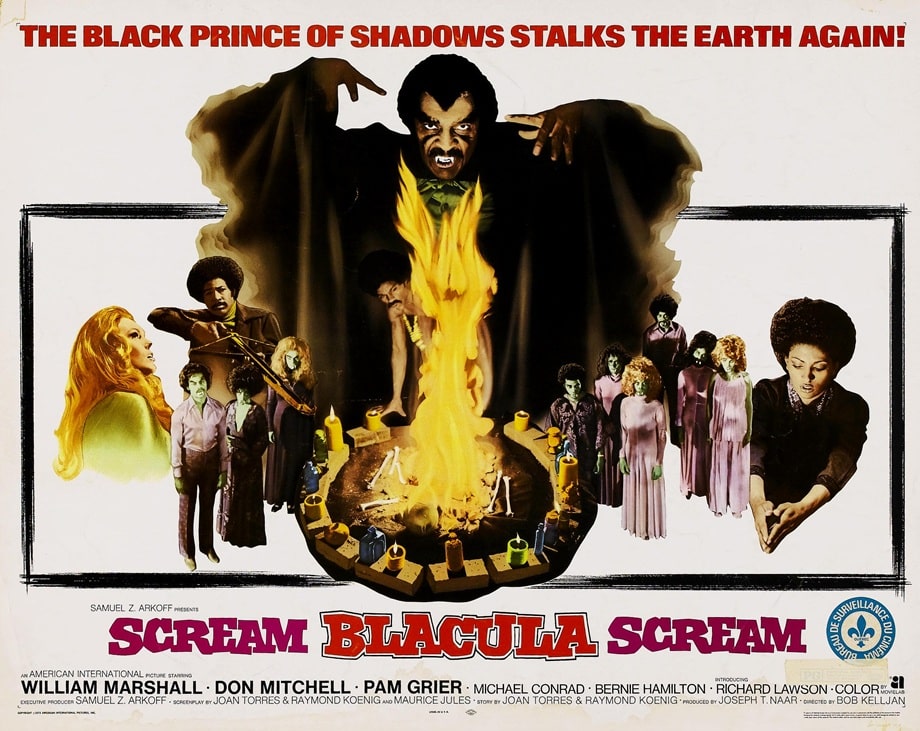 Scream, Blacula, Scream (American International Pictures, June 27, 1973)
Scream, Blacula, Scream (American International Pictures, June 27, 1973)
20 vampire films, all first time watches for me.
Come on — sink ’em in.
Scream, Blacula, Scream (1973) – TubiI’ve seen Blacula (1970) plenty of times, but somehow never got around to watching the sequel, and thank the stars I did, because it’s excellent. I think I like it even more than the original.
If you are new to this nonsense, the original film told the tale of an African prince who is bitten by Dracula and becomes a bloodsucking fiend on the streets of L.A., tapping all jive turkeys he comes across. It’s obviously a product of the Blaxploitation era, but its dodgy premise is saved by the presence of William Marshall. For my money, Marshall can stand toe-to-toe with Christopher Lee as one of my favorite depictions of the count (so to speak). Like Lee, he brings much gravitas, animalistic savagery, and raw sex appeal to the role, along with one of the best voices in the business.
This sequel though has the added bonus of Pam Grier at her height of acting skill and gorgeousness, and a voodoo sub-plot that adds an extra layer to what is ultimately a tragedy. Marshall brilliantly walks the line between monster and victim, and it doesn’t matter how many other players are in the scene, he and Grier keep you mesmerized.
A wonderful start to a new project — onwards and upwards!
8/10
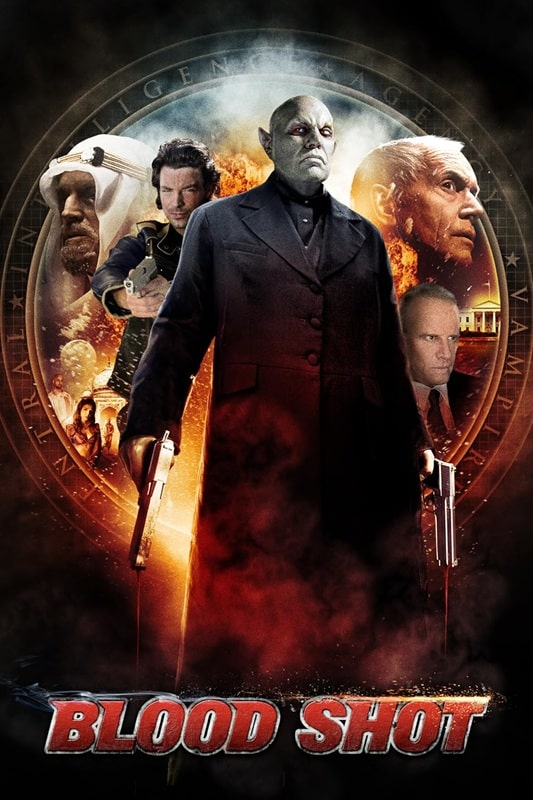

Blood Shot (Infinite Justice Productions, 2013) and Night Teeth (Netflix, October 20, 2021)
Nope, not the quickly forgotten Vin Diesel actioner from four years ago, nor the other Blood Shot from 2013 starring Danny Dyer, this one is a straight to video chunk of sparkly tomfoolery featuring brief cameos from a lot of actors who need new patios.
In a nutshell, the CIA has a special division that employs the services of the last living vampire to take out terrorist threats to the US of A. This vampire (Michael Bailey Smith — wonderful) is a wise-cracking brute of a Nosferatu, and an effective hitman (bitman?). However, his missions are often hampered by a dogged detective, played with maximum grizzledness by Brennan Elliott, who is determined to kill the vamp. His attempts to kill the bloodsucker grow successively funnier as he exhausts his collection of tricks (garlic-filled shotgun shells etc.), all the while getting the snot kicked out of him. Things come to a head when a nefarious gang on a manic jihad arrive in the city, ready to unleash a nuclear bomb, and the vampire and detective must reluctantly team up to take them down.
First of all, I wasn’t expecting anything from this, but I had a splendid time. The snippy buddy-cop routine between the two leads was excellent and there were some genuinely funny moments.
It’s not all YIKES-free though.
A close squint at the poster will reveal Brad Dourif in brown-face and hook-nose prosthetic as ‘Bob’, the jihad organizer whose real name is too long so everyone shortens it. He’s not the only white actor playing a character of Middle-Eastern descent, so be forewarned. It’s a bizarre decision, but perhaps in keeping with the irreverent nature of the story. Also, if you do decide to take a look, don’t be put off by the seizure-inducing first 10 mins. It settles down quickly, possibly because the editor got tired or had to go to hospital.
A cautious recommendation.
7/10
Night Teeth (2021) – NetflixFirst up, I don’t like this title. It’s awkward to say and isn’t very interesting. Secondly, this is a Netflix film, and I like that they are producing so many films and giving newish directors a crack, but I’ve reached the point where they all look the same to me. Same lighting, same editing, same polished ‘product.’
That’s what they’re knocking out. Not films. Content.
Anyhoo, on a more positive note, I liked the idea of L.A. being split into five, vampire-run, districts, and one uppity bloodsucker attempting a coup during the course of one night. The monster on the power trip is Victor (of course), played by Alfie Allen (Theon Greyjoy of GoT), and he has sent his faithful hitwomen out to do the dirty deeds. The bitey ladies, Zoe (Lucy Fry) and Blaire (Debbie Ryan) need a driver for the night, and the hapless Benny (Jorge Lendeborg Jr.) ends up filling in for his brother, who is up to shenanigans. As Benny drives the women from slaying to slaying, he slowly figures out what is going on, and then has to fight for survival.
It’s a potpourri of borrowed ideas from the likes of the Underworld and John Wick films (especially the secret society with rules), and could have been spectacular, but leaden writing and wooden delivery (particularly from Sidney Sweeney and Megan Fox in a 5-minute cameo) let it down. I was really impressed with Ryan and Lendeborg Jr. though, and could stand to see them in more projects.
Recommended if you like glitz and exposition.
6/10

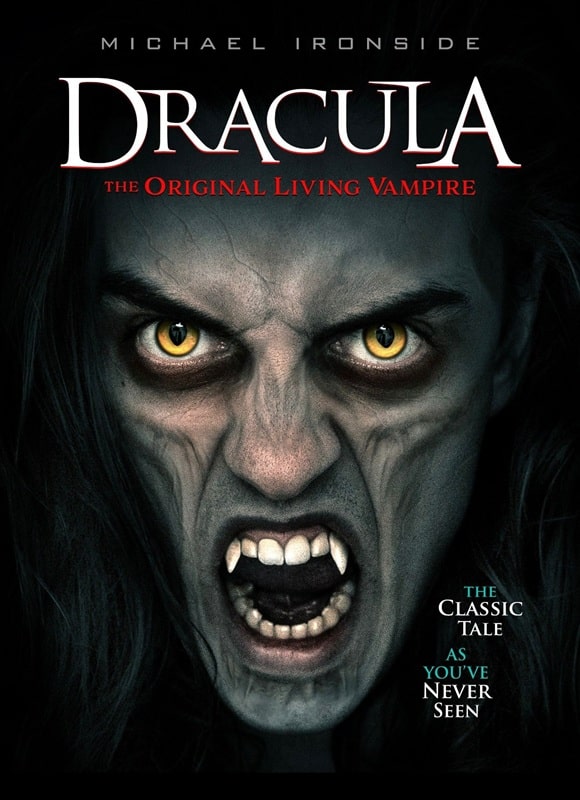
Vampires on Bikini Beach (Beacon Films, 1988) and Dracula:
The Original Living Vampire (The Asylum, January 28, 2022)
Remember the 80s? That glorious time when the best vampire films came out? Fright Night, Near Dark, Lost Boys, Innocent Blood, Vamp, et al. What a time. Anyhoo, writer/producer/director Mark Headley thought “Hey, folks love vampire flicks, and they like bikinis, and my pal needs an 80-minute promo video for his dull band, I got it!” and so this film came to be, and it was bad.
Here’s the skinny: some boring teens find a boring book that has something to do with some boring vampires in the most boring parts of Venice Beach. Boredom ensues.
It’s so shoddily written, acted and filmed, that it can’t even be considered as a ‘so bad it’s good’ flick; it’s just aggressively rubbish. It’s the first hate-watch I’ve done in a while, which is amazing considering all the crap I watch.
Recommended.
1/10
Dracula: The Original Living Vampire (2022) – PrimeCue arguments about whether vampires are technically ‘living.’
Anyhoo, when the words ‘The Asylum presents’ flash up on screen, they tend to trigger a Pavlovian response in that my expectations are immediately quashed. This is a very healthy attitude, and can sometimes lead to a pleasant surprise. Not this time, however.
D:tOLV is a weird film. It really doesn’t know what it wants to be — a horror film, police procedural, or a comedy. I don’t suspect the latter was intentional. It allegedly takes place in the UK, which for some reason is depicted as a turn of the (previous) century Austrian town transplanted to the Carpathians, complete with mountain-top castle. The clothing is early 20th C, houses are lit by candle light and some bulbs, Van Helsing carries a luger, and characters say stuff like ‘it’s above my paygrade.’
Anachronisms aside, it’s an interesting twist on the tale. Amelia Van Helsing is a police detective working with Captain Renfield. Amelia works closely with mortician Dr Seward (Michael Ironside, briefly phoning it in), and chemist Jonathan Harker, as the group tries to solve the murders of a bevy of red-haired women, all drained of blood. When Van Helsing’s girlfriend, Mina, gets targeted by Drac, they must rally forth and get on with some slaying.
This premise is let down by some pretty bland acting (Amelia and Dracula in particular were wrongly cast) and a great deal of dull conversation. I mean, a LOT of conversation. 50% of the film is Harker and Van Helsing pulling a Mulder and Sculley – the twist being that Van Helsing doesn’t believe any of it. The other 50% is filled with Seward talking to himself, some lacklustre action, and a couple of sex scenes to ensure there are some knockers for the foreign markets. Wasted potential.
Minus another point for the bad grammar on the poster.
4/10
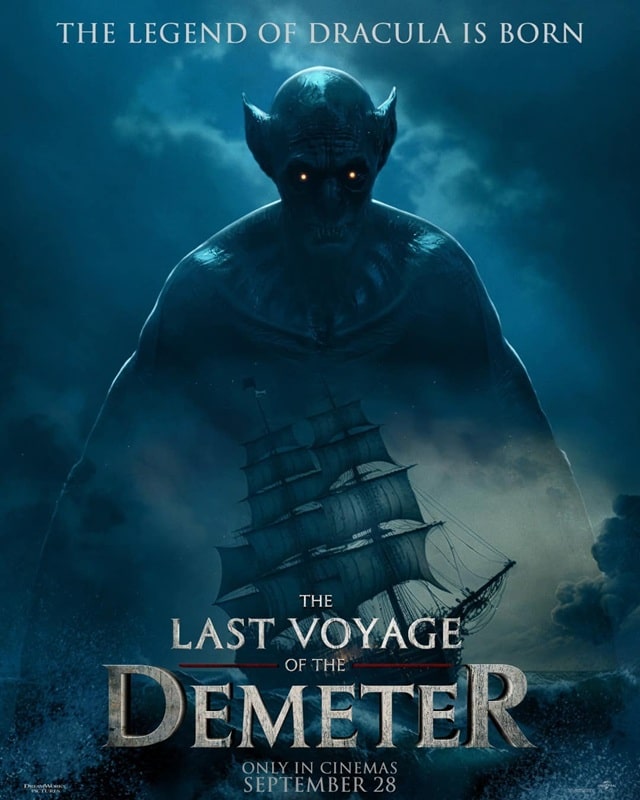
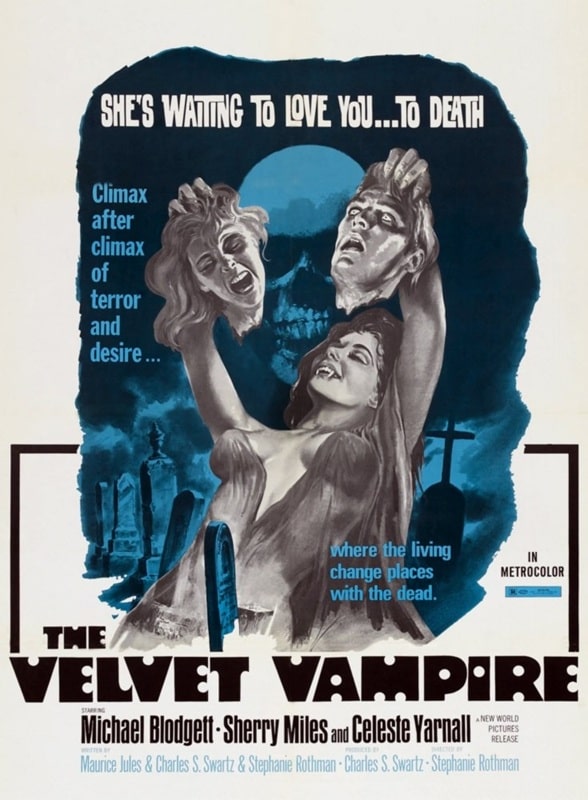
The Last Voyage of the Demeter (Universal Pictures, August 11, 2023)
and The Velvet Vampire (New World Pictures, June 1971)
The untold story of the doomed Demeter from Bram Stoker’s Dracula has long been a gothic tease for horror fans. It has been touched upon in other films (and was my favorite part of the recent Dracula adaptation by Mark Gatiss and Steven Moffat), but my anticipation was riding high when I heard André Øvredal was directing a version of the story. Øvredal is responsible for Troll Hunter and The Autopsy of Jane Doe, two of my favorite films, and with a cast fleshed out by the likes of Liam Cunningham and Corey Hawkins, how could it go wrong? Well, it didn’t, but it also didn’t go spectacularly either.
It looks good, and the performances are great, but there was something about it that didn’t quite work for me. Perhaps it was the repetitive, episodic feel of crewmembers being bumped off one by one while exposed on the deck during the night watch, maybe it was Dracula himself. I loved the design of the vampire, but his face didn’t do it for me. His savagery was undeniable though, and the effects, a seamless blend of practical and CG, were top notch. Hawkins’ character, Clemens, offered up an interesting angle being not only a man of science, but also black, in a time when Eastern Europeans would have been remarkably intolerant. He does touch upon this, but I feel it could have been explored further.
Cunningham is the captain of the ship in every sense of the word, elevating every scene he is in, and the skeleton crew do their jobs well, even if they are largely forgettable aside from the reliable David Dastmalchian. I went into this assuming it would be a ten-out-of-ten movie, but it gets eight from me, partly because I hyped it up too much for myself, and partly because an awesome sequel is hinted at but the box-office was so dire that, like Dracula, it will never see the light of day.
8/10
The Velvet Vampire (1971) – PrimeIt would be remiss of me not to include a title from the Roger Corman stable, so here we are, with a notable title for several reasons. Firstly, it was directed by Stephanie Rothman, a trailblazer in the film industry and responsible for a clutch of genre-bending flicks. Rothman leaned into the fluid sexuality of vampires, no doubt prompted by the recent success of Hammer’s lesbian vampire films (Vampire Lovers, Twins of Evil, Lust for a Vampire), and adapted a story, Carmilla, written in 1872 by J. Sheridan Le Fanu. Carmilla is considered to be the first lesbian vampire story ever published, and the lead antagonist, Diana Le Fanu, is named after him as a direct homage.
The tale concerns Sarah and Lee, a swinging married couple who encounter Le Fanu at an art gallery (where the actual Johnny Shines is playing a fantastic tune), and the enigmatic Le Fanu invites them to stay at her remote home in the middle of the Mojave desert. By this point, Le Fanu has already killed a would-be rapist in the opening scene, so we are well aware of her strength.
Car trouble forces the couple to start walking, but then Le Fanu turns up in a dune buggy (!), and takes them back to her place. After that, not much happens. There’s some walking around, a bit of jealous chat, and some semi-erotic dream sequences, but you will have to wait about 40 mins for someone to actually get bitten.
Naturally, shenanigans ensue.
Is it a great film? Not particularly, but you can see why it’s a cult classic. Lee’s casual promiscuity, Sarah’s blank-faced screaming, Diane’s bisexual seductions, some early electronic scoring, and some lovely color design (look for all the red bits) are certainly worth a look if you don’t have anything more pressing to attend to.
5/10
Previous Murky Movie surveys from Neil Baker include:
You Can’t Handle the Tooth, Part II
Tubi Dive
What Possessed You?
Fan of the Cave Bear
There, Wolves
What a Croc
Prehistrionics
Jumping the Shark
Alien Overlords
Biggus Footus
I Like Big Bugs and I Cannot Lie
The Weird, Weird West
Warrior Women Watch-a-thon
Neil Baker’s last article for us was Part VII of Tubi Dive. Neil spends his days watching dodgy movies, most of them terrible, in the hope that you might be inspired to watch them too. He is often asked why he doesn’t watch ‘proper’ films, and he honestly doesn’t have a good answer. He is an author, illustrator, teacher, and sculptor of turtle exhibits. (AprilMoonBooks.com).
Tor Doubles #8: Leigh Brackett’s The Nemesis from Terra and Edmond Hamilton’s Battle for the Stars
 Cover for The Nemesis from Terra by Tony Roberts
Cover for The Nemesis from Terra by Tony RobertsCover for Battle for the Stars by Bryn Barnard
This volume includes the story Nemesis from Terra by Leigh Brackett and Battle for the Stars, byt Edmond Hamilton. There are two significant distinctions for this volumes. The two authors represented were married to each other and one of the stories was previously included in the Ace Double series. The Tor Double was originally published in May 1989.
The Nemesis from Terra was originally published as “Shadow Over Mars” in Startling Stories in Fall, 1944. It was previously published as part of an Ace Double (F-123, with Robert Silverberg’s Collision Course) in 1961. The Nemesis from Terra is the first of three Brackett stories to be published in the Tor Doubles series.
Although set on Mars in the far future, as with many of Brackett’s Martian stories, The Nemesis from Terra feels more like a fantasy novel than a science fiction novel. It is a descendant of the Mars of Edgar Rice Burroughs and could easily be classified with the stories of Robert E. Howard, neither of which is a surprise.
Rick Urquhart is the main character of the novella, although to call him a protagonist gives him more agency than he really has. From the earliest pages, in which he ducks into a doorway to avoid the anthropoid Martians who are tracking him down and hears an old woman prophecy that his shadow will extend over Mars until the final pages, he is more reactive to events, whether they are forcing him into a course of action or he is attempting to avenge wrongs perpetrated on him.
His life isn’t entirely horrible. While escaping the clutches of the evil Terran Exploitation Company, run by Ed Fallon and his henchman Jaffa Storm, Rick meets Mayo McCall, and the two fall instantly in love, although there seems little reason for their affection. Rick is also the subject of Kyra’s love, a young winged Martian girl, who sees in him the future of Mars.
Of more interest that the plot or Rick himself, is Brackett’s complex depiction of her Martian society. Made up of humans and Martians, the humans, like Fallon, are looking to exploit the planet. There seem to be multiple races of sentient Martians who are not unified. The Martians led by Haral, the last of his line, possess the Collar of Ruh, which signifies legitimacy to rule. The Thinkers are a legendary race of Martians who may have plotted out the planet’s history before disappearing. The winged race to which Kyra belongs lives in their own city, mostly not venturing forth.
Brackett briefly explores all of these civilizations, as well as Fallon’s Company, his competitor, Hugh St. John, and briefly mentions regulatory agencies which deal with Martian and interplanetary trade. The result is a complex society, but one which Brackett is not able to fully explore and Rick is buffeted by all of their forces to fulfill the old woman’s prophecy.
Although the prophecy regarding Rick is uttered in a small, secluded room, the contents of the prophecy become generally known without agency. Although Rick initially fights against the idea that he will one day rule Mars, a concept which puts a target on his back for all of the various entities Brackett has created. However, Despite the love that Mayo and Kyra seem to feel for him, Rick’s self-centeredness makes him hardly a sympathetic figure for the reader. Not evil, especially when compared to Fallon and Storm, Rick doesn’t seem to believe in anything and never really changes. His motives are almost entirely self-preservation and vengeance. Even Mayo, who purportedly loves him questions whether the prophecy is right about him and whether she wants to see him succeed. The only complete affection for Rick that is shown is by Kyra, who Rick seems to see more as a tool to be used than as a person.
Brackett’s complex Martian society demonstrates that even at this early stage of her career, this was her first novel, although she had been publishing short stories for eleven years, shows her strengths. While characterization is a weakness in The Nemesis from Terra, that is also an area in which Brackett would eventually improve.
Although Brackett and Hamilton first met in 1940, they didn’t marry until 1946 and remained together until his death in 1977. Brackett survived her husband by thirteen months, during which time she worked on the first draft of a sequel to Star Wars, which was ultimately not used, although she received a writing credit on the film The Empire Strikes Back.
 Startling Stories Fall 1944 cover by Earle K Bergey
Startling Stories Fall 1944 cover by Earle K BergeyBattle for the Stars cover artist unknown
Battle for the Stars was originally published as a stand-alone novel by Dodd, Mead in November, 1961. Edmond Hamilton began publishing in 1926, and although his earliest stories appeared in Weird Tales and were Lovecraftian and Howardian in their feel, he eventually turned his attention to science fiction, writing the 1940s Captain Future stories. And eventually for DC Comics. He gained the nickname “World Wrecker” for the wake of destruction that occurred throughout his stories.
Given that reputation and the title Battle for the Stars, it would seem clear that this novel, which was originally published in 1961, would not only include the promised battle of the title, but also the destruction of worlds, although as it happens, Hamilton shies away from that trope in this novel.
Commander Jay Birrel leads the Fifth Squadron and reports to Ferdias, the leader of Lyra Sector, one of many galactic sectors that is jostling for supremacy in a galaxy in which Earth has fallen to a backwater planet. Lyra sector’s main rival is the Orion Sector, and the novel opens the one the Orion’s agents, Taucer, attempting to torture Birrel, who manages to escape.
Birrel is ordered to lead the Fifth Squadron to Earth, not to invade the planet, but to serve as an emissary from Lyra on the occasion of the bicentennial of the first spaceflight. Ferdias is aware that there are rumors that he is trying to conquer the Earth, and in addition to assuring Birrel that it isn’t the case, he tells Birrel that the Fifth Squadron will be accompanied by a variety of other ships that includes the civilian dependents of the soldiers of the Fifth Squadron.
To make things more interesting, Birrel is married to Lyllin, a Lyran woman who has no desire to leave her native planet, but understands that Birrel’s duty can splash onto her. She is more concerned about the fact that three of Birrel’s ancestors are from Earth, giving him closer ties to the planet than most, and she worries about the planet’s pull on him and whether they will ultimately be able to return to Lyra or if he will chose to remain on Earth, a notion Birrel finds ridiculous since he has never visited the planet and has no real desire to.
Birrel and Lyllin’s relationship is one of the weaker points of the novel. The two characters don’t really seem to know each other or even talk to each other. If Lyllin makes her concerns known, Birrel pushes them aside. He orders her around as if she were serving on one of his ships without noticing that she is his wife and doesn’t feel she should have to follow his order.
However, Hamilton’s strength shows through in his treatment of the political situation. When ordered to Earth, Birrel reminds Ferdias that he is not a diplomat, but his dealings with the Terrans Charteris and Mallinson help move the Lyran agenda along. At the same time, Despite Birrel knowing that the Lyrans are on Earth merely to help celebrate the bicentennial of spaceflight, the reader is constantly wondering if Charteris and Mallinson are correct that the Lyrans desire to conquer the Earth. Ferdias clearly hasn’t told Birrel everything and the reader can only surmise the plans that have not been revealed to him.
Part of Birrel’s orders involve him visiting the small town of Orville, New York, where his great-grandfather lived. Although his connection in Orville doesn’t go as intended, Hamilton creates a welcoming small town that remembers when Birrel’s ancestors lived there and welcome him as one of his own, despite his protestations. These sections display a nostalgia that is not typically associated with Hamilton’s writing and Orville almost feels like the sort of rural community Clifford D. Simak wrote about.
Ultimately, the Terrans must decide whether they distrust the Lyrans or the Orionids more, for if the Orionids attack, as Birrel believes that will, they will need Lyran help to fend them off, but the rumors swirling are that any attack on each will come from the Lyrans. The fact that Birrel is raising the alert level of the Fifth Squadron in response to his believes about the Orionids only causes the Terrans to take actions that make him continue to raise the alert level, making the Terrans that much more sure of his intentions.
The political situation facing Birrel and the Terrans is complex, but at the same time, it seems overly simplistic. Hamilton has created a system in which, although his focus is on the Lyrans, Terrans, and Orionids, there are several other sectors that come into play. On a more micro level, once Birrel arrives in Orville, the very friendliness of the locals raises questions of paranoia. Which of them are in the employ of the Orionids or the Terrans. Which of them hold a grudge against Birrel for something done by his ancestors. The personal aspects of Orville adds an entire unexpected facet to the story.
The cover for The Nemesis from Terra was painted by Tony Roberts. The cover for Battle for the Stars was painted by Bryn Barnard.
 Steven H Silver is a twenty-one-time Hugo Award nominee and was the publisher of the Hugo-nominated fanzine Argentus as well as the editor and publisher of ISFiC Press for eight years. He has also edited books for DAW, NESFA Press, and ZNB. His most recent anthology is Alternate Peace and his novel After Hastings was published in 2020. Steven has chaired the first Midwest Construction, Windycon three times, and the SFWA Nebula Conference numerous times. He was programming chair for Chicon 2000 and Vice Chair of Chicon 7.
Steven H Silver is a twenty-one-time Hugo Award nominee and was the publisher of the Hugo-nominated fanzine Argentus as well as the editor and publisher of ISFiC Press for eight years. He has also edited books for DAW, NESFA Press, and ZNB. His most recent anthology is Alternate Peace and his novel After Hastings was published in 2020. Steven has chaired the first Midwest Construction, Windycon three times, and the SFWA Nebula Conference numerous times. He was programming chair for Chicon 2000 and Vice Chair of Chicon 7.
The Old-Fashioned Way: Tove Jansson’s Hobbit Illustrations
Okay — close your eyes and visualize Middle-earth. I can’t be certain what you’re seeing behind your eyelids, but I think I have a good chance of guessing; five will get you ten that whatever you’re conjuring bears a strong resemblance to the Alan Lee Lord of the Rings book illustrations and to Tolkien’s world as envisioned in Peter Jackson’s films (on which Lee and John Howe did much of the production design).
The austere, rather chilly (once you’re out of the Shire, anyway) Lee/Howe template has become the default picture of Middle-earth for many — if not most — people, but there are other ways to view Tolkien’s realms and their inhabitants. I have already sworn my fealty to the first such visualization that I ever encountered: the beautiful Tim Kirk paintings that were featured in the 1975 Tolkien Calendar.
I am also partial to another version that’s not nearly well enough known, the gorgeous illustrations done by Michael Kaluta for the 1994 Tolkien Calendar. (Kaluta is probably best known for his comic book work, especially on the 1970’s Shadow for DC.)
One thing that makes both Kirk’s and Kaluta’s art so attractive to me is that its depiction of Middle-earth is just different from the one that has become the current standard. (Kaluta’s work is especially striking because it is so extravagantly colorful compared to Lee’s and Howe’s bleached-out work.)
Also, please understand, I — who cannot draw a straight line — am not criticizing the fine work of Lee and Howe or any other artist, merely pointing out that there are other, equally fruitful ways of looking at Tolkien’s creations.
All of which is to say that there’s more than one way to skin an orc — or draw a dwarf — and alternate visions can come from unexpected places, as I found out last Christmas when my daughter Samantha gave me a gift that was a real surprise — a Finnish edition of The Hobbit. Instead of coming from an Amazon warehouse, it came all the way from Finland (I was told that it arrived just in the nick of time), and is indeed in the exotic-looking Finnish language, which, uh… I can’t read a word of (except for “Bilbo” and “Gandalf”, which are apparently the same in Finnish, and I think I’ve figured out that dwarves are kääpiötä).
Nevertheless, it was a wonderful gift, because it’s illustrated by Tove Jansson, who was herself wonderful.
 Tove Jansson and friends.
Tove Jansson and friends.
Jansson (who died in 2001) was a Finnish artist and writer who is probably best known (outside of Scandinavia, anyway) for the eight “Moomin” children’s fantasies she wrote beginning in the mid-1940’s and ending with the last volume in 1970. Set in Moominland and featuring the Moomin family and their eccentric friends (Moomins look sort of like hippos, or ambulatory marshmallows), the books are whimsical, dreamlike, gentle, satirical and sinister, all at the same time. I only recently discovered them, and I find them disquieting and delightful, which is one of the best combinations going.
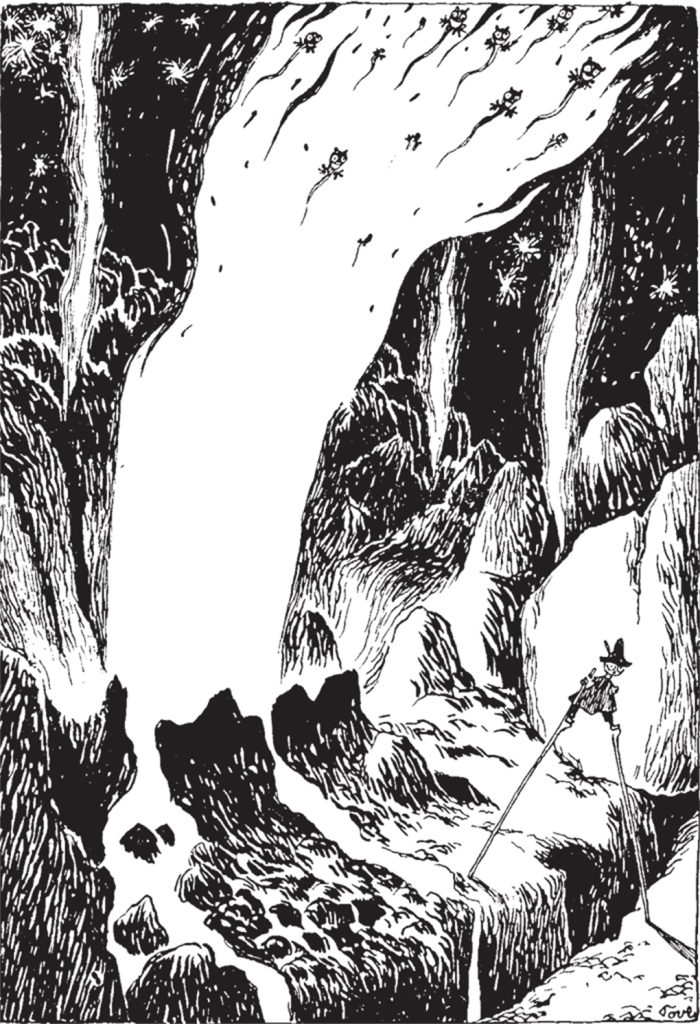 From Comet in Moominland. ©the estate of Tove Jansson
From Comet in Moominland. ©the estate of Tove Jansson
Jansson illustrated the Moomin stories herself, and her pen-and-ink drawings are some of the best things about the books. The illustrations for the first book in the series, Comet in Moominland, are especially striking; some of them are a cross between a kind of nightmare Lovecraftian landscape and the surreal imagery of William Hope Hodgson’s The Night Land.
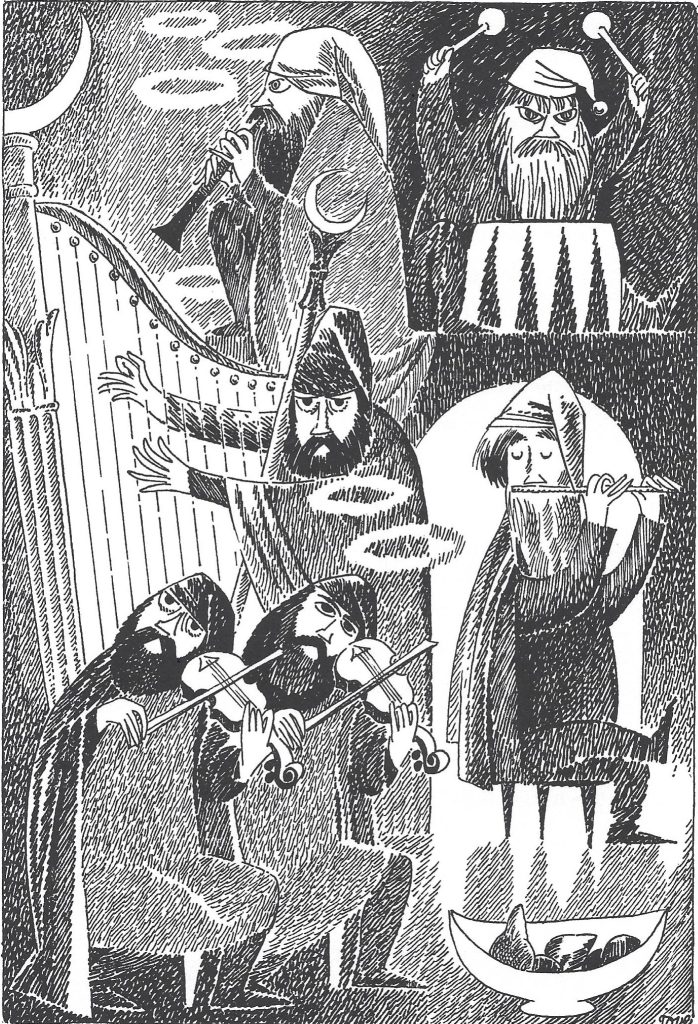 The Dwarves. ©the estate of Tove Jansson
The Dwarves. ©the estate of Tove Jansson
Though I’ve steadily been working my way through the Moomin books, I wasn’t aware until I had the Finnish Hobitti in my hands that Jansson had illustrated anyone else’s work. One look at her gorgeous cover illustration made me glad that she did. (There will always be a special place in my heart for a rampaging dragon.)
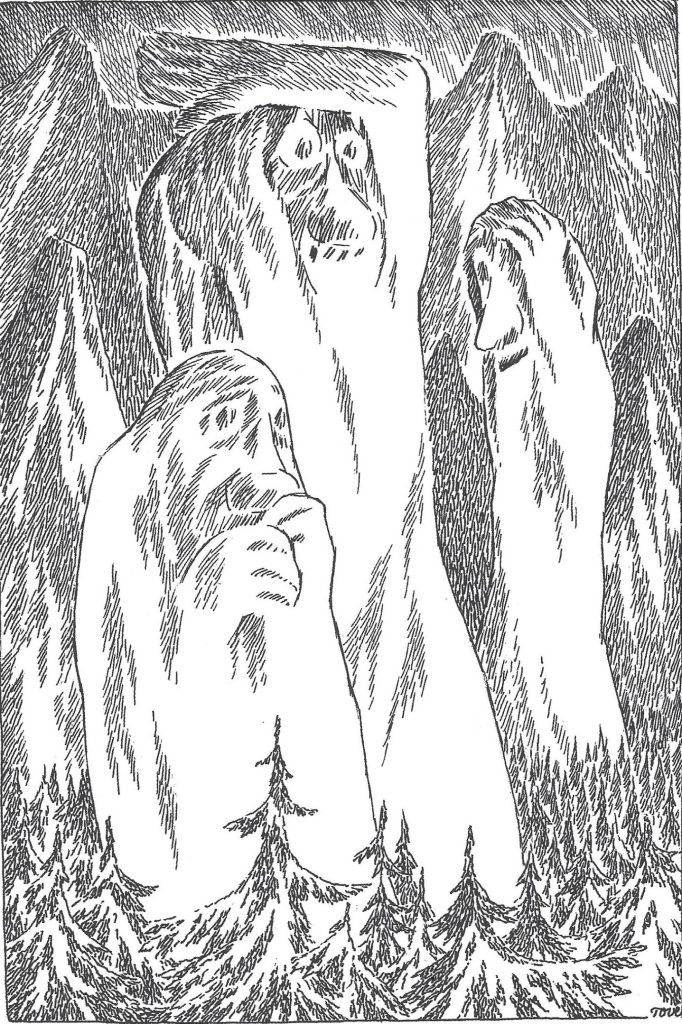 The Trolls. ©the estate of Tove Jansson
The Trolls. ©the estate of Tove Jansson
Jansson did her Hobbit illustrations for a 1962 Swedish edition (she was a member of Finland’s Swedish-speaking minority community) and they are refreshingly different from the more realistic renderings of Middle-earth and its inhabitants that are common today. She did twelve full-page black-and-white drawings for the book, another ten that cover half to a third of a page, and many smaller drawings that decorate the beginning or end of chapters.
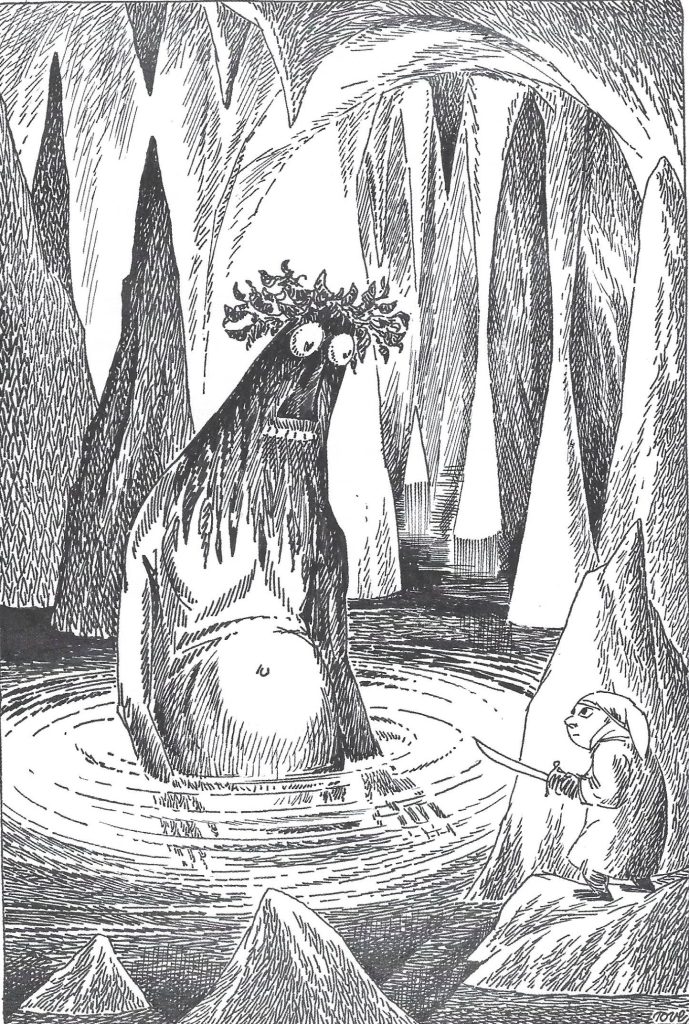 Bilbo and Gollum. ©the estate of Tove Jansson
Bilbo and Gollum. ©the estate of Tove Jansson
One thing that will immediately stand out to any Tolkien lover who flips through Jansson’s Hobitti is her visualization of Gollum. In Jansson’s drawings he’s huge, towering over Bilbo, and when Tolkien saw these illustrations, he supposedly realized that he had never specified exactly how large the slimy creature was, and so made the appropriate corrections for the Hobbit’s next edition, cutting Bilbo’s antagonist down to size.
 The Wargs. ©the estate of Tove Jansson
The Wargs. ©the estate of Tove Jansson
Jansson’s Tolkien illustrations are all her own; they’re not like any other rendition of Middle-earth that I can think of, and in comparing these wonderful pictures with more current ones, you can glimpse an older tradition, one that has its roots in the “North” that Tolkien loved, one that goes back to the sagas and Norse eddas that gave him his inspiration.
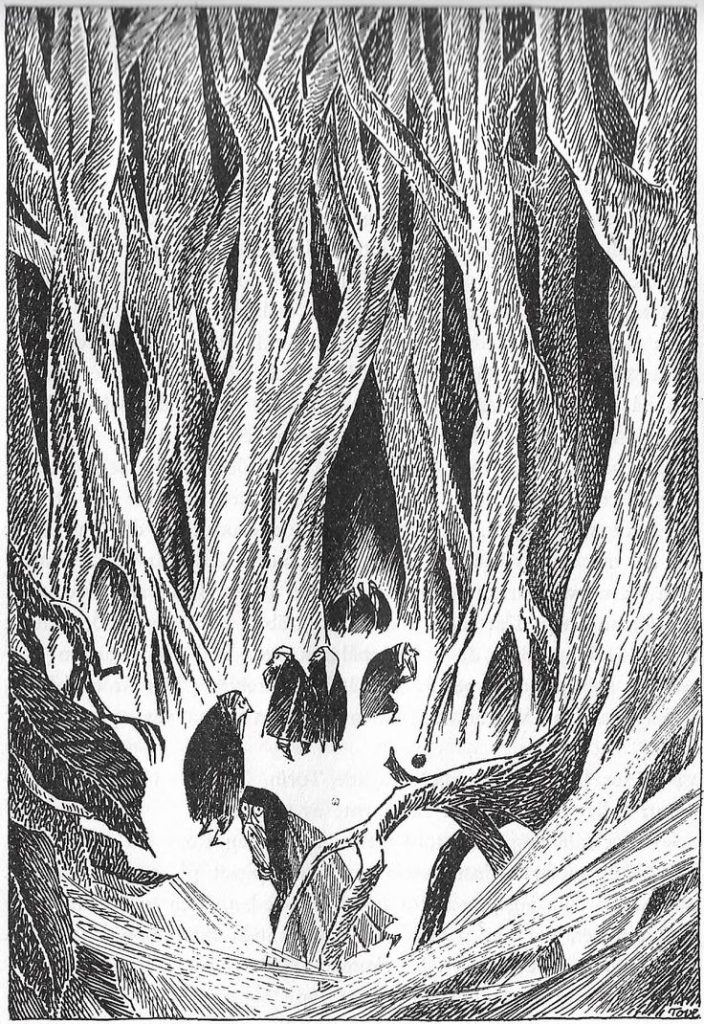 Mirkwood. ©the estate of Tove Jansson
Mirkwood. ©the estate of Tove Jansson
These simple-looking illustrations may not be to the taste of folks raised on fantasy photorealism (of course, in the hands of a true artist, there are few things deeper and more nuanced than simplicity), but I love them; their bold, expressionist lines combine the weird and the whimsical, the humorous and the beautiful, all with echoes of the heroic and the epic. I think Tove Jansson was a perfect match for Tolkien and his world.
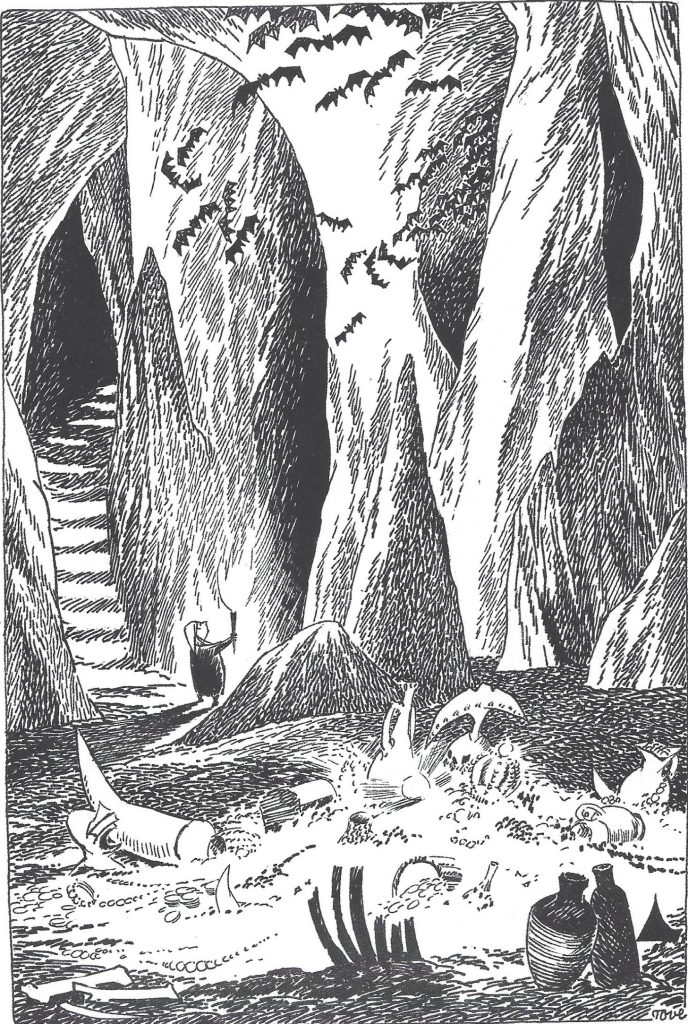 Smaug’s Treasure. ©the estate of Tove Jansson
Smaug’s Treasure. ©the estate of Tove Jansson
Just the other day I found out that Jansson did illustrations for Lewis Carrol’s Alice’s Adventures in Wonderland; NYRB Classics has just published a new edition featuring her drawings. Seeing what sparks Carrol’s story struck from Jansson is a rabbit hole I can’t wait to go down.
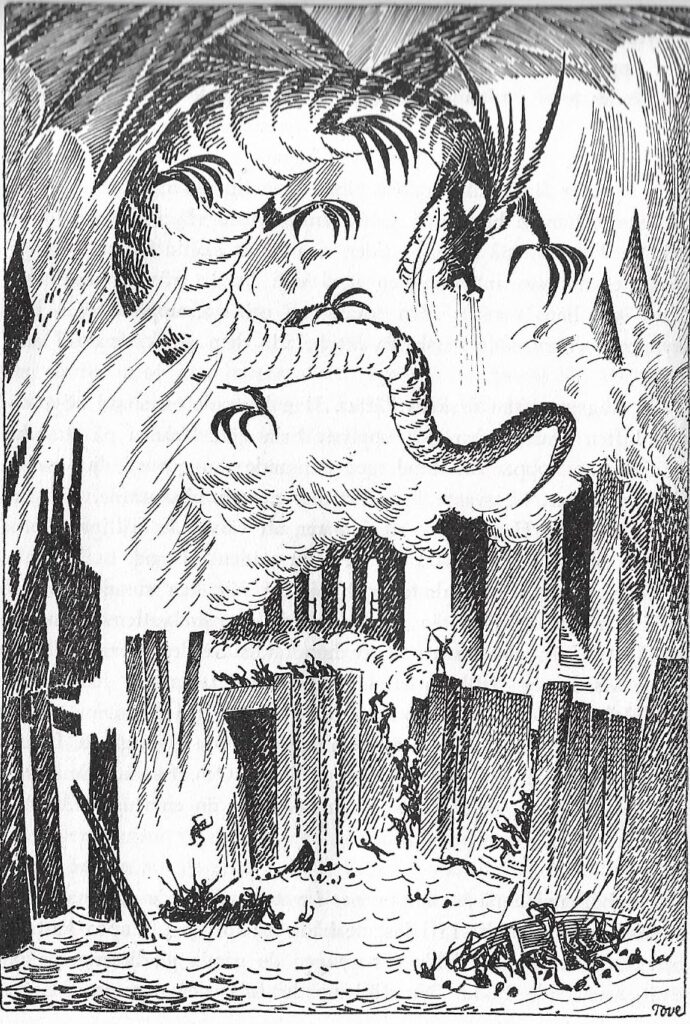 Smaug destroys Lake-Town. ©the estate of Tove Jansson
Smaug destroys Lake-Town. ©the estate of Tove Jansson
Until I can report back on Jansson’s Alice, I commend her Hobitti to you (her Moomin books, too), and I leave you with this:
Kaikki asekuntoiset ihmismiehet ja suurin osa haltiakuninkaan joukoista valmistautuivat marssimaan pohjoiseen Vuorta kohti. (What does that mean? I dunno, but it comes at the end of chapter Tulta Ja Vettä.)
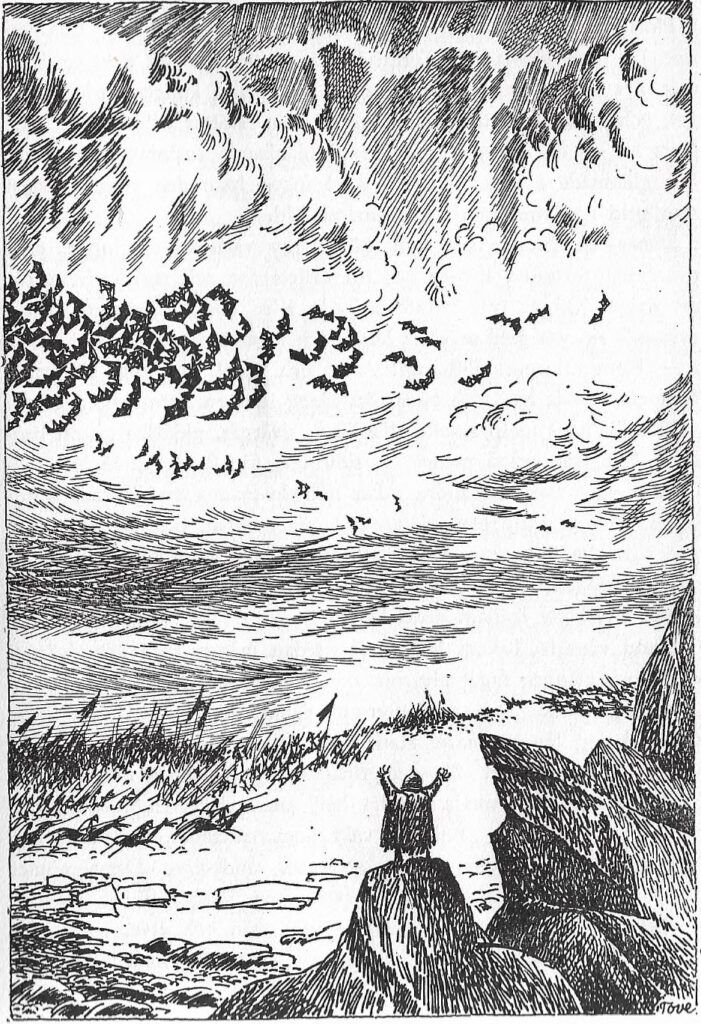 The Battle of Five Armies. ©the estate of Tove Jansson
The Battle of Five Armies. ©the estate of Tove Jansson
Thomas Parker is a native Southern Californian and a lifelong science fiction, fantasy, and mystery fan. When not corrupting the next generation as a fourth grade teacher, he collects Roger Corman movies, Silver Age comic books, Ace doubles, and despairing looks from his wife. His last article for us was The Lost World
Nosferatu: Was It the Time Change What Killed The Beast?
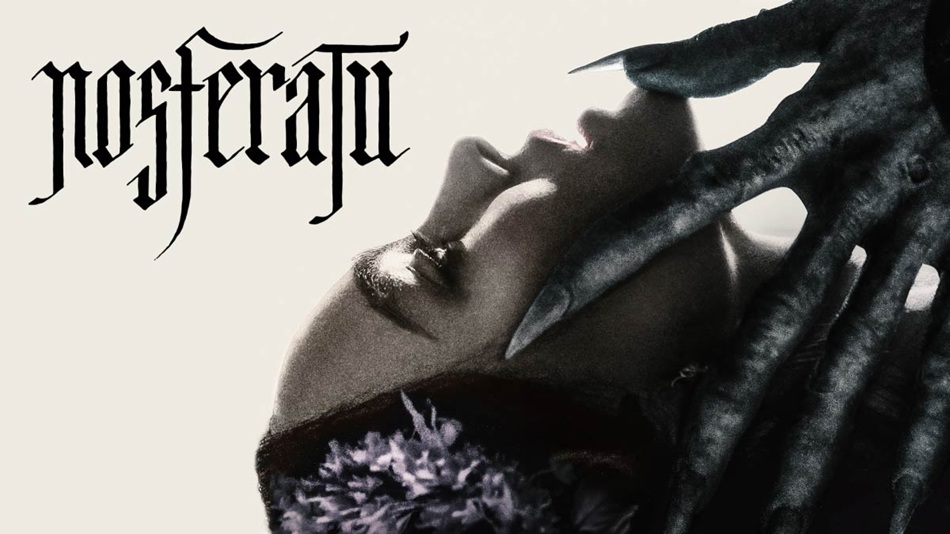 Nosferatu, written and directed by Robert Eggers, based on Nosferatu: A Symphony of Horror (1922), written by Henrik Galeen, and Dracula, penned by Bram Stoker in 1897.
Reboots and Adaptations
Nosferatu, written and directed by Robert Eggers, based on Nosferatu: A Symphony of Horror (1922), written by Henrik Galeen, and Dracula, penned by Bram Stoker in 1897.
Reboots and Adaptations
Okay. So I finally got around to watching Eggers’ version of FW Murnau’s classic from 1922, Nosferatu: A Symphony of Horror. By now, I think everyone knows the story behind FW Murnau’s Nosferatu, but here’s a brief summary: Murnau’s Nosferatu was an unauthorized adaptation of Bram Stoker’s Dracula, changing character names and locations but retaining the core plot elements. The film, which originally claimed to be adapted from Stoker’s novel, was made to avoid copyright issues and was eventually subject to legal action that nearly destroyed all prints.
Despite the name changes and some alterations, the film’s narrative largely follows Dracula’s journey, with the protagonist, Count Orlok (instead of Dracula), traveling to a new land — Romania to Germany, instead of Transylvania to England — and spreading a plague. Eggers’ reboot is definitely well made and impressive, and it has an other-worldly feel to it. It’s different from other vampire films. That being said, the original silent version is way creepier.
Now, allow me to digress for a paragraph or so. In 1979, there was a remake of the film — Nosferatu the Vampyre, known in Germany as Nosferatu: Phantom of the Night — directed by Werner Herzog and starring Klaus Kinski as Count Dracula. Yes, all Stoker’s character names were used in this film version. Not a bad film, but a bit anemic, you should pardon the pun. There’s also a fun flick from 2000 called Shadow of the Vampire, a fictional telling of the making of the silent Nosferatu, in which Willem Dafoe (who also has a role in Eggers’ version) stars as Max Schreck, the real name of the actor who first played Nosferatu. The twist is this: Max Schreck is a real vampire — a vampire playing a human actor who’s playing a vampire. (Sort of a Victor/Victoria, with blood.) Now where was I? Oh, yeah.
Expect SexFirst off… yes, sex is at the heart of Eggers’ Nosferatu. Sex is at the heart of Stoker’s novel, which was written in the sexually repressed Victorian Era. Sex plays a part in almost every vampire film I’ve ever seen. Francis Ford Coppola’s Bram Stoker’s Dracula (1992), for example, is loaded with sex and nudity, like the Three Brides feeding on Keanu Reeves, one of whom is Monica Bellucci. There’s also a wild scene between Dracula (Gary Oldman), in wolf manifestation, humping Lucy Westenra (Sadie Frost.) Then there’s the love scene between Mina Harker (Winona Ryder) and Dracula, where she licks his blood off his chest.
So there’s nothing new on the sexual theme and subtext of this latest version of Nosferatu. In fact, Nosferatu owes a lot to Coppola’s Dracula, a film I am quite fond of, in spite of some cringe-worthy acting, dialog and miscasting. Gary Oldman was fantastic; he owns that role and that film, just as Lily-Rose Depp, the real star of Nosferatu, owns this film. I’ll come back to her.
AtmosphereEggers’ Nosferatu owes a lot to Coppola’s Dracula in its use of shadows and some “camera tricks.” It also boasts some exquisite scenery and set design, which convey the ideal atmosphere for the story. The cinematography by Jarin Blaschke is masterful, the film score by Robin Carolan is spot on, and there are some haunting audio FX that add to the grimness of this film. The script pretty much follows the plot of the original screenplay by Henrik Galeen, but doesn’t owe much to Bram Stoker, other than his novel being the inspiration for the original, silent film.
I found this extended version to be a bit — (a bite?) — too long (in the tooth?) because it was almost deadly-dull at times. It moved as slowly as a corpse first waking up as one of the Walking Dead. The film spent too much time on mood and set up, and the first two acts I found to be somewhat tedious and boring. Not enough was happening! I did not find it at all exciting. It was like watching a pair of heroin addicts playing chess. The third act picked up some energy, but by then I was yawning. The plague of rats was pretty cool, though. There are a lot of rats in this film. I mean, a lot of rats.
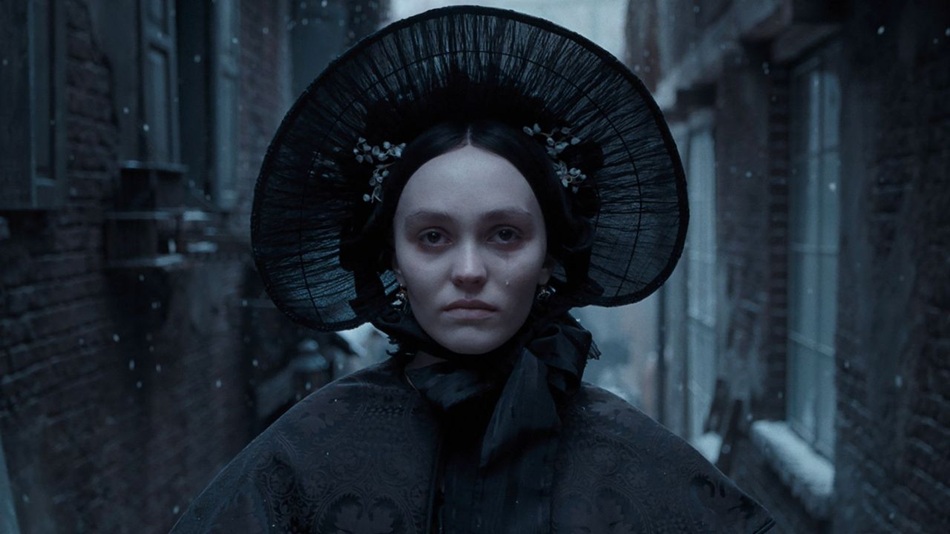 Lily Rose from Nosferatu 2024
Casting
Lily Rose from Nosferatu 2024
Casting
The cast was capable but not exceptional. They did their jobs and they did well enough. Willem Dafoe did a stand-up job, however, and in only one brief scene does he go over the top. I just couldn’t get emotionally attached or involved with any of the characters — except for Lily-Rose Depp. This is her film and she totally owns it. Her performance as Ellen Hutter (Mina Harker, in Stoker’s novel) is powerful and spot-on in every scene. She nails it and steals the show. She is put through the emotional ringer in this film — loving, angelic, quirky, possessed, demonic — you name it, she throws it all up there on the screen. She blew me away with a solid, heroic performance that was never over-the-top. She was brilliant. Her self-sacrifice in the final act is a powerful scene, and a sad one, as well.
As for the two kids who play the children of Anna Harding and Frederich Harding (Emma Corrin and Aaron Taylor-Johnson) I found them to be as annoying as a blister on the tip of my big toe, and when Nosferatu feeds on them, I cheered him on. It’s a brief, darkly-lit scene that quickly shift’s to Anna who sees her children being devoured, and the look on her face and her scream of horror, followed by her final fate, is chilling. That was a good bit. As for Bill Skarsgård, the other major player in Nosferatu and the title character…
I’m a fan. I’ve enjoyed his work in such films as John Wick, The Crow, and as Pennywise in the theatrical version of Stephen King’s IT — a feat of acting that, considering Tim Curry’s wonderful Pennywise, I applauded because he made the role his own: his Pennywise was the only good thing about that version of King’s novel.
But as for his take as Nosferatu… it didn’t work for me at all. I did not care for the make-up or the way he portrayed the character. There was nothing “supernatural” about him. He was just a force of evil, more like a big, hulking brute… and maybe that’s what Eggers wanted. I know The Last Voyage of the Demeter was not very well received, but I enjoyed that film and got a genuine sense of Dracula as being demonic, sorcerous, powerful, and evil. I didn’t get any sense of what Nosferatu felt for Ellen (Mina), no lost love, no real idea of why he wanted her, nothing about her being the reincarnation of a lost love. He says something about her not being of this world, of not being human or belonging to the living world — whatever. I must have missed something about how they were connected, but I’m not going back to “watch again,” at least not for the time being.
When Skarsgård’s dialog was in Romanian, it was subtitled in English. But when he spoke English, his accent was very difficult for me to understand. I was like, “What the hell is he talking about?” I kept expecting the villagers from Young Frankenstein to show up and shout in unison: WHAT?
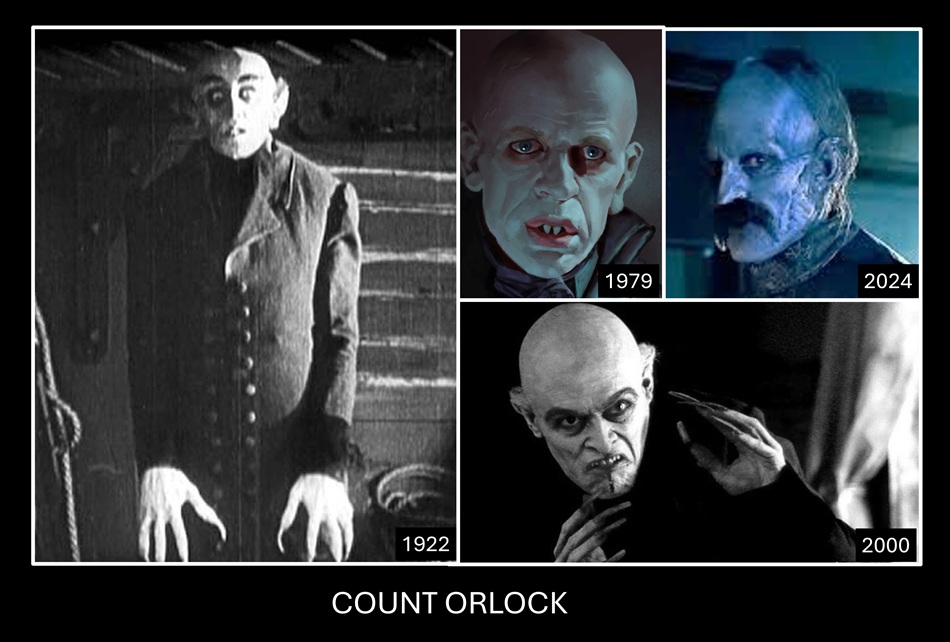 1922 MAX SCHRECK Nosferatu; 1979 KLAUS KINSKI Nosferatu the Vampyre; 2000 WILLEM DAFOE Shadow of the Vampire; 2024 Bill Skarsgård Nosferatu
Omnipotent Vampire Ignores Chicken, Dies
1922 MAX SCHRECK Nosferatu; 1979 KLAUS KINSKI Nosferatu the Vampyre; 2000 WILLEM DAFOE Shadow of the Vampire; 2024 Bill Skarsgård Nosferatu
Omnipotent Vampire Ignores Chicken, Dies
Now, here’s the problem I always had with the original version of Nosferatu, and with this one, too. I find it funny that an ancient, demonic, powerful vampire could become so besotted with blood and sex that he doesn’t see the sun rising and doesn’t pay attention to the cock’s first crowing. By the time of the second crowing, it’s too late. Didn’t he see or feel the sunlight shining through that honking-big window? Did he leave his watch at home? Did he forget about the time change? Or… maybe he knew that there was nowhere he could run and hide, because the coffin(s) full of his native soil had been destroyed. Or was this his fate, his desire — to perish in the arms of Ellen Hutter? I think that was it, because he could have let anyone destroy him at any time, if he wanted death and oblivion, but he wanted her to be his doom, he wanted to take her with him, to be with him forever in death. But what do I know? I’m not a real film critic. I’m just hear to entertain you Black Gate readers.
Check Out My DisappointmentI do not hate or dislike this version of Nosferatu. I am just disappointed in it. All the hype about this film, the word-of-mouth, gave me expectations of something I imagined would be a revelation, a landmark in moving pictures and vampire flicks in general. Thus, not getting what I expected, I was disappointed. It happens. And that’s on me. But if you haven’t seen the film, don’t let my review stop you from doing so. Check it out. You might like it. I’m sure I’ll watch the film again. Maybe it will grow on me. There are many favorite films I did not enjoy on first viewing, and vice versa, too. Anyway, Nosferatu was a big hit, it’s popular and made lots of $$$$$, so that should tell you something. One thing I do know… Lily-Rose Depp is going to have one helluva fine film career. I look forward to seeing her in more films.
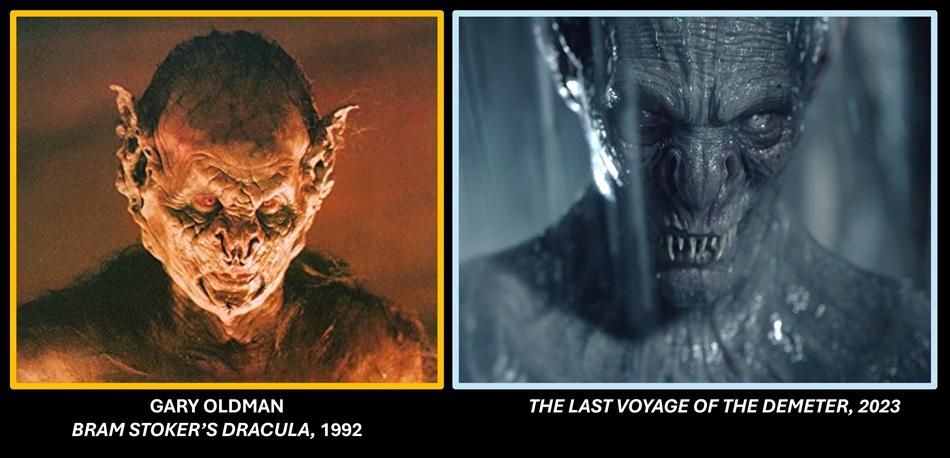 Left: GARY OLDMAN – BRAM STOKER’S DRACULA, 1992 Right: THE LAST VOYAGE OF THE DEMETER, 2023
Left: GARY OLDMAN – BRAM STOKER’S DRACULA, 1992 Right: THE LAST VOYAGE OF THE DEMETER, 2023
Joe Bonadonna is the author of the heroic fantasies Mad Shadows — Book One: The Weird Tales of Dorgo the Dowser(winner of the 2017 Golden Book Readers’ Choice Award for Fantasy); Mad Shadows — Book Two: The Order of the Serpent; Mad Shadows — Book Three: The Heroes of Echo Gate; the space operaThree Against the Stars and its sequel, the sword and planet space adventure, The MechMen of Canis-9; and the sword & sorcery pirate novel, Waters of Darkness, in collaboration with David C. Smith. With co-writer Erika M Szabo, he penned Three Ghosts in a Black Pumpkin (winner of the 2017 Golden Books Judge’s Choice Award for Children’s Fantasy), and its sequel, The Power of the Sapphire Wand.
He also has stories appearing in: Azieran: Artifacts and Relics; Savage Realms Monthly (March 2022); Griots 2: Sisters of the Spear; Heroika I: Dragon Eaters; Poets in Hell; Doctors in Hell; Pirates in Hell; Lovers in Hell; Mystics in Hell; Liars in Hell; Sinbad: The New Voyages, Volume 4; Unbreakable Ink; Poetry for Peace; the shared-world anthology Sha’Daa: Toys, in collaboration with author Shebat Legion; and with David C. Smith for the shared-universe anthology, The Lost Empire of Sol.
In addition to his fiction, Joe has written numerous articles, book reviews and author interviews for Black Gate online magazine.
Four Things I Think I Think: May 2025
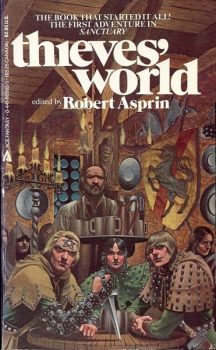 Time to share a few things I Think I Think.
Time to share a few things I Think I Think.
I mean, what’ the point of having your own blog column if you can’t share your opinion on whatever you want to? Right???
1 – The Black Company Remains One of My Favorite Series’
I’ve written multiple times that audiobooks fit my lifestyle these years. I still enjoy reading a print book, and the digital format has made a LOT of long out-of-print Pulp, available. But I listen to audiobooks while I work, write, game, drive, and even fall asleep. I get to stuff I’d not, otherwise.
Last year I listened to the entire Black Company series (minus Port of Shadows). I have read the entire thing at least three times through, and this was my first listen. Last month, as I was doing a couple of long runs, I decided I wanted to listen to The Black Company (book one). during them. And here I am a month later, on Water Sleeps, the second-to-last book (I only have Port of Shadows in hardback, so excluding that from the discussion at present).
The initial trilogy is definitely my favorite part. The last two, my least. But this foundational series in the dark fantasy/grimdark subfield, endures. It remains a terrific read/listen, and I’m excited that the new chapter kicks off this Fall with Lies Weeping (an internet scoop provided by your hard-working columnist last year, here on Black Gate).
The books are told from different characters’ viewpoints, so there are different narrators. They all work, but I like Marc Vietor (Croaker) the most.
If you’ve never read The Black Company, you’re missing out on one of fantasy’s best. If you have read it, you should definitely check out Fletcher Vredenburgh’s series on it, here at Black Gate.
2 – Thieves World Deserves ‘Rediscovery’ Through the AudiobooksI began reading the marvelous shared-world universe of Thieves World back in the eighties, not long after it started. I’ve re-read it multiple times, and I have almost all the spin-off books. MANY an RPG thief/rogue has been named Shadowspawn. And Molin Torchholder has been in play for clerics.
I was thrilled last year to discover that in August of 2023, Audible started carrying the first four Thieves World books! I immediately got all of them, narrated by Jonathan Johns. He sounds like Mackenzie Crook (Gareth in the British The Office; the one-eyed pirate in the Johnny Depp movies). He was an excellent choice.
They just dropped books five and six this month. Kim Morton is the new narrator for five. It’s a step down – his voice is kinda thin. It still works, but John was better. We’ll see how Noni Alley is with book six.
Listening to these audiobooks brings back the magic of Thieves World. I prefer the first books to the latter ones (the Beysib arrival felt like a shifting of the series, to me), so I’m happy these early ones are out. Thieves World was one of the early dark fantasy series, and a terrific multi-author universe. I despise Lynn Abbey’s short-lived reboot, and I wouldn’t listen to those books if they recorded them.
I am a fan of Janet Morris’ spin-off trilogy,with Tempus and the Stepsons fighting the wizards of the Mygadonian Alliance. All three came out last year on Audible, using an AI narrator. I think audiobooks should use human narrators. But I’m not intrinsically opposed to virtual voices. I assume cost is a significant factor; Several of Morris’ older books are now on Audible, with AI narration. I bought volume two, Beyond the Veil, after re-reading book one. It’s a bad narration. Now, I’ve listened to several bad human narrators. But this wasn’t very good. It definitely felt like a computer, not a human. I didn’t bother to get the third audiobook. And it’s the same voice used for one of her old Heroes in Hell books – I passed on that, as well.
But I’m definitely glad they have put out these Thieves World books, and I hope they do the whole original series. Definitely recommended to read and listen to.
3 – The Animated Clone Wars is Terrific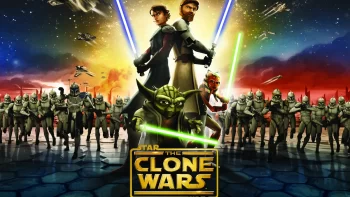 Star Wars Rebels was a really good series with a lot of lore added into the saga. I had seen a few episodes here and there of The Clone Wars, as well as a couple Bad Batch episodes. Clone Wars is my son’s favorite animated series in any genre: and he likes a lot of them. I decided to watch it from start to finish in an attempt to relate better to my teenager (good luck with that – I know).
Star Wars Rebels was a really good series with a lot of lore added into the saga. I had seen a few episodes here and there of The Clone Wars, as well as a couple Bad Batch episodes. Clone Wars is my son’s favorite animated series in any genre: and he likes a lot of them. I decided to watch it from start to finish in an attempt to relate better to my teenager (good luck with that – I know).
Man, this is a terrific series. Love all the lore added/expanded on; the visual style; the action scenes: it’s all excellent. Episodes are a bit less than 25 minutes I think, and easy to binge in small numbers. I’m into season two (there are seven seasons and one hundred thirty three episodes) and while I still find Jar Jar annoying as hell, I like everything about this series. The light saber fights are really cool.
If you like the Star Wars universe and haven’t seen this show yet, you are definitely missing out – like I was. And the Bad Batch was introduced near the end of the original show, and it’s a spin-off series you can follow up with.
There’s a Clone Wars ninety-minute movie that takes place right before the first episode of the Clone Wars series. It introduces Asohka as a padawan. I watched it after watching season one. That didn’t affect anything, and it’s definitely worth watching.
Highly recommend Clone Wars. And if you haven’t seen Rebels, it fills in some of the gap leading right up to the start of the first movie. And, the live-action Asohka series picked up the Rebels story line. Very recommended.
4 – Robert E. Howard Continues to Enthrall Me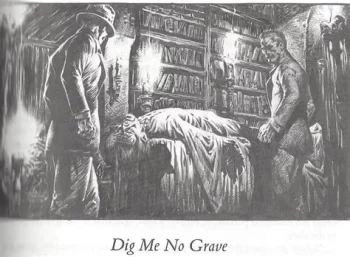 John D. MacDonald remains my favorite writer of all time – any genre. I’m overdue for another dive into his short novels, but that’s just not on tap at present. However, I am continuing to read and re-read my second-favorite: the pride of Cross Plains.
John D. MacDonald remains my favorite writer of all time – any genre. I’m overdue for another dive into his short novels, but that’s just not on tap at present. However, I am continuing to read and re-read my second-favorite: the pride of Cross Plains.
I’ve got the third and final Kirby O’Donnell post coming for the Summer Pulp series (there were only three stories). I’m sure 2026 will see me ruminating on the one Steve Clarney story. But as I re-read “The Curse of the Crimson God,” as always, I was in awe of Howard’s writing skill. His prose is fantastic. He writes battle as well as anyone I’ve discovered. But his use of words, relentless pacing, and facility for spellbinding the reader, feels fresh every time.
I have a post on his occult detectives, Conrad and Kirowan, ready for the Summer. Horror is not my thing, but Howard was a master in that genre, as well. My love of MacDonald goes back more than forty years – he was a master. But Robert E. Howard may be unequaled at what he wrote. Even the prose in his Conan stories rises above the common perception of Pulp, and sword and sorcery. I may not love every story he wrote, but I am rarely disappointed in the writing (Breckenridge Elkins is totally an exception).
If you haven’t discovered REH – or only know Conan – get a couple volumes in the fantastic Del Rey series (they used the original unedited texts) and discover a true American treasure.
Not 5 –I wanted the fifth item to be me praising the terrific documentary, Welcome To Wrehxam. Ryan Reynolds and Rob McElhenney bought the Welsh soccer (football) club in Wrexham, in 2001. The whole thing has been covered in a wonderful documentary. The first episodes of season four dropped earlier this month. I’m not caught up yet.
But it is SO watchable. The owners, the team, the staff, and the town – you will get invested in all of them. The boys have (sometimes painfully) plugged in a lot of cash, and reaped ongoing success. Ryan and Rob are really fun and likable guys.
I’ll talk about Wrexham in a future What I’m Watching installment.
Prior Ten Things I Think I Think
Six Things I Think I Think (March 2025)
Ten Things I Think I Think (January 2025)
Ten Things I Think I Think (December 2024)
Nine Things I Think I Think (October 2024)
Five More Things I Think: Marvel Edition (September 2024)
Ten Things I Think I Think: Marvel Edition ( September 2024)
Five Things I Think I Think (January 2024)
Seven Things I Think I Think (December 2023)
Talking Tolkien: TenThings I Think I Think (August 2023)
A (Black) Gat in the Hand: Ten Things I Think I think (August 2023)
5 More Things I Think (March 2023)
10 Things I Think I Think (March 2023)

Bob Byrne’s ‘A (Black) Gat in the Hand’ made its Black Gate debut in 2018 and has returned every summer since.
His ‘The Public Life of Sherlock Holmes’ column ran every Monday morning at Black Gate from March, 2014 through March, 2017. And he irregularly posts on Rex Stout’s gargantuan detective in ‘Nero Wolfe’s Brownstone.’ He is a member of the Praed Street Irregulars, founded www.SolarPons.com (the only website dedicated to the ‘Sherlock Holmes of Praed Street’).
He organized Black Gate’s award-nominated ‘Discovering Robert E. Howard’ series, as well as the award-winning ‘Hither Came Conan’ series. Which is now part of THE Definitive guide to Conan. He also organized 2023’s ‘Talking Tolkien.’
He has contributed stories to The MX Book of New Sherlock Holmes Stories — Parts III, IV, V, VI, XXI, and XXXIII.
He has written introductions for Steeger Books, and appeared in several magazines, including Black Mask, Sherlock Holmes Mystery Magazine, The Strand Magazine, and Sherlock Magazine.
You can definitely ‘experience the Bobness’ at Jason Waltz’s ’24? in 42′ podcast.
When Satire is Overwhelmed by Reality: Moon Missing: Edward Sorel’s Report on Future Events
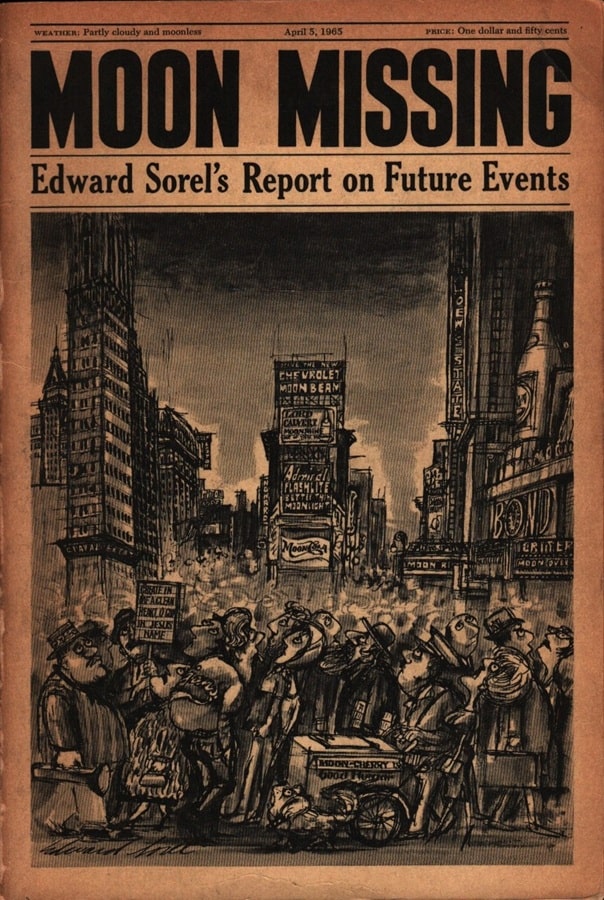 Moon Missing (1962)
Moon Missing (1962)
At about 1:46 am EST in the middle of the American night of April 4, 1965 the Moon disappeared. The American people were informed the next day at a Presidential news conference. President Kennedy was in no way responsible, said Allen Dulles, disgraced former CIA director but now Secretary of the Exterior, tapped to safeguard American interests in outer space.
Cartoonist, caricaturist, satirist Edward Sorel published Moon Missing in 1962. He had no need to prognosticate the future; the world around him gave him all the ammunition his ink Speedball B6 required.
So insistent are we today that the early Sixties were a more innocent time that the reality of the fear, paranoia, tension, and general unhappiness of the era can only be exhumed from period pieces. Sorel’s vision of the craziness ready to be let loose by a global event relied heavily on contemporary names in the news, but to find frighteningly many parallels in today’s world the names need only to be changed to modern equivalents.
 Edward Sorel in 1962
Edward Sorel in 1962
Born Edward Schwartz in 1929, Sorel found his artistic future while spending a year in bed as a child, much as young Richard Starkey found the drums as solace during a similar confinement. Still alive today and very much the Grand Old Man of caricature and cartoon satire with an endless catalog of important works, Sorel was a struggling freelancer in 1962. His early books for adults were such failures that even his own website doesn’t bother to mention them. To supplement the advertising work he was building a reputation for, he sent his satires out to every magazine that would accept such heresy, keeping his name before the public.
Moon Missing was excerpted in the motley foursome of Horizon, Sports Illustrated, Show Magazine, and Caterpillar. Caterpillar? Since the avant garde The Caterpillar Magazine didn’t debut until 1967 and the children’s magazine of that name was far in the future, I am forced to conclude he meant Caterpillar News and Views, the house magazine of the bulldozer giant. To imagine the improbability of that Venn diagram, try to conjure an appearance by R. Crumb in IBM’s THINK magazine. My brain boggles.
Moon Missing is set as a series of brief daily newspaper reports from the alternate future of 1965, the foundation Sorel uses for his plethora of illustrations. The double-page below sets the tone. New Yorkers parade down the sidewalk, oblivious to all but their smartphones – I mean, newspapers – while the news ticker accuses the Communists for the disappearance.
First to react is the Gallup Poll. The public is eternally divided on all issues.
And politicians are eternally hypocrites.
Clueless politicians can be found in every era, but the sweetener here is the reminder that J. Edgar Hoover used the FBI as a personal internal police, a part of the past we should never want revisited. “Involves national security.” Ring any recent bells?
Every bit of today’s battle of right and left wings already existed in 1965.
So much commentary is packed into these two pages alone.
Lest you think Sorel was himself nothing more than a muddle-headed liberal, be assured that he applied his gimlet eye to the Kennedy administration as well.
Fortunately for the economy, capitalists will always find a way to cope.
As world tensions soar, Kennedy and Khrushchev meet and sign a Mutual Moon Aid Pact, and talk about complete disarmament. And then the worst possible news.
 Look at the date. July 4. If you were Khrushchev would you think that was a coincidence? Or would even Americans? So much for world peace.
Look at the date. July 4. If you were Khrushchev would you think that was a coincidence? Or would even Americans? So much for world peace.
And Sorel, the old advertising guy, can’t help but add a coda that triggers the memories of us graybeards.
The book should have been a bestseller. Unfortunately for Sorel’s career, Moon Missing was published on the first day of the sensational and long-lasting New York newspaper strike. Few events speak more to New York’s absolute cultural dominance over the country in the early sixties. All other media took their cues from the New York papers. Anything not reviewed there had little chance of notice, much less success, elsewhere. The rave review in the Tampa Tribune didn’t save it. Kennedy’s assassination the next year thoroughly destroyed any chance of a later revival; reading about a living Kennedy presidency in 1965 would be little more than a sick joke, sicker than the ones Sorel actually told. (The hard-luck Sorel later created a poster attacking the war-mongering Cardinal Spellman of New York, but it was released the day the cardinal died. Live by satire, die by irony.)
The good news is that in 1963 Sorel was named art director of Monocle, a magazine of savage political satire that matched his sensibilities perfectly. From there he went to Ramparts, New York, and the National Lampoon, and was discovered by more mainstream magazines, seldom disguising his disdain for all that was wrong with society and politics. For me he will always be indelibly etched in my memory for his nsfw drawing of a rockette line of nude world leaders covering their private parts with large erect rockets pointed at the rest of humanity. If you dare, search for Robert Scheer’s Thinking Tuna Fish, Talking Death: Essays on the Pornography of Power, the most perfect title for a Sorel cover ever devised.
ETA: I have a coda as well and it may be less believable than Sorel’s satire. We live in a time when satire is overwhelmed by reality. Only datelines can differentiate them. While writing this article my eye was caught by a report on American First Policy Institute ambassador Kambree Nelson. Nelson was invited to the White House’s “new media” press conference for influencers where she gained attention for a particularly softball question, leading the curious to check her history. They quickly discovered that in October 2024 she sent a Xitter out to her 625,000 followers: “Has anyone seen the moon lately? I’ve been looking for 7 days.” When even some of her followers told her that the moon was right up there, she replied. “It’s not out. None of my friends in 4 states can find it.”
Tom Lehrer once proclaimed, “Political satire became obsolete when Henry Kissinger was awarded the Nobel Peace Prize.” Ironically, both he and Edward Sorel have lived to see this brave new world. Irony may not be dead, but satire is limping with both feet.
Steve Carper is the author of hundreds of articles on fascinating, if obscure and forgotten, tidbits of history, as well as the seminal book Robots In American Popular Culture. All of his websites are linked at SteveCarper.com.
Tubi Dive, Part VII
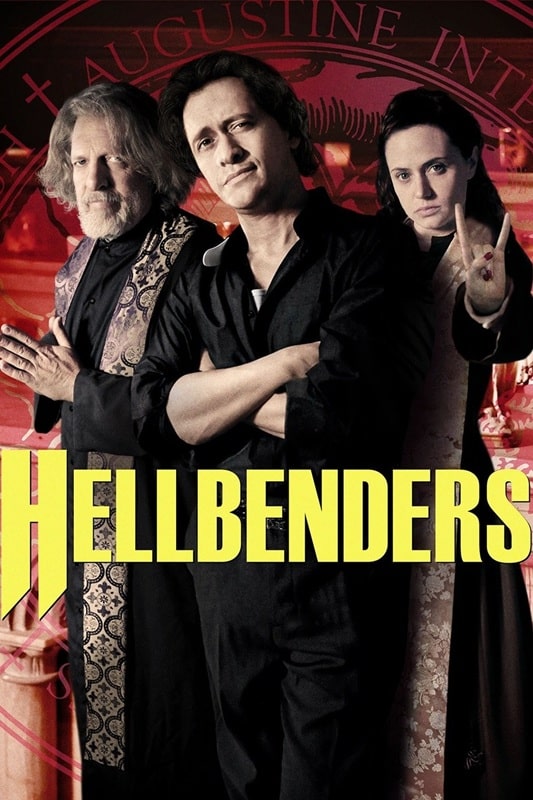 Hellbenders (Lionsgate, October 18, 2013)
Hellbenders (Lionsgate, October 18, 2013)
50 films that I dug up on Tubi.
Enjoy!
Hellbenders (2012)I really should have saved this for later, for my exorcism watch-a-thon What Possessed You, but the mere thought of not watching a Clancy Brown movie kicked off my hives.
Hellbenders is an unholy romp written and directed by J.T. Petty (who brought us The Burrowers, among others) based on the graphic novel of the same name.
It concerns a secret order of multi denominational priests who are trained to defeat unbeatable demons. They do this by sinning as much as possible, then inviting the demon to possess themselves before committing suicide and dragging the entity to Hell. It’s a fantastic premise, and the numerous references to their sins (ranging from stealing newspapers and having disparaging thoughts, to committing adultery and colourful blasphemy) is a lot of fun. Priests aren’t sent out on exorcism missions if they’re not guaranteed to go to Hell.
Clancy Brown plays Father Angus, the leader of this motley troop, and possibly the greatest user of profanity I have ever seen. This film is worth it for his swearing alone, but for God’s sake don’t do a drinking game based on the number of times he says cocksucker — you will die.
Everyone in this cast does a great job, and I especially enjoyed Dan Fogel as a punchy priest, and Stephen Gevedon as ‘Clint’ (a hilarious animated segment reveals why “Clint’ shouldn’t be a superhero name).
The possessions are fugly, the violence is daft and bloody, and there’s lots of biting off of appendages.
I really enjoyed this one.
9/10
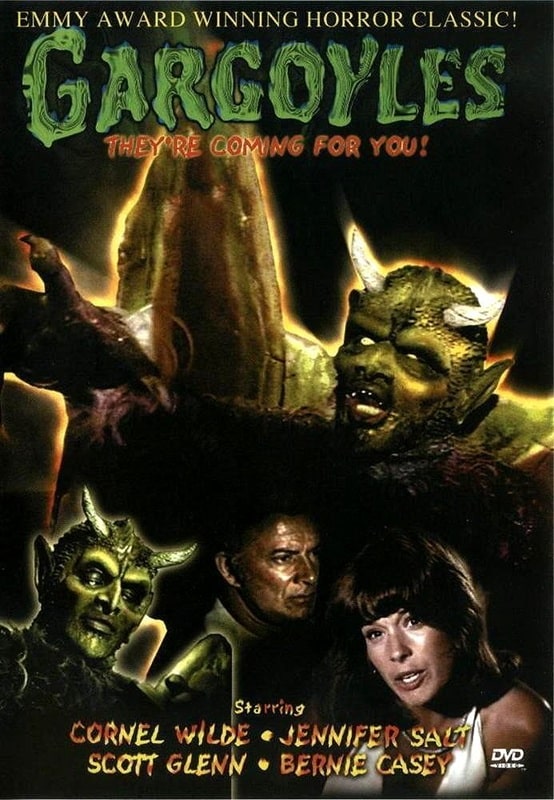
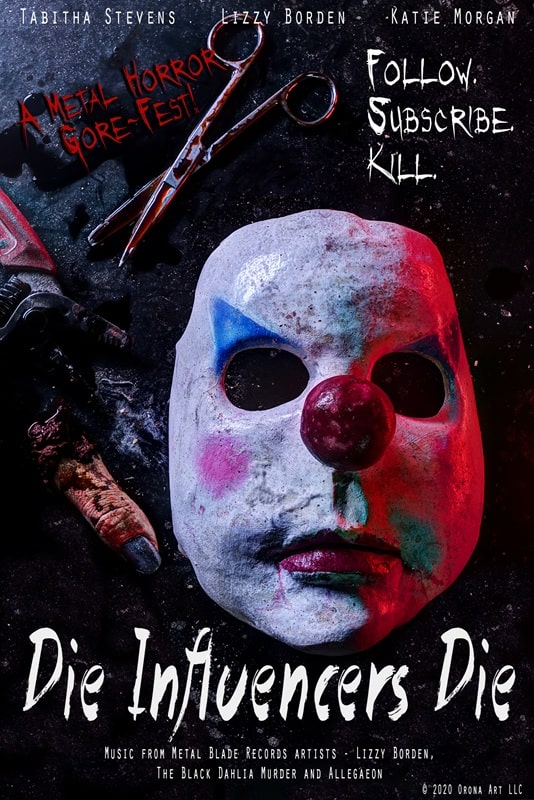
Gargoyles (CBS, November 12, 1972) and Die Influencers Die (Orona Art, 2020)
Don’t get excited, fans of the cartoon show (and potential Kenneth Branagh movie), this is a made for TV movie that was not bad for its time, and has developed something of a cult following.
Cornel Wilde and Jennifer Salt play Dr. Mercer Boley and his daughter, Diana. Dr. Boley is a leading authority on demonology, and his daughter feeds his obsession with trinkets she picks up around the world. They travel to a remote area in New Mexico called Devil’s Crossing — an area steeped in folklore and legend. There they encounter Uncle Willie, the owner of a roadside museum, who shows them a funky skeleton — before you know it, the gargoyles attack, and all hell breaks loose.
It’s a fairly tame flick, with a couple of slightly creepy moments, but the gargoyles don’t really stand up to scrutiny under the harsh lighting, and the action scenes are mostly choppy slow-motion. However, it licks along at a fair old pace, and it does feature Scott Glenn as a bad boy biker. You could say there’s an allegory blanketed under all of this regarding the treatment of indigenous peoples at the hands of settlers, but I ain’t here for no history lesson, mama.
Only recommended for the gargoyle-curious.
5/10
Die Influencers Die (2020)If you know me, there’s nothing I like more than seeing harm come to a) matadors, and b) internet pranksters, so this title obviously whetted my appetite.
Known in Germany as The Influencers, The (a Simpsons gag for loyal followers), this film is a low-budget schlock-fest with very little in the way of redeeming features. The nonsensical story concerns an abusive, toxic alpha-male influencer (a cross between Mr. Beast and Patrick Bateman) who wants to destroy the ‘careers’ of three rival influencers in order to ramp up his views. He does this by inviting them to a ‘haunted film studio’, then tries to give them dysentery with a made up energy drink that they are supposed to hawk for him. Little does he know that a malevolent demon is on site, and ready to chop up and eat anything in her path.
Said demon is the resurrected body of a model that was murdered by one of his assistants and stuffed in a fridge. She walks around at a jerky pace due to edited frames in a clown mask with duct taped nipples and a tutu. She’s apparently there for revenge, so why she kills the duped influencers (who did nothing to her) makes no sense. The whole thing is shot and edited like the most annoying music video you can think of, and is full of shock metal, partly due to the presence of Lizzy Borden as an illogical demon whisperer.
It’s annoying, grating and mean-spirited, and I can only recommend it to folks who like metal, plastic knockers and overacting.
3/10
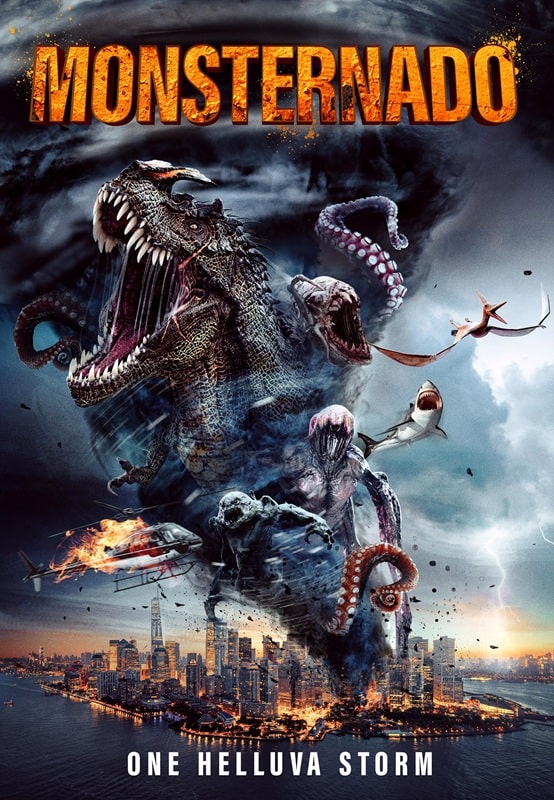
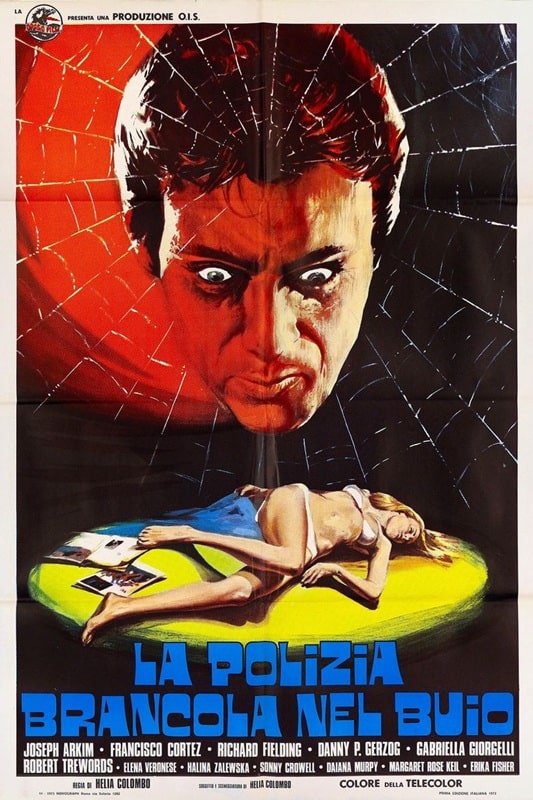
Monsternado (Uncork’d, November 14, 2023) and
The Police are Blundering in the Dark (O.I.S. Cinematografica, 1975)
Still on a kaiju high after Godzilla vs Kong, I foolishly tried to scratch my itch with this (potentially) fun flick. No sooner had it started, than I realized my mistake. It is an Uncork’d production.
Uncork’d makes The Asylum look like A24, but I bravely soldiered on.
Let’s get all the negativity out of the way. It’s not very good. The script is terrible, the acting is rubbish, and the effects are wonky at best.
I lied, here’s some more negativity. The thing that really irked me about this Sharknado knock-off was the filmmakers’ potential to do something really interesting with this idea. If you are going to have a plot reference mythical places like the Bermuda Triangle and Atlantis, then get some mythical monsters up in this windy shit.
As is, we are subjected to sharks, tentacles, gators, snakes, some token pterodactyls and aggressive scampi. If you’re going to spend the catering budget on CG, then at least make the monsters unique and fantastical.
I think it was supposed to take place in the US, but several shots of the Gherkin in downtown London, plus lots of dodgy American accents, gave up its true origins, and just keeping it set in England would have been a slight improvement.
It’s like I sometimes say to my children, “No, I’m not angry with you, just very disappointed.”
3/10
The Police are Blundering in the Dark (1975)Fancied a giallo, and this title caught my eye. It was originally titled The Salad Garden, and that would have made just as much sense, as there’s no actual coppers in this (ultimately rather dull) murder mystery.
The film has all the ingredients of a giallo, a POV killer dispatching young women, mandatory nudity, sexual repression, long talks around the dinner table, male hair product, but this one brings a science fiction twist to the proceedings. A wheelchair-bound photographer has invented a machine (the kind that goes wooo, woooo, and bathes the user in purple) that can photograph people’s thoughts — but this doesn’t really come into play until the end of the movie.
Instead we follow the apathetic investigation of a journalist looking for his missing friend while trying to pop the cherry of anyone he comes across. Being Italian and mid-70s, no one can be killed before their shirt has come off, in fact in the opening scene, the killer kindly tears his victim’s blouse so that she can gallop breastily through a copse before she becomes a corpse.
Possibly the most boring giallo I’ve ever watched, so I can only recommend it to fans of the Italian countryside, small cars, bosoms and lettuce.
4/10


Caddy Hack (Wild Eye Entertainment, December 10, 2023) and Blades (Troma Entertainment, 1989)
A double-bill, you lucky people. Here we have a pair of golf-related horror films that are on opposite ends of the quality spectrum.
Caddy Hack is bloody awful. It purports to be a comedy, but it is so desperately unfunny that I ended up hate-watching it for the final hour. The style of humor put me in mind of Mad Cow; self-referential, endlessly repeated (unfunny) jokes, deliberately rubbish effects, extreme mugging for the camera, horrible editing, and so on.
The story dispenses with the whole Caddy Shack plot, and instead focuses on the gophers, which in this steaming pile have been mutated by fertilizer. Throw in a Trumpy business owner, a thousand ‘ball’ jokes, and a Gremlins rip-off, and you have a recipe for a warm crap casserole. Avoid.
On the flip-side, Blades was an unexpected joy. I was honestly expecting a second-tier slasher featuring a lump of machinery, but I received a brilliant homage to Jaws, right down to the sound-alike music, story beats and set pieces. They played it straight, which elicited much more laughter from me than Caddy Hack, and a lot of thought was put into the direct adaptation of the original shark film. It gets better as the film goes on because you realize what’s coming up, and for this reason I wholeheartedly recommend Blades, especially for lovers of Jaws.
1/10 and 8/10 respectively.


Psycho Gothic Lolita (Pony Canyon, September 4, 2010) and Destroy All Neighbors (Shudder, January 12, 2024)
You did it! You’re about to read your 50th rubbish review of a film to be found in the bowels of Tubi!
It took me a while to settle on a final film. I started on Screecher of the Lagoon, but I’m tired of badly shot and acted efforts. I also started The Door in the Woods, but it was too serious for me to get into (I’ll return to it one day). So here we are.
Psycho Gothic Lolita (original title: Gothic & Lolita Psycho) sounded like a perfect fit. After all, I love psychos, I love ‘gothic’ and, um, I love psychos.
The film perfectly encapsulates the vibe of this entire watch-a-thon; bonkers action, extreme gore, body horror, dubious sexiness, and the sort of deadly umbrella that would make John Steed wet his pants.
It’s a revenge tale as old as time. Yuki’s mom is brutally killed by a gang of five ne’er-do-wells in black windbreakers, and so she dresses up as a ‘gothic Lolita’ (I just learned this is a thing) and exacts revenge Kill Bill style. Actually, there’s a lot of Kill Bill in this, right down to an eyepatch-sporting hit woman called ‘Elle’. There’s even a spoon-bender (who’s more proficient at lifting up skirts) called Yuro Gerao — which elicited a hearty guffaw from me.
It’s daft, bloody, and a heap of fun. A good way to go out.
8/10
Bonus Flick! Destroy All Neighbors (2024)Not a Tubi Dive (this is streaming on Shudder/Prime), this one is a deliriously fun throwback to the bonkers weird-a-thons of the 80s. Think Society, Brain Damage or Freaked.
Jonah (MST3K) Ray plays Will, a musician who just wants to finish his prog rock album. As he descends into madness, many unfortunate and bloody events occur, and he ends up in a world of wise-cracking corpses and insane riffs.
It’s obvious everyone is having a great time making this, and Alex Winter chews the scenery under 50lbs of rubber as an East-European nightmare, while Ray is an excellent straight man to the chaos. Daft, messy and entertaining.
8/10
Here are all 50 films I watched on Tubi, and my three favorites — a handy guide for purveyors of slop.
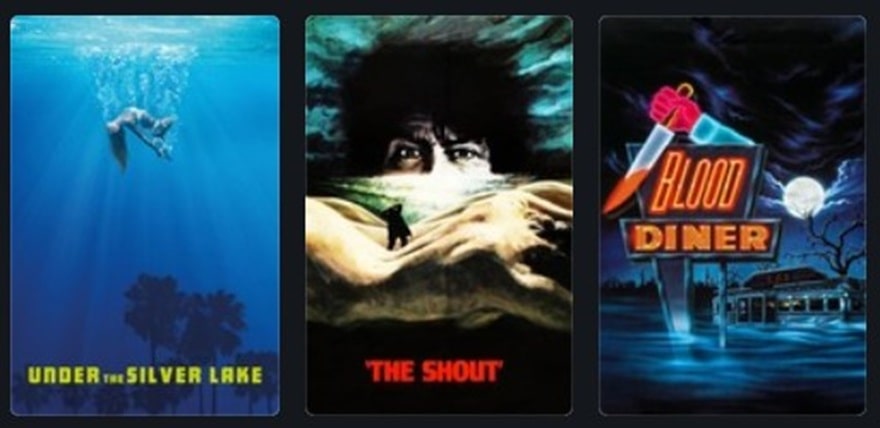 Tubi Dive — The Top Three
Tubi Dive — The Top Three
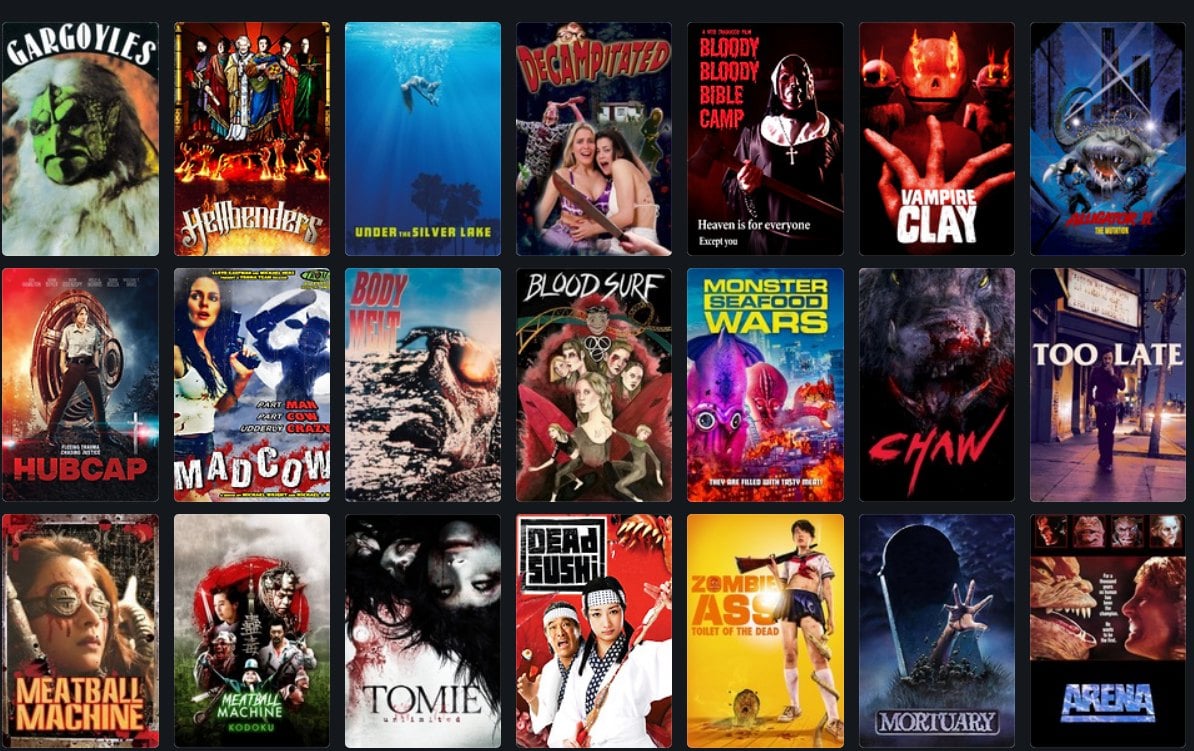 Tubi Dive 1
Tubi Dive 1
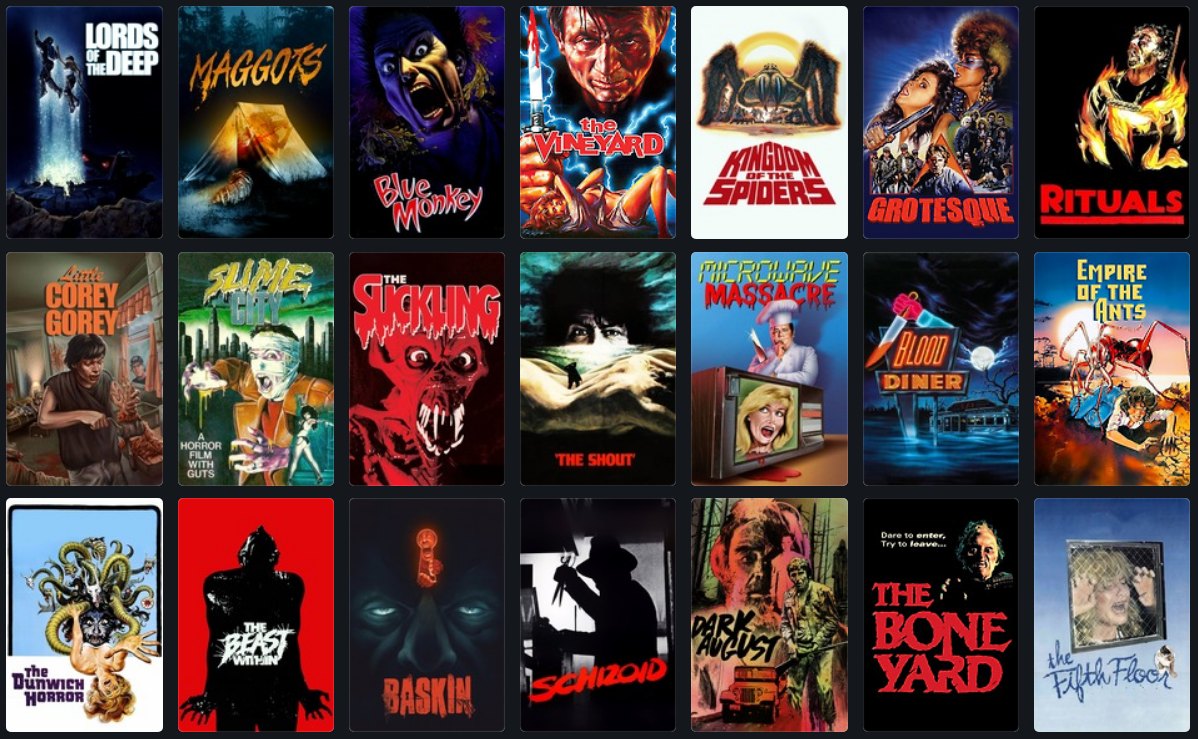 Tubi Dive 2
Tubi Dive 2
 Tubi Dive 3
Tubi Dive 3
Previous Murkey Movie surveys from Neil Baker include:
Tubi Dive, Part I
Tubi Dive, Part II
Tubi Dive, Part III
Tubi Dive, Part IV
Tubi Dive, Part V
Tubi Dive, Part VI
What Possessed You?
Fan of the Cave Bear
There, Wolves
What a Croc
Prehistrionics
Jumping the Shark
Alien Overlords
Biggus Footus
I Like Big Bugs and I Cannot Lie
The Weird, Weird West
Warrior Women Watch-a-thon
Neil Baker’s last article for us was Part VI of Tubi Dive. Neil spends his days watching dodgy movies, most of them terrible, in the hope that you might be inspired to watch them too. He is often asked why he doesn’t watch ‘proper’ films, and he honestly doesn’t have a good answer. He is an author, illustrator, teacher, and sculptor of turtle exhibits. (AprilMoonBooks.com).
Tor Doubles #7: James Tiptree Jr.’s The Girl Who Was Plugged In and Vonda N. McIntyre’s Screwtop
 Cover for Screwtop by Maren
Cover for Screwtop by MarenCover for The Girl Who Was Plugged In by Peter Gudynas
The seventh official volume of the Tor Doubles series offers two stories by women. Although the previous volume offered an excerpt from Gwyneth Jones’ novel Divine Endurance is addition to the selections from Barry B. Longyear and John Kessel, this is the first time women have provided the headlining stories in the series. James Tiptree, Jr.’s The Girl Who Was Plugged In and Vonda McIntyre’s Screwtop, both stories about women whose freedom was curtailed, are collected in this volume. As with the previous novel, this volume also includes an excerpt, in this case a three chapter piece from Ellen Kushner’s Swordspoint.
The Girl Who Was Plugged In was originally published in New Dimensions 3, edited by Robert Silverberg and published by Nelson Doubleday in October, 1973. It was nominated for the Hugo Award and the Nebula Award, winning the former.
James Tiptree, Jr. was a pseudonym for Alice B. Sheldon. Although known to be a pseudonym, it was long assumed that Tiptree was male, and Robert Silverberg, who edited this story before Tiptree’s real identity became known, famously declared “[i]t has been suggested that Tiptree is female, a theory that I find absurd, for there is to me something ineluctably masculine about Tiptree’s writing. The truth of Tiptree’s identity was revealed in 1977. The Girl Who Was Plugged In is the first of three Tiptree stories to be published in the Tor Doubles series.
Reading The Girl Who Was Plugged In in 2025, offers a very different experience from reading it when it was initially published in 1973 or reprinted as part of the Tor Double series in 1989. Although it seems clear that there was a satiric element in this when it was initially published, this it is one of those rare pieces of science fiction which looks prophetic in retrospect. The situation Tiptree described has come, in part, to pass.
Set at an indeterminate point in the future, Tiptree postulates a world in which advertising is illegal. Her story focuses on a young woman named P. Burke, who suffers from pituitary dystrophy, a disease which leaves her disfigured and, as Tiptree makes sure the reader understands, seem like a monster. Following a failed suicide attempt, Burke is placed into essentially a VR chamber and hooked up so she can manipulate a remote body, which becomes known as Delphi.
Delphi is designed to be an attractive woman and work as what we would now call an influencer. Her sole purpose is to be seen, make headlines, and have people wondering what clothing she’s wearing, what products she’s using, and where they might be able to purchase them.
Tiptree’s story is narrated by an unidentified voice who describes the way the world treats Delphi and her adventures mixed with the way the scientists who care for an manipulate P. Burke’s body and inputs. The narrative choice puts a distance between the reader and the characters, which serves to reinforce the isolation P. Burke is in and the faux reality through which Delphi moves, even as she finds herself in a relationship with playboy Paul Isham, who completely misunderstands the situation. As Isham falls in love with the Delphi he perceives, P. Burke, in her isolation chamber, is unable to separate the reality of her situation with the idea that Paul really sees and loves her and she falls in love with him.
Isham realizes something is wrong about the situation and he manages to figure out where the lab P. Burke is being held is located. Despite his failure to comprehend Delphi’s true nature, he attempts to rescue her from the clutches of the scientists who are holding her, resulting in a less than happy ending for nearly all of the story’s characters.
The Girl Who Was Plugged In offers a world of influencers and controllers. Delphi way be the influencer the world sees, but her content is provided by P. Burke, who remains hidden from Delphi’s adoring fans. As the story progresses, the language used to describe P. Burke becomes more and more harsh, removing layer after layer of her humanity. In the end, it is neither the consumer, the influencer, or the reality behind the influencer that benefits from the situation, but rather the powers the set up the situation, making The Girl Who Was Plugged In a cautionary tale for a world that didn’t exist when the story was originally written and published.
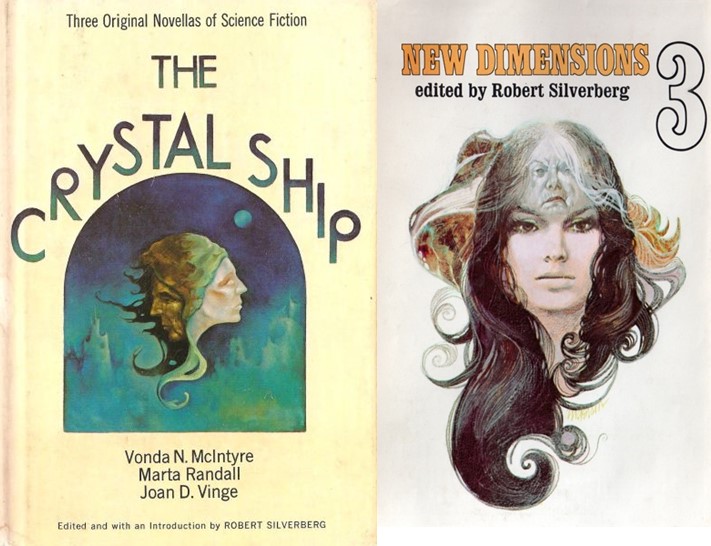 The Crystal Ship cover by Mike Mariano
The Crystal Ship cover by Mike MarianoNew Dimensions cover by Dennis Anderson
Screwtop was originally published in the anthology The Crystal Ship, edited by Robert Silverberg and published by Thomas Nelson in September, 1976.
Kylis is a spaceport rat, essentially a professional interstellar stowaway. A visit to the planet Redsun, however, ended her traveling days as she has been arrested and sentenced to penal labor at the Screwtop prison camp. Kylis strikes up a friendship, and eventually forms a family, with two other prisoners, Gryf and Jason, both of whom appear to be natives of Redsun.
Gryf is the product of tetraparents, a genetically crafted person who has the DNA of four separate parents. Meant to be highly intelligent, a glitch in the combination of DNA meant that he came out with strange coloring that set him apart from people. Gryf was also aware of Jason’s identity as a major philosophical author, which he shared with Kylis, although asking her not to let Jason know that they knew.
Focusing on Kylis, McIntyre depicts the horrors of the work camp. The throuple forced to the schedule set for them by the powers that be, represented in the camp by a guard called the Lizard. When their time allows it, they can seek solace in each other and form a family for themselves. This time almost makes their shifts working bearable.
The work is difficult. Screwtop is located on Redsun’s southern continent, which appears to be an uninhabited wilderness. Their job is to mine for geothermal energy, which is used to power the more massive and populated northern continent, where Gryf, Jason, and the majority of the prisoners are from. Naturally humid and hot, the mining process is even hotter and dangerous if precautions aren’t taken.
Once McIntyre establishes her setting and the characters’ relationships to each other, she is able to more fully explore the dynamics of the prison. Kylis reaches out to another woman prisoner, Miria, in a manner which may cause undue attention to be brought to her group. The Lizard approaches Kylis to extort not only sexual favors, but the implicit desire to have a child by her. The strength and purpose being in a supportive relationship with Gryf and Jason is demonstrated to have negative implications and it can be used against them.
In many ways, Screwtop feels as if it could be a prison story set anywhere, without the need for the science fictional elements. Kylis could merely be a runaway, Jason a dissident, and the workforce a regular mine. However, Gryf’s situation as the product of tetraparents becomes an important plot point. Although not fully explored, partly due to Kylis’s role as a narrator, his science fictional origin and upbringing, and his rebellion against it, focuses the story in him in the later pages as it becomes clear that his parents know of his whereabouts and may have the wherewithal to affect his release. More importantly, his way of dealing with the reality in which he finds himself is based on his unique situation.
Both Screwtop and The Girl Who Plugged In focuses on individuals who are trapped by other people, Kylis has more agency that P. Burke and the relationship Kylis has with Gryf and Jason, although not based entirely on reality of knowledge of the others, is a more authentic relationship than the one between Isham and Delphi. Similarly, McIntyre does not place a distance between the story and the reader by the expedient of having her narrator a participant rather than an observer.
The cover for Screwtop was painted by Maren. The cover for The Girl Who Was Plugged In was painted by Peter Gudynas. At only 136 pages, this volume is the shortest in the Tor Double series.
 Steven H Silver is a twenty-one-time Hugo Award nominee and was the publisher of the Hugo-nominated fanzine Argentus as well as the editor and publisher of ISFiC Press for eight years. He has also edited books for DAW, NESFA Press, and ZNB. His most recent anthology is Alternate Peace and his novel After Hastings was published in 2020. Steven has chaired the first Midwest Construction, Windycon three times, and the SFWA Nebula Conference numerous times. He was programming chair for Chicon 2000 and Vice Chair of Chicon 7.
Steven H Silver is a twenty-one-time Hugo Award nominee and was the publisher of the Hugo-nominated fanzine Argentus as well as the editor and publisher of ISFiC Press for eight years. He has also edited books for DAW, NESFA Press, and ZNB. His most recent anthology is Alternate Peace and his novel After Hastings was published in 2020. Steven has chaired the first Midwest Construction, Windycon three times, and the SFWA Nebula Conference numerous times. He was programming chair for Chicon 2000 and Vice Chair of Chicon 7.
The Suspension Bridges of Disbelief
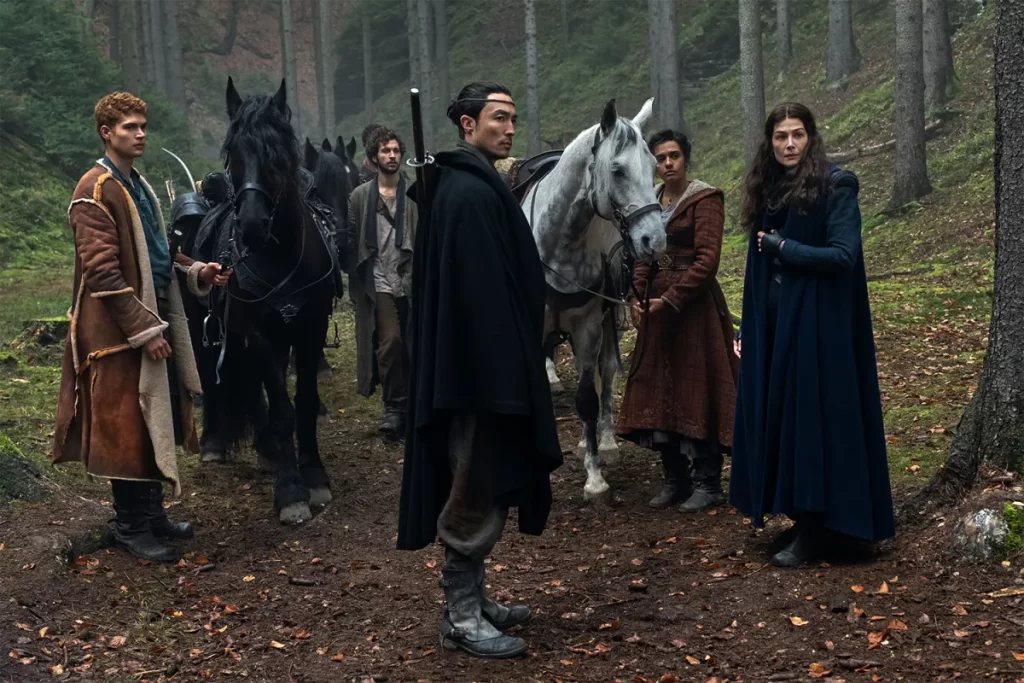 A friend and I have been watching The Wheel of Time adaptation on Amazon. Both of us expressed surprise not at the open casting, which we agree is wonderful, but at how that production choice plays out in small hamlets like Rand al’Thor’s “home town” of Two Rivers. After observing that every possible racial group is represented in this isolated, insular mountain community, my friend had an epiphany.
A friend and I have been watching The Wheel of Time adaptation on Amazon. Both of us expressed surprise not at the open casting, which we agree is wonderful, but at how that production choice plays out in small hamlets like Rand al’Thor’s “home town” of Two Rivers. After observing that every possible racial group is represented in this isolated, insular mountain community, my friend had an epiphany.
“I had to remind myself,” said my friend, “that if I suspend disbelief to accept that there’s magic in this world, then I might also have to suspend my disbelief in genetics.”
But isn’t it curious, how difficult this can be? The addition of magic in the Robert Jordan universe does not imply the generalized suspension of basic science, but the casting choices made in populating the Two Rivers absolutely does. Surely, under normal conditions, a group of people who initially look very different and then happily intermingle and intermarry over several generations would soon produce a population exhibiting mostly blended rather than outlying traits?
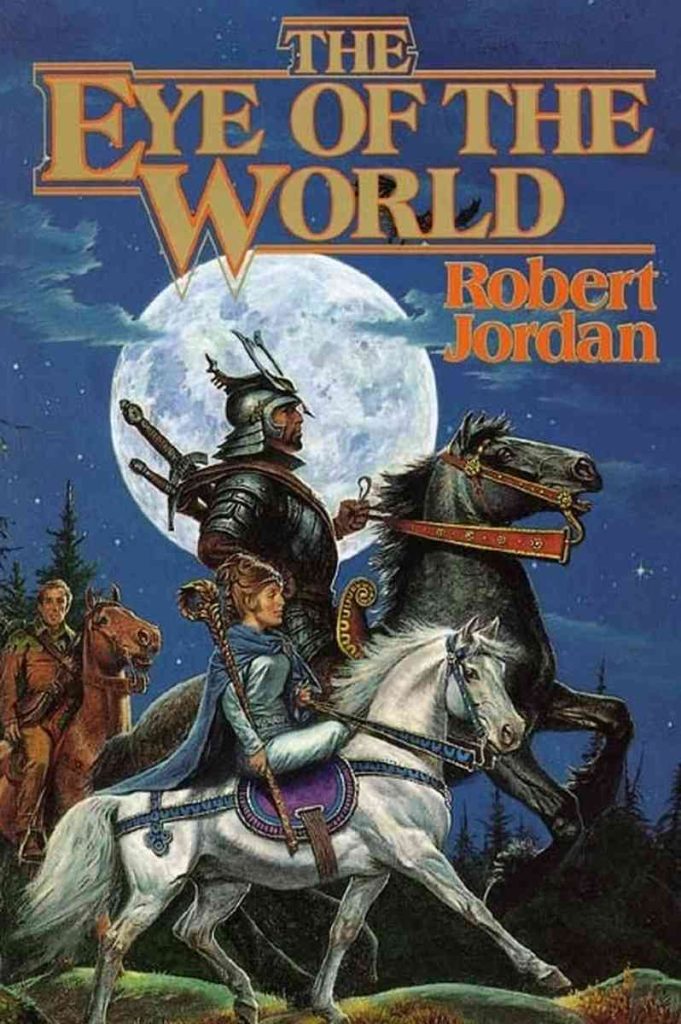 So, if genetics is getting tossed out the window, what’s next? Photosynthesis? The electron constant? Algebra?
So, if genetics is getting tossed out the window, what’s next? Photosynthesis? The electron constant? Algebra?
I once had a housemate who professed a hatred of musicals, both on stage and on film. He explained that he simply couldn’t get around the idea that when people feel a ton of emotion, they break into song. I thought (but did not quite say) that that’s exactly when people are most likely to spontaneously burst into song.
 Pro or con, musicals mark another instance where we either go along for the ride, suspending our disbelief when our heroes start warbling and trilling –– also when a brass band kicks in out of nowhere, playing (let’s say) “Seventy-Six Trombones”––or we cross our arms, huff and puff, and complain that musicals “aren’t realistic.”
Pro or con, musicals mark another instance where we either go along for the ride, suspending our disbelief when our heroes start warbling and trilling –– also when a brass band kicks in out of nowhere, playing (let’s say) “Seventy-Six Trombones”––or we cross our arms, huff and puff, and complain that musicals “aren’t realistic.”
But what is? Howard Shore’s exceptional score for The Lord of the Rings has nothing to do with realism. The Fellowship of the Ring is not accompanied on its journey by a traveling orchestra –– and if it were, wouldn’t we throw up our hands and declare the film to be entirely unbelievable?
 The easiest stunt to pull off when requiring readers or viewers to freeze-frame their disbelief is to offer up only a single element that’s not of this world. Lorrie Moore does exactly this in I Am Homeless if This is Not My Home (winner of the 2023 National Book Critics Circle Award) by asking us to accept that her hero’s deceased ex-girlfriend might want to embark on one final post-mortem road trip, bantering like a boss all the way. Everything else (well, almost everything else) is essentially normal, right down to the tarmac, the songs on the radio, and said girlfriend’s steady rate of decay.
The easiest stunt to pull off when requiring readers or viewers to freeze-frame their disbelief is to offer up only a single element that’s not of this world. Lorrie Moore does exactly this in I Am Homeless if This is Not My Home (winner of the 2023 National Book Critics Circle Award) by asking us to accept that her hero’s deceased ex-girlfriend might want to embark on one final post-mortem road trip, bantering like a boss all the way. Everything else (well, almost everything else) is essentially normal, right down to the tarmac, the songs on the radio, and said girlfriend’s steady rate of decay.
 Sometimes, one encounters a writer who appears to be sticking to the world as it is, but elements of dream or otherness are allowed to intrude, often with unpredictable results. The reader is themselves suspended, learning with every new-turned paged to be watchful, wary of what is real and what is not. Kathleen Jennings takes this approach in Flyaway, where disbelief is not so much suspended as it is actively cultivated. John Crowley’s Little, Big proceeds in much the same fashion.
Sometimes, one encounters a writer who appears to be sticking to the world as it is, but elements of dream or otherness are allowed to intrude, often with unpredictable results. The reader is themselves suspended, learning with every new-turned paged to be watchful, wary of what is real and what is not. Kathleen Jennings takes this approach in Flyaway, where disbelief is not so much suspended as it is actively cultivated. John Crowley’s Little, Big proceeds in much the same fashion.
But in general, suspension of disbelief works best in an additive sense. The story-teller allows for some new power, something that piggy-backs on the world already known. For example, in The Fifth Season, N.K. Jemisin allows for “orogenes” who control stone, a supernatural power built on what we already accept of geology and plate tectonics. Similarly, in Marvel Comics lore, the character known as Storm can control wind and weather –– but her powers depend explicitly on phenomena with which we are already familiar.
 Even the finest works of the fantastic have their awkward moments. In HBO’s Game of Thrones, there’s a scene in which the Onion Knight, Ser Davos Seaworth, breaks young Gendry out of prison and sets him in a rowboat. When Gendry faces the wrong way, Ser Davos asks, “Have you ever been in a boat?” and Gendry answers, “No,” but the very next moment, he’s feathering the oars like a pro. All I can do is shake my head. Rowboats require practice: you’re facing the wrong way while steering, and each oar (long and heavy) functions independently. In the ocean, as Gendry is, every single wave impacts the oars differently. I’m forced to say that, as written, this charming, comic scene swan dives right over the cliff of believability. If poor Gendry has never rowed, all the royal blood in the world won’t help him. He’ll never get past the breakers, much less to the supposed safety of some far and distant shore.
Even the finest works of the fantastic have their awkward moments. In HBO’s Game of Thrones, there’s a scene in which the Onion Knight, Ser Davos Seaworth, breaks young Gendry out of prison and sets him in a rowboat. When Gendry faces the wrong way, Ser Davos asks, “Have you ever been in a boat?” and Gendry answers, “No,” but the very next moment, he’s feathering the oars like a pro. All I can do is shake my head. Rowboats require practice: you’re facing the wrong way while steering, and each oar (long and heavy) functions independently. In the ocean, as Gendry is, every single wave impacts the oars differently. I’m forced to say that, as written, this charming, comic scene swan dives right over the cliff of believability. If poor Gendry has never rowed, all the royal blood in the world won’t help him. He’ll never get past the breakers, much less to the supposed safety of some far and distant shore.
And yet, I’m perfectly happy to believe in three-eyed ravens and the faceless men of Bravos.
 Perhaps the loftiest trick of all in the juggling game of disbelief is to remove some element that we have trouble imagining living without. Gravity, for example. The relative hardness and density of metal. Inertia. Strip away even one those three, and then try writing up a believable sword-fight. Good luck to ya’.
Perhaps the loftiest trick of all in the juggling game of disbelief is to remove some element that we have trouble imagining living without. Gravity, for example. The relative hardness and density of metal. Inertia. Strip away even one those three, and then try writing up a believable sword-fight. Good luck to ya’.
And this, perhaps, is why it is easier, when watching Amazon’s The Wheel of Time, to accept the One Power and way-gates and trollocs than it is to believe in a remote, mountainous outpost where the population covers just about every color of the human rainbow.
Magic, we buy (in part because it’s great fun to do so).
But reality?
Reality bites.
Onward.
Mark Rigney is a writer and long-time Black Gate blogger. His work on this site includes original fiction and perennially popular posts like “Adventures in Spellcraft: Rope Trick.” His new novel, Vinyl Wonderland, dropped on June 25th, 2024. Reviewer Rich Horton said of Vinyl Wonderland, “I was brought to tears, tears I trusted. A lovely work.” His favorite review quote so far comes from Instagram: “Holy crap on a cracker, it’s so good.” A preview post can be found HERE, while his website lives over THERE.
The Lost World
You may have heard about the recent statements made by Netflix CEO Ted Sarandos, a man who combines all the best qualities of Dr. Jack Kevorkian and Alaric the Goth in one natty package. As reported by Variety on April 28th, the streaming mogul declared that the precipitous decline in in-person movie attendance which began several years ago and has reached near-catastrophic proportions in the years following COVID is easily understandable; indeed, it communicates a clear message:
What does that say? What is the consumer trying to tell us? That they’d like to watch movies at home, thank you. The studios and the theaters are duking it out over trying to preserve this 45-day window that is completely out of step with the consumer experience of just loving a movie.
Relegating the theater experience that has defined the industry (to say nothing of wider American culture) for the past nine decades to the dustbin of history, Sarandos shined a dazzling light on our murky cultural landscape:
Folks grew up thinking, I want to make movies on a gigantic screen and have strangers watch them and to have them play in the theater for two months and people cry and sold-out shows… It’s an outdated concept.
Thank you, Ted, for clearing that up for us. I’m sure Scorsese and Coppola and Lee and Tarantino and Bigelow are happy to have the benefit of your sage counsel.
Lustily chomping his cigar and aggressively pounding his fist on the table (okay, I made that part up), the Netflix boss further said that the decline of movie theaters doesn’t “bother” him. He would be bothered, he added, if “people stop making great movies.”
Now I’ve seen the typical Netflix product, and you’ll forgive me if I think that Mr. Sarandos wouldn’t know a great movie if Bette Davis walked up with one in a steel film can and broke his nose with it.
 Fasten your seat belt, Ted — it’s going to be a bumpy night!
Fasten your seat belt, Ted — it’s going to be a bumpy night!
If you sense a certain bitterness in my remarks, you’re right, and that sourness stems less from my distaste for Mr. Sarandos and his cavalier attitude towards something that I love than from my suspicion that he’s right, damn it. Much as I might regret it, it does appear that the kind of moviegoing experience that many of us have taken for granted for our entire lives is rapidly — and probably irrecoverably — becoming a thing of the past.
Some hard-hearted realists might say that mourning the decline of moviegoing (as in actually going to the movies) is as silly, pointless, and socially and economically regressive as bemoaning the fact that the buggy-whip industry isn’t what it used to be.
As a practical matter, that might be so, but I still feel entitled to mourn the loss. Why?
To be moved, whether you are frightened or thrilled, brought to tears or to laughter, is an experience that you can certainly have in your living room, alone or with one or two other people, but that’s a fundamentally different experience than feeling those same emotions in a room filled with many other people, in a place dedicated (I almost said consecrated) to undistractedly watching the movie and nothing else, a unique space where no one (ideally) is chatting, looking at their phone, constantly moving around the room, or pausing the action while they stroll to the bathroom or go to the door to get the Grubhub order.
The darkness, the size of the space and the close physical proximity of so many other people, the scale of the screen and the depth of the sound, the sustained, even relentless nature of the experience (to say nothing of the fact that because you’re leaving the house to do it, it’s something that actually requires a degree of planning), and yes, the cash outlay — even if the movie itself is a negligible piece of fluff, these factors all combine to make the in-person experience itself larger and more weighty.
Of course, every difference I just mentioned is, for an increasing number of people, a bug and not a feature. In that, Ted Sarandos is right. More and more people do seem to prefer streaming at home over the older way of seeing movies. I know, I know, who has the time anymore? Who has the money? And what about the kids? Anyway, how many movies are good enough to warrant going through all the hassle?
I can’t argue with any of these objections; I feel their force myself. And yet I think we’re going to lose something precious if going to the movies becomes some sort of boutique experience limited to a few large urban areas. Sarandros himself pointed to this as a likely future, saying, “If you’re fortunate enough to live in Manhattan, and you can walk to a multiplex and see a movie, that’s fantastic. Most of the country cannot.” (I don’t know where Ted lives, but apparently he pictures the rest of the country as some sort of vast Hooterville where people wander among the cornstalks, desperate for entertainment.)
The “concept” dismissed as “outdated” by Ted Sarandos has played a major part in my life ever since I can remember. My parents loved movies and “going to the show” was one of my commonest experiences growing up; we literally did it all the time, and I continued to go on my own or with friends as I got older. I have countless memories connected with seeing movies in actual theaters or at the drive-in, and the record of my moviegoing forms a kind of alternate history of my life; it’s probably the same with you. Here are a few of my random moviegoing memories, and they’re all the more powerful because they’re not just mine; they’re collective memories shared in one way or another with the hundreds of people who were with me in the theater at those moments, and with the millions who experienced the same feelings when they saw the same movies in their own hometown theaters.
(You will notice that all of these movies are from the 60’s and 70’s. I have had memorable theater experiences in just about every decade of my life — Dead Ringers, anyone? — but these came to my mind first. Given my topic, it’s probably no surprise that I’m feeling excessively nostalgic right now.)
Summer, 1975. On vacation, visiting my cousins in Texas, we went to see something called Jaws. American movies and culture would never be the same. The shriek of delighted terror and terrified delight that burst from my fourteen-year-old mouth when that corpse’s head popped out of the submerged boat and scared the bejeezus out of Richard Dreyfuss, and me, and all the people surrounding me… well, I didn’t even hear myself, because my ears were too busy ringing from the identical sound that had just come from everyone else.
Quentin Tarantino has said that Jaws is the greatest movie (as opposed to the greatest film) ever made, because it delivers all those quintessential screaming/laughing movie pleasures more perfectly than anything else that’s ever been on the screen. If you were there in 1975, you can only agree with him.
Spring, 1979. My buddy Eddy’s mom said she would take us to the show to see a horror movie. She loved horror movies; she had already taken us to the drive-in to see The Brood and The Corpse Grinders. That’s what I call a great mom. When my mom (also a great mom) heard that Ruth was going, she said that she would join us. I told her that she really didn’t want to do that; the movie we were going to see was called Dawn of the Dead and it was not a Vincent Price campfest, which was what she was expecting from a horror movie. “You don’t understand, Mom — this movie has zombies that eat people!” She tsk-tsked me and insisted on coming along.
Five minutes in, in an apartment building infested with the living dead, a woman spots the shambling corpse of her husband; she runs up to him and embraces him, whereupon he takes a huge bite out of her neck as the blood gushes by the gallon. That woman was no more shocked than my mom, who grabbed her purse, stood up, and walked out of the theater. “I told you!” I shouted as she exited.
Spring, 1968. My mom gave me a day off from school. Why? She was going to drive me into Los Angeles so we could see 2001: A Space Odyssey at the fabled Cinerama Dome. (I told you she was a great mom.) She had told my teacher the day before that it would be “very educational.” The enormous curved Cinerama screen, the eye-popping special effects and overwhelming sound, the rapt enthrallment and utter bafflement of the audience — it has all stayed with me to this day.
As stunned people stood around on the sidewalk afterwards, there was a steady chorus of “What does it mean? Do you know what it means?” “I know what it means!” I recklessly piped up. As all those pairs of adult eyes focused on my seven-year-old self, I realized that I should have kept my big mouth shut. I didn’t know what the movie meant; I only knew that I had just had one of the greatest days of my life, and that I loved my mom.
Fall, 1979. At the Cinerama Dome again, my friend Sutton and I arrived at the last moment to see one of the first showings of Apocalypse Now, and the only seats left were in the first couple of rows. The Dome’s screen was eighty-six feet wide and thirty-two feet high; from our seats, it was like crouching at the foot of Mont Blanc. When the movie opened with a napalm strike, I felt like every millimeter of my optic nerves were on fire, and during the “Ride of the Valkyries” helicopter strike I crouched in my seat to keep from being eviscerated by a mortar round or decapitated by a helicopter blade, and I knew that everyone else in the theater was doing the same thing, even those who had more rational seats than we did (I told Sutton we should have left home earlier).
Every person in the audience knew that they were seeing something beyond the realm of the normal; we were witnesses to an outrageous, crazily ambitious, magnificent once-in-a-lifetime folly that no one there would ever forget. It was probably my supreme experience at the movies, and it wouldn’t surprise me if a lot of the people who were there that night almost forty-six years ago look back and think about it that way too.
One more. Fall, 1977. The movie is, believe it or not, Race for Your Life, Charlie Brown! This time Sutton and I left in plenty of time to get decent seats, and anyway, we didn’t have to drive as far to get to the theater. (The Cinerama Dome usually didn’t book Charlie Brown movies.) We had a Saturday with nothing to do and the only thing showing was this Peanuts movie. Well, why not? The theater was full to overflowing with kids — I didn’t see an adult in sight. We two high-school boys were apparently the oldest people present. Clearly this mediocre cartoon was a golden opportunity for parents to dump their spawn for a couple of hours and have a little time for… well, other stuff.
Things held fairly steady until the lights went down, and then pandemonium reigned. You’ve read Lord of the Flies? It was like that. The air was instantly full of flying popcorn boxes and other trash, and the soundtrack was drowned out by an insane cacophony of laughs, shrieks, yells, catcalls, arguments, profanities. You couldn’t see the movie; you couldn’t hear the movie. The aisles were filled with kids running up and down, falling, rolling, jumping, kicking, crashing. One kid sitting several rows forward took umbrage at something the urchin sitting directly in front of us said or did and came flying from his seat, and jumping astride the offender, pinned him in place and started whaling on him as the surrounding kids cheered; it was like having a ringside seat at Ali-Foreman. We were too stunned to intervene (others quickly did), and we bolted for freedom as soon as the final credits rolled, happy to escape with our lives, but I have never forgotten that kiddie matinee; it permanently darkened my view of human nature and blighted my belief in the possibility of building anything lastingly good in this world. And all it cost me was, what? Two bucks and a little gas money? Now that’s what I call a bargain.
Beat that, Ted Sarandos.
Thomas Parker is a native Southern Californian and a lifelong science fiction, fantasy, and mystery fan. When not corrupting the next generation as a fourth grade teacher, he collects Roger Corman movies, Silver Age comic books, Ace doubles, and despairing looks from his wife. His last article for us was Writ in Water: V.E. Schwab’s The Invisible Life of Addie LaRue
Get it While You Can: Manly Wade Wellman’s Cahena Going Out of Print
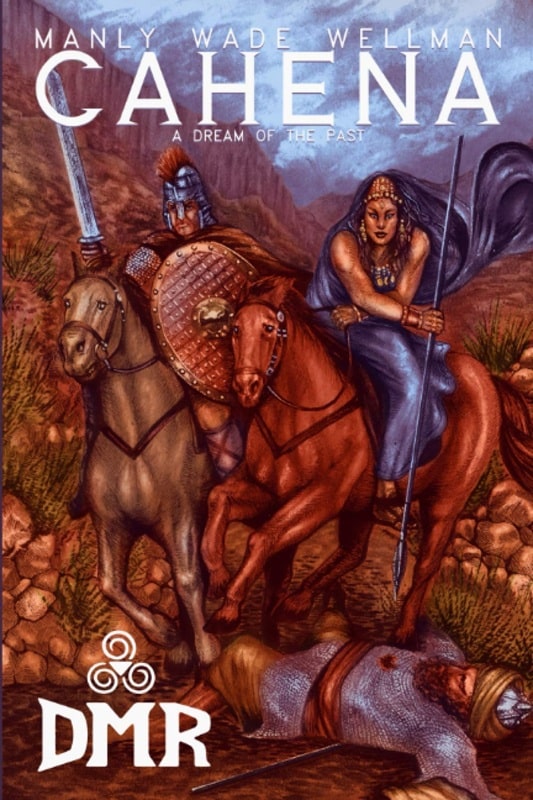

Cahena by Manly Wade Wellman (DMR Books, November 1, 2020). Cover by Lauren Gornik
I’m hearing reports that Manly Wade Wellman’s final novel Cahena, out of print for nearly 35 years until DMR released a handsome new edition in 2020 with a striking cover by Lauren Gornik, is on the verge of going out of print again.
Cahena is an overlooked gem in Wellman’s distinguished catalog. A historical novel with fantasy elements, it tells the tale of the legendary Berber queen who lived in the 7th Century in North Africa, and led her people against the Romans and later Muslim invaders. The Cahena, as she was known, was said to be both a sorceress and prophetess, and she led an army forty thousand strong in a valiant struggle to save her beleaguered people.
DMR’s rights to the book expire this month, and at the end of May it will not longer be available. Morgan Holmes says that with this final novel, “Wellman went out on top.” If you’re a Wellman fan, or a fan of quality adventure fiction, grab a copy while you can. Don’t wait another thirty-five years for the next reprint! Order directly from DMR Books here.
The Writer and the Boycott
 Image by Niek Verlaan from Pixabay
Image by Niek Verlaan from Pixabay
Good afterevenmorn!
Well, I’m talking boycotts again, as there is a lot of it going around. And they are absolutely kicking up all kinds of dust. This is great – making your voice heard with the only thing these companies seem to understand; their bottom lines. It’s not so great if you’re an innocent writer just trying to make a living who happens to be caught in the crossfire.
Some few writers like myself are trying to divest from unethical companies (I’m not going to name them, but we all know, right?). But we are quite few, and it’s only, at least in my case, quite a light boycott. My books are still available on sites I’d rather no be on, as I want to offer something for those readers who have no choice but to use that site. That’s the unfortunate thing a near monopolies like this. Some folks have no other option. I do have my books available in other places, too, and encourage folks to buy there instead if they can.
It is an unfortunate truth that writers are largely stuck with these behemoth companies. Many self-published or small press authors make (or made) quite a decent living selling through these companies, sometimes exclusively. Good for them, honestly. That’s great! Less great now, however. Buyers, you see, are also boycotting these large companies. And that spells trouble for writers.
 Image by Лариса Мозговая from Pixabay
Image by Лариса Мозговая from Pixabay
I’ve seen more than one post on social media of writers reminding readers that these big companies don’t really feel their absence, but we writers absolutely do. And they’re not wrong. When people stop buying books from one of the largest sellers of books, the folks who depend on that site to sell feel it first and hardest.
It’s not a an easy spot to be in. I’m incredibly proud of everyone who are now putting their feet down and refusing to give money to sites, and the people behind these sites who are actively making the world a harder place to be in. I’m also feeling for those who were making their livings by selling on the very sites that people are actively avoiding. It’s a tough situation all around.
 Image by PDPics from Pixabay
Image by PDPics from Pixabay
Before we go on, I do want to make a giant caveat to what I’m about to say next. I don’t make a living selling books on these sites. I don’t make a living selling books period. I’m a terrible marketer, and perhaps a mediocre writer, so I don’t make a living selling books. I’d really like to, and perhaps one day I’ll get there, but I do not currently. I work full time and am scraping by without having to rely on book sales. Everything I say here will probably feel hollow for those who are currently suffering for those who are caught in this fight.
With that said, I remain firmly on the side of the boycotters. I am also boycotting as much as I can. Book purchases are now made at the bookstore nearest me. It’s not always convenient, but a half hour walk to the shop is something that I’m willing to do in order to avoid using these sites. I don’t think readers should be guilted into abandoning their causes. I do think it’s up to us as writers to try and adapt to the changing landscape. There are a couple of ways to do this. Probably more, but if I do more than two, I’ll be writing this forever.
 Do not put all your eggs in one basket.
Do not put all your eggs in one basket.Image by Gerald Friedrich from Pixabay
The most important thing I think writers can do currently is diversify
Some sites have huge incentives for exclusivity. Make them the only site your book can be purchases or read from, and you get a bigger cut of the profits. It can be incredibly enticing. If possibly, avoid that temptation and put your books up on multiple sites – including your own. There are a lot of ways to create an online shop and start selling direct. It does require a lot more marketing work, as discoverability is a huge issue here.
But I do know book shoppers often are exposed to the marketing of these big sites, and then go hunting to see if the author is selling direct. This is especially since folks are being much more selective about where they source their goods and with whom they spend their money.
There is a further downside, and that is how bestsellers are counted. Personal sales don’t usually count towards the numbers. But if you care more about earning a living than making lists, then it’s not that much of an issue.
Plus there are other bookselling sites where you can sell, and those numbers will count.

Another thing to consider is a subscription model. This isn’t instead of diversifying, but in addition to. For those who are unaware of what this model means, essentially, that people will pay a small amount monthly in exchange for some exclusive content. There are quite a few companies that offer this service (for a cut, of course). The two big ones that I’m aware of are Patreon and Ko-Fi.
For both of these sites, you can set the monthly amount, and even charge different amounts for increasingly awesome exclusive stuff. This tiered subscription can be set to whatever amounts you wish. I know some folks who have subscription tiers at $20.00 a month or more. If you like, you can limit the number of those subscriptions, so you’re not spending all your time trying to fulfill your subscription obligations instead of writing. So perhaps you have a tier at $50.00, in which you provide a monthly handwritten letter, and an automatic awesome loot box with every book release a month, but only two slots for that tier. So you don’t end up spending a tonne of money and time getting those book boxes together and writing letters. The great thing about this is that you can structure it whatever way you want.
I have a Ko-Fi page (obligatory link here. That felt icky. Let’s move swiftly on). I chose it because they also offer an online shop, which has the option of selling to the general public or to one or more of your subscription tiers exclusively, and even an option to accept commissions if you want.
I am very limited on time and ability, as I work full time, so I know I don’t have a lot of time to create for my subscribers. For that reason, I’ve set the monthly amount very low ($1.00), and have only one tier. Subscribers get exclusive blog posts. They will be the only ones able to purchase the special editions of my books, when I get the time to create them (a special edition of The Dying God & Other Stories is currently in the works, with a subscriber exclusive cover and five all new full-colour illustrations). They also have first read of any of the serials I write. They were the first to read The New Haven Incident, and will be the first to read The Bear when I’ve finished writing it. They also get free recipes when I make something I feel is worth sharing. And I’m aiming to offer them free calendar print-outs with original artwork each year. It’s not much, because I cannot yet abandon the office job. Perhaps one day I will be able to, and I can start offering more to my subscribers.
I really like the functionality of Ko-Fi, and now use it as my shop, saving me the costs of hosting my own on my website. Other people choose Patreon because it has other features they find more convenient. I am a fan of being able to set a post as exclusive for a time period of your choosing before it becomes public. You have to do that manually on Ko-Fi.
 Image by christian schwartz from Pixabay
Image by christian schwartz from Pixabay
This isn’t to say that doing either of these things will go well for a writer. I am evidence of that. I don’t sell many books, and I don’t have many subscribers. Fortunate, then, I have full-time work, or I’d be in real trouble. I know that not everyone is fortunate enough to be in that position.
It’s a difficult journey, this writing thing, and should not be embarked on lightly. Boycotts are not making it any easier. We must muddle through as best we can in the weird, unstable world we find ourselves in. The important thing is not to give up. We need stories, perhaps now more than ever. So keep trying to find your way through. I’m here cheering you on. We can do it.
When S.M. Carrière isn’t brutally killing your favorite characters, she spends her time teaching martial arts, live streaming video games, and cuddling her cat. In other words, she spends her time teaching others to kill, streaming her digital kills, and a cuddling furry murderer. Her most recent titles include Daughters of Britain, Skylark and Human. Her serial The New Haven Incident is free and goes up every Friday on her blog.

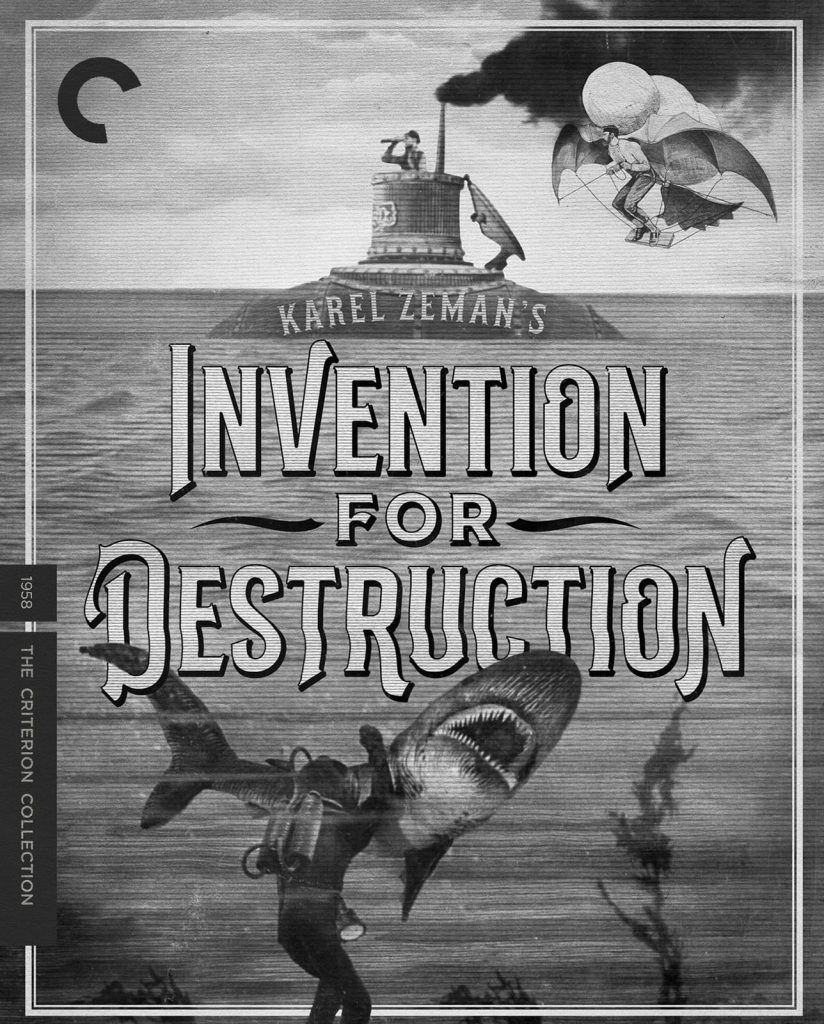
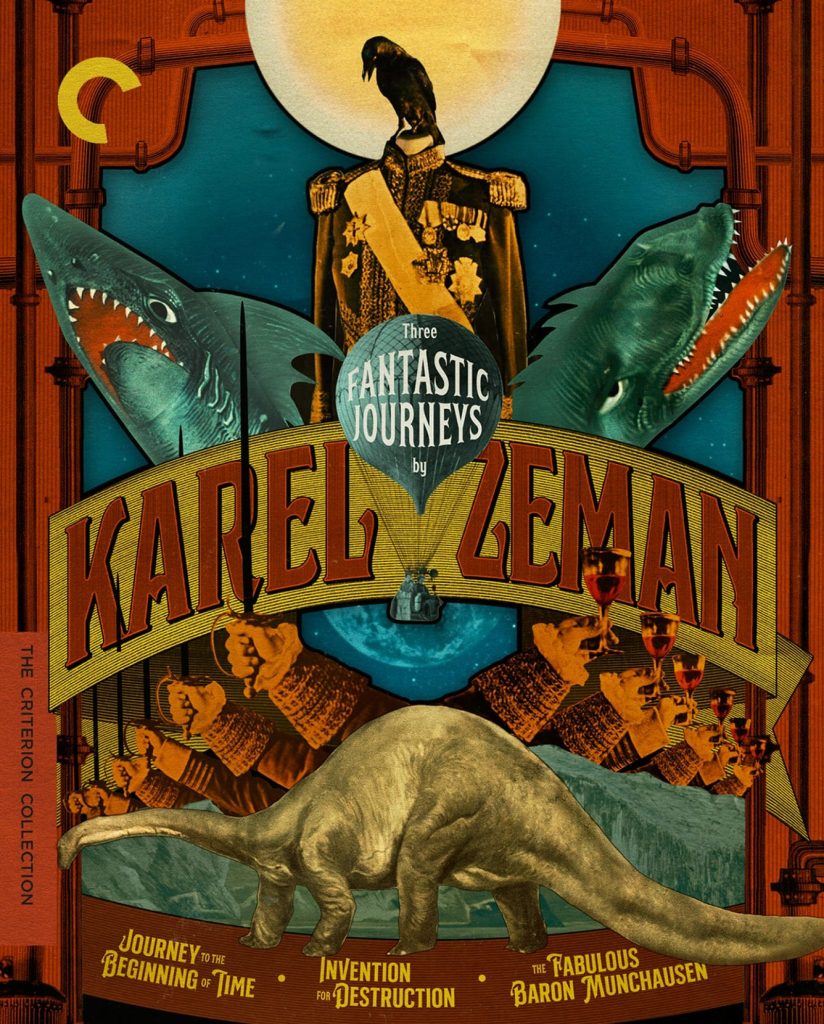
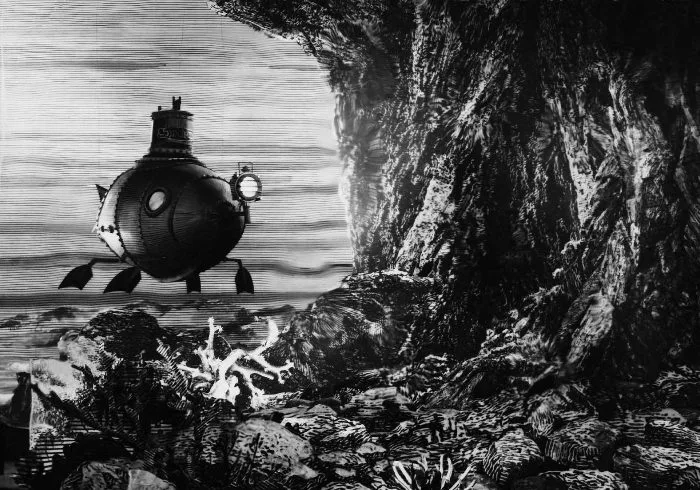
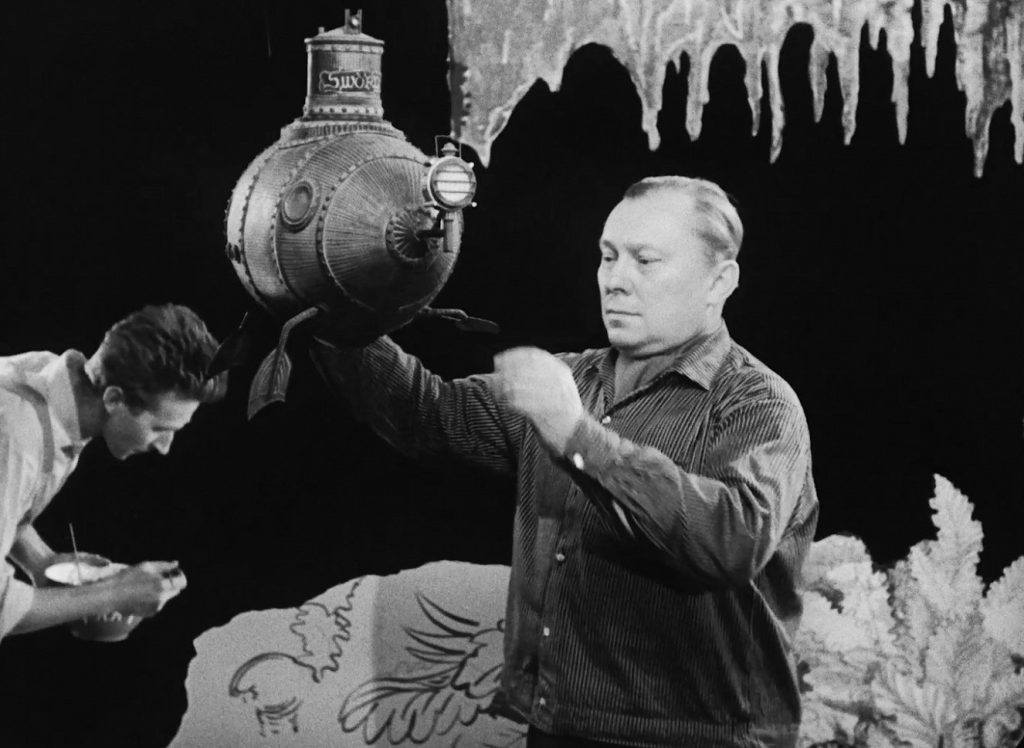
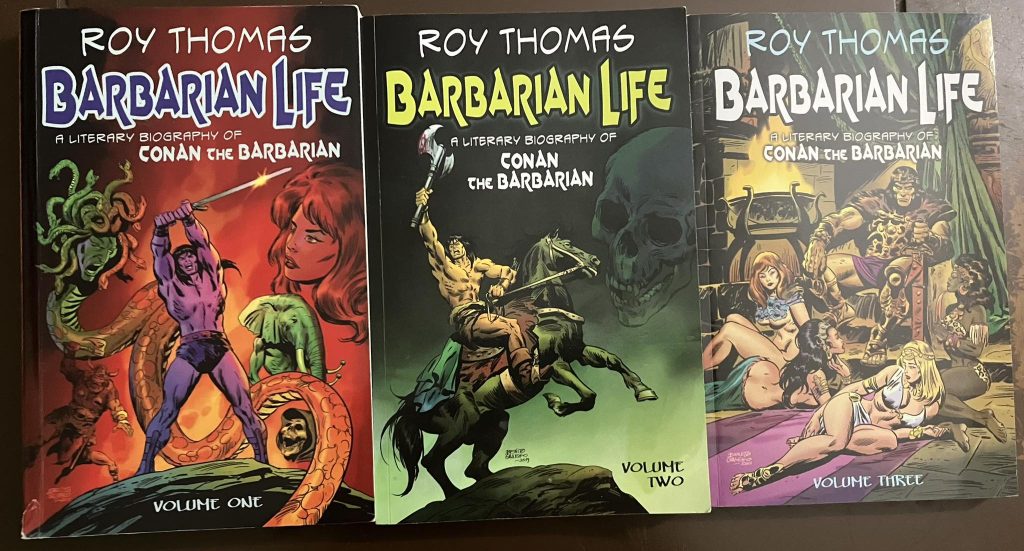
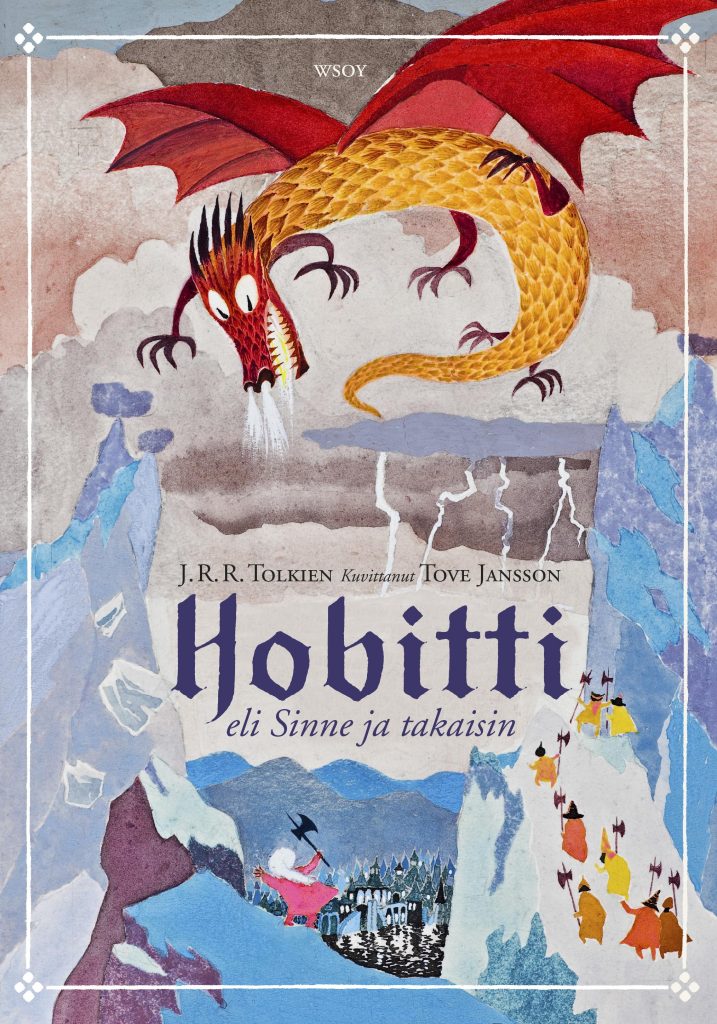






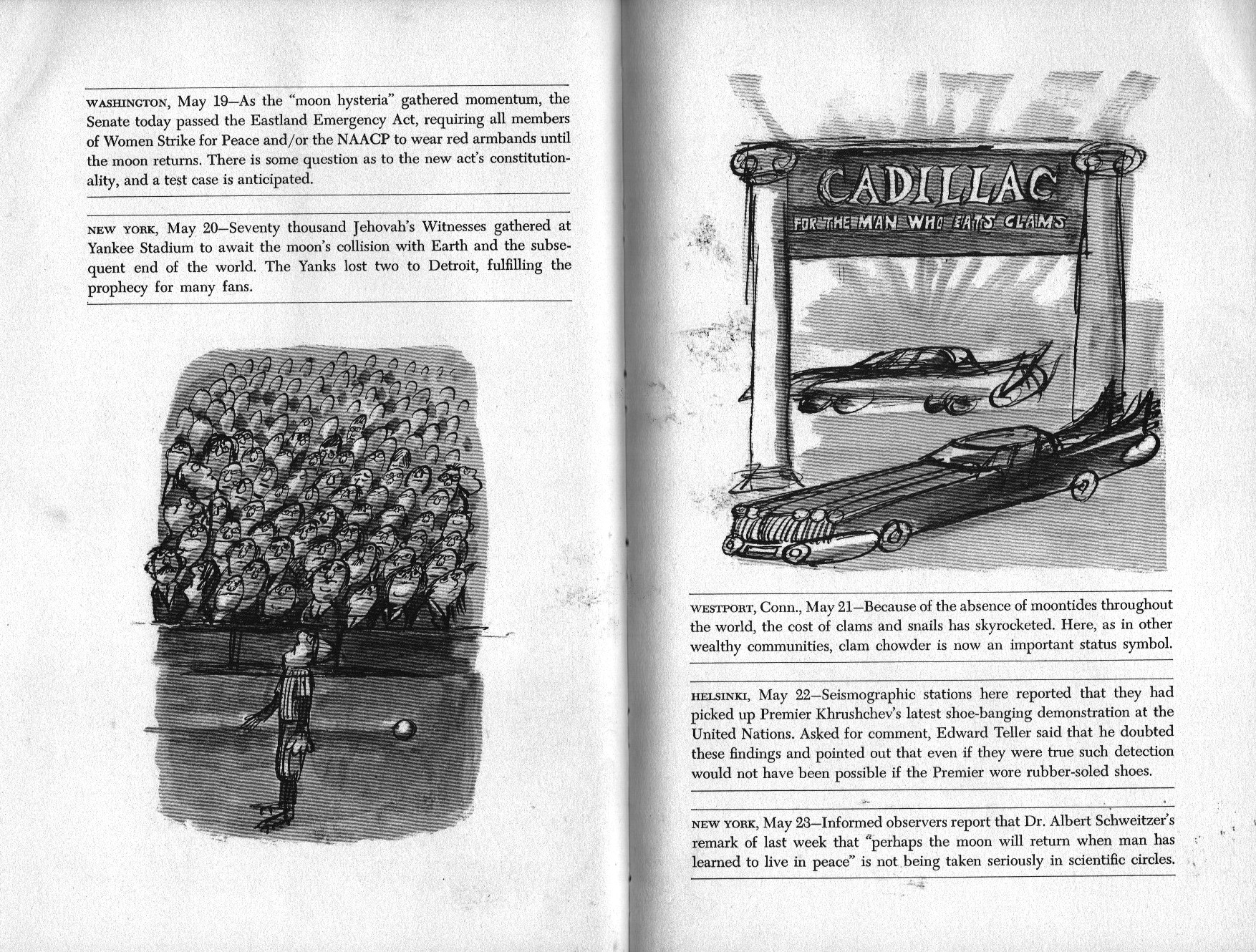
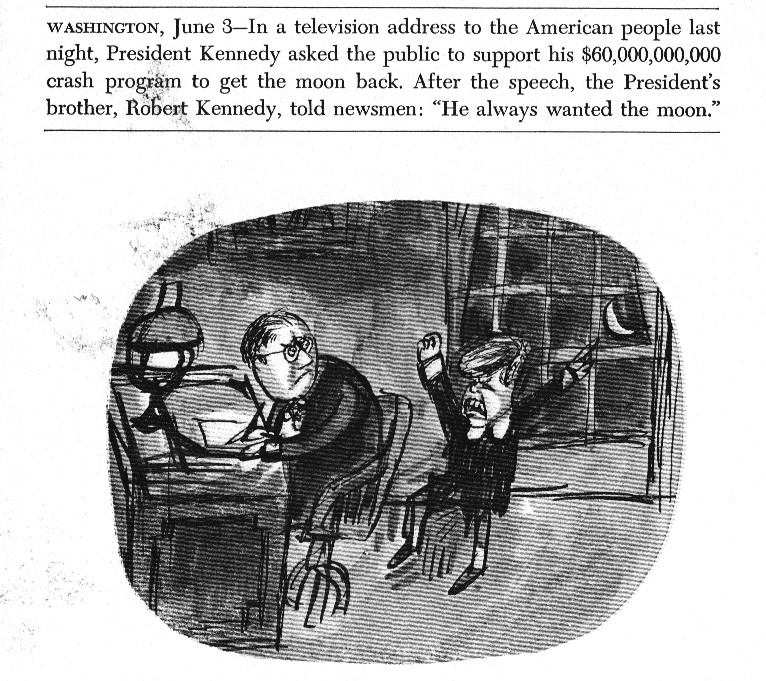
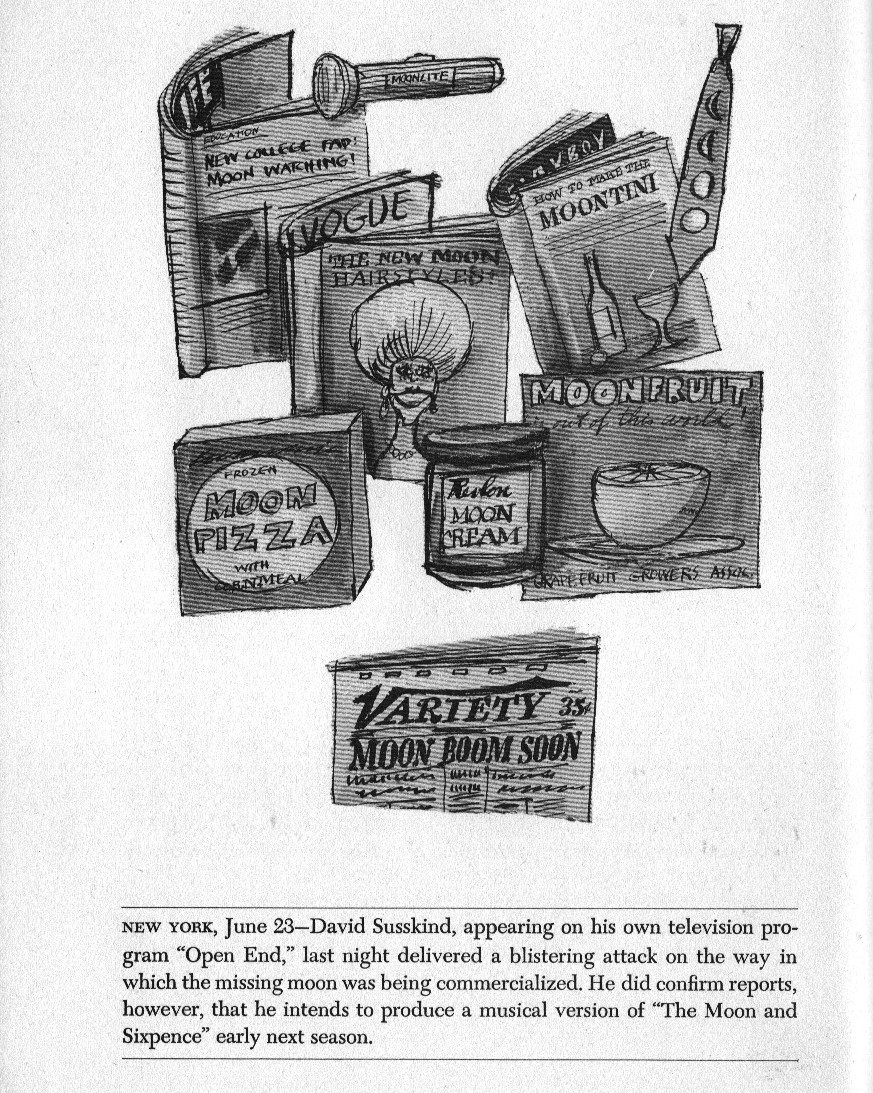
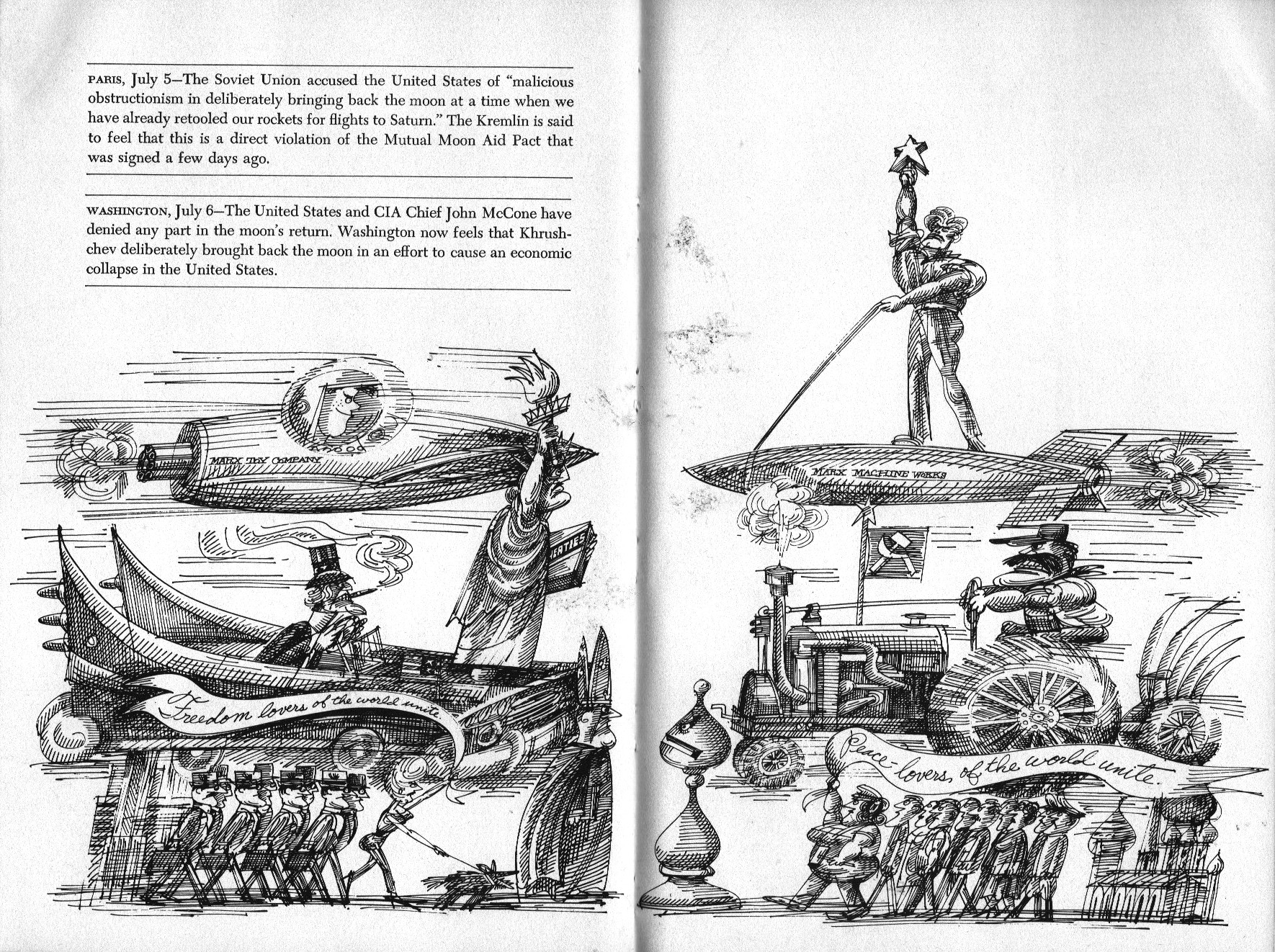
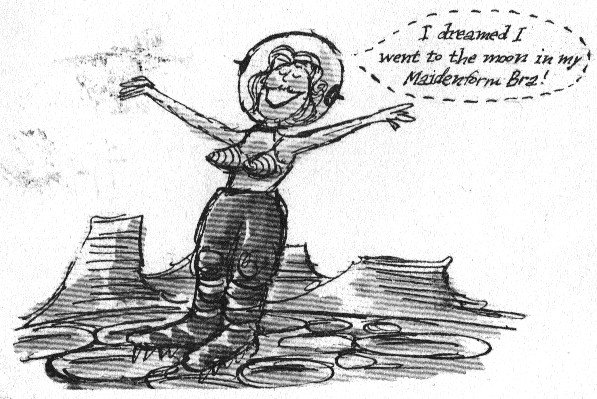



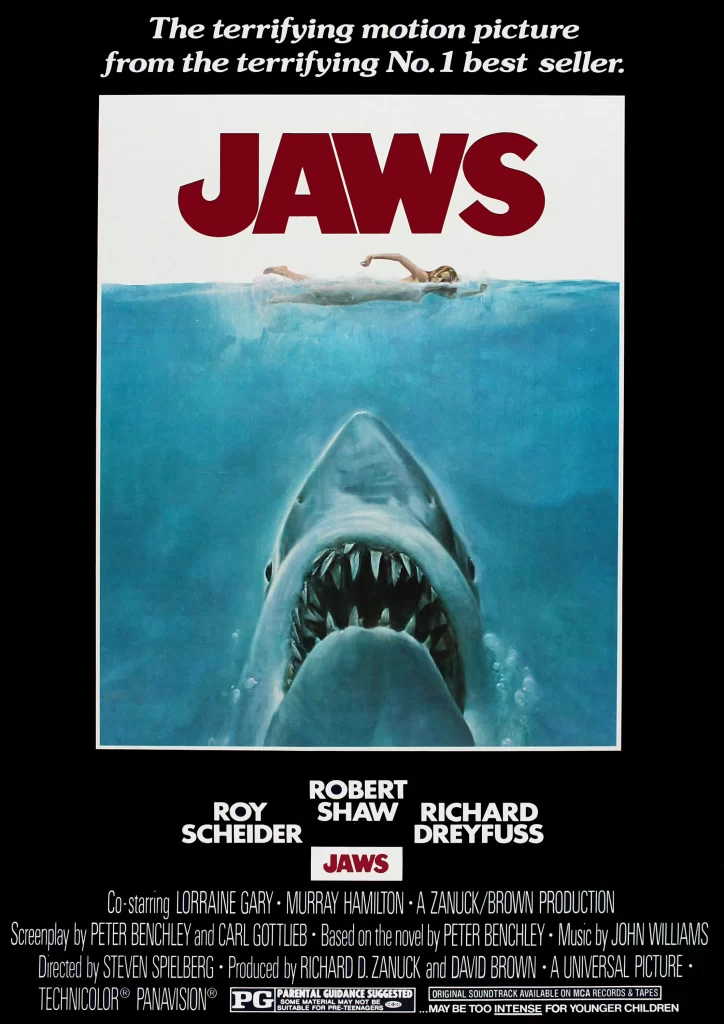
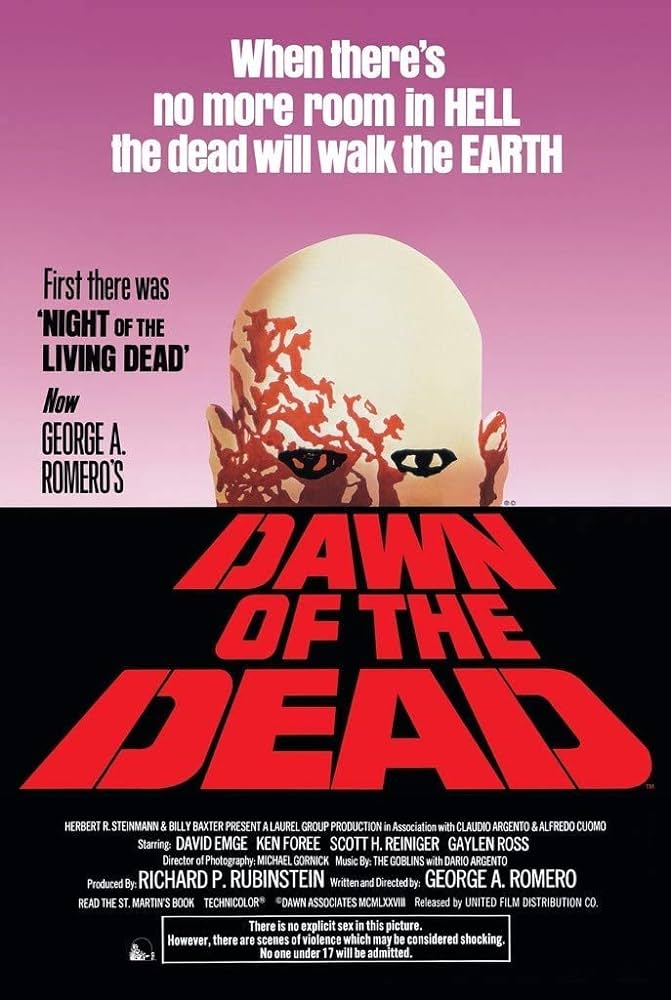
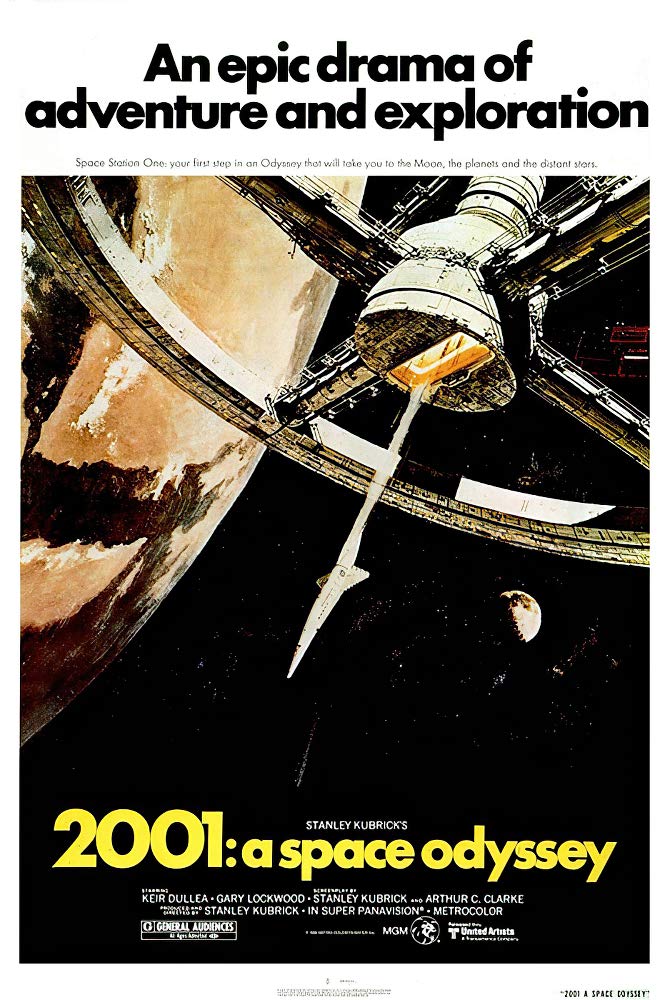
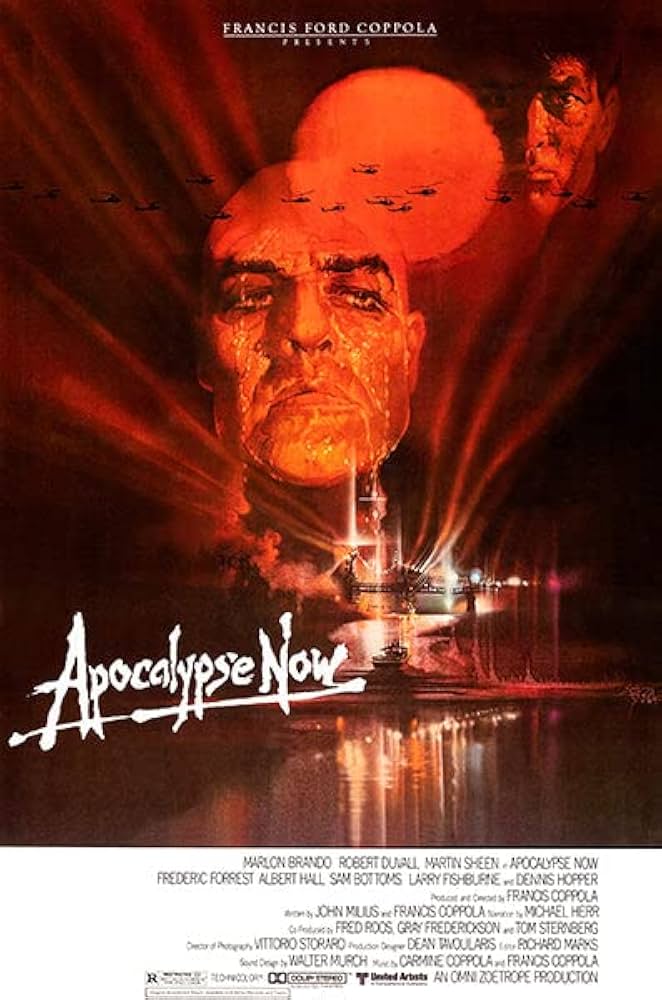
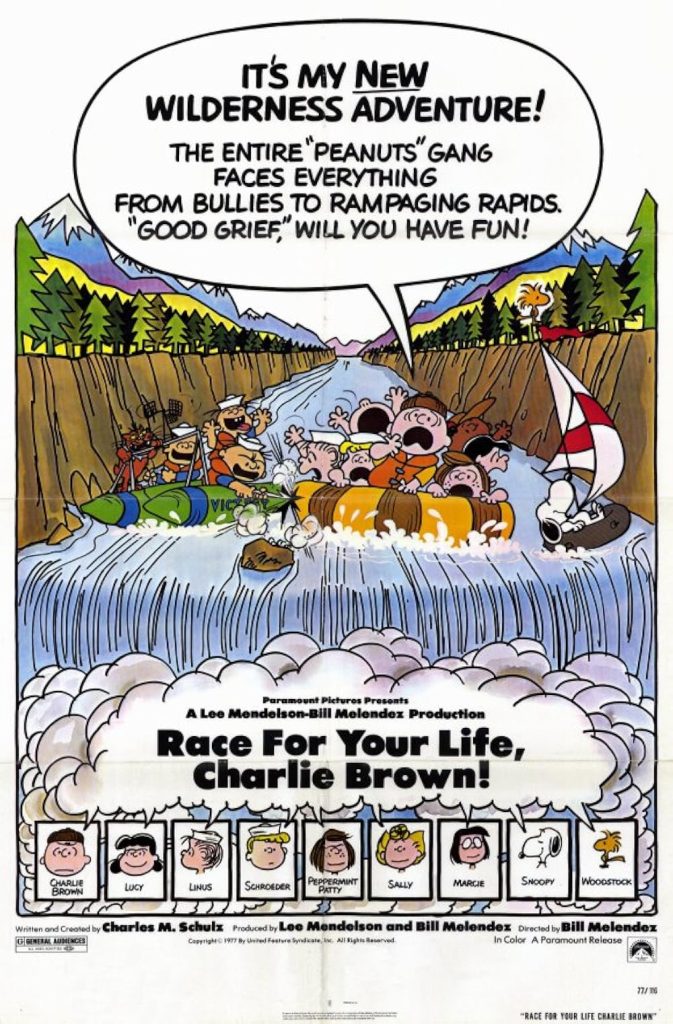

Recent comments